 Sandbag Load - Basic
Sandbag Load - Basic
Benefits: This exercise involves many other muscles.
Purpose: This exercise builds overall strength in the lower body.
Lower Back Glutes Hamstrings Calves Quads Forearms Lats Middle Back Traps Strength Sandbag Pull Compound Gym
General Info: The muscles of the lower back straighten the spine. They work together with the abdominals to keep the spine upright. The Barbell Deadlift is considered to be the king of exercises. No other exercise will work your body so much.
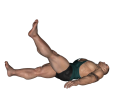 Scissor Kick - Fundamental
Scissor Kick - Fundamental
Benefits: This exercise will assist in giving you strong abdominals.
Purpose: This exercise provides flexibility and mobility of the hamstrings.
Beginner Abdominals Hip Flexors Strength Body Only Gym Home
General Info: The abs can be divided into the abdominals themselves and the obliques. The obliques are the outer abs and are used in twisting movements. For the sake of exercising, the abdominals are sometimes divided into upper abs and lower abs (this is not a technical division but something for exercising). Both upper and lower abs are used in straight line ab exercises while the upper abs are also involved in twisting movements.
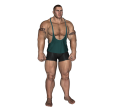 Shoulder Circles - Fundamental
Shoulder Circles - Fundamental
Benefits: This exercise tones and tightens your shoulders.
Purpose: This exercise focuses on working the entire shoulder joint and makes an excellent warm-up before any resistance or weigh training involving the shoulders.
Beginner Shoulders Traps Stretching Body Only Gym Home
General Info: Shoulder Circles require little time, yet can give good benefits when done regularly. They can be done almost anywhere, without special equipment. The three heads of the deltoid muscles require regular movement to ensure their flexibility and mobility.
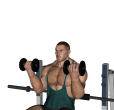 Shoulder Press - Arnold Dumbbell
Shoulder Press - Arnold Dumbbell
Benefits: The press is a highly effective compound upper-body exercise.
Purpose: Shoulder presses are good exercises for building up and strengthening the shoulder region. The Arnold Shoulder Press is an excellent intermediate alternative to the standard shoulder press.
Intermediate Shoulders Forearms Triceps Strength Dumbbell Flat Bench Push Compound Gym
General Info: The deltoid is a fan-shaped muscle. The Anterior (front) deltoid raises the arm toward the front of the body and rotates the arm inward. The Lateral (side) deltoid raises the arm to the side. The Posterior (rear) deltoid raises the arm toward the rear and rotates the arm outward. This exercise was created by bodybuilder Arnold Schwarzenegger and hits both the medial and front heads of deltoids.
 Shoulder Press - Arnold Water Bottle
Shoulder Press - Arnold Water Bottle
Benefits: The press is a highly effective compound upper-body exercise.
Purpose: Shoulder presses are good exercises for building up and strengthening the shoulder region. The Arnold Shoulder Press is an excellent intermediate alternative to the standard shoulder press.
Intermediate Shoulders Forearms Triceps Strength Water Bottle Chair Push Compound Home
General Info: The deltoids is a fan-shaped muscle. The Anterior (front) deltoid raises the arm toward the front of the body and rotates the arm inward. The Lateral (side) deltoid raises the arm to the side. The Posterior (rear) deltoid raises the arm toward the rear and rotates the arm outward. This exercise was created by bodybuilder Arnold Schwarzenegger and hits both the medial and front heads of deltoids.
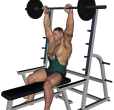 Shoulder Press - Barbell
Shoulder Press - Barbell
Benefits: The press is a highly effective compound upper-body exercise.
Purpose: The Barbell Shoulder Press (sometimes called the Military Press) is a good exercise for building up and strengthening the shoulder region.
Intermediate Shoulders Triceps Chest Strength Barbell Military Press Chair Push Compound Gym
General Info: The Deltoids is a fan-shaped muscle. The Anterior (Front) Deltoid raises the arm toward the front of the body and rotates the arm inward. The Lateral (Side) Deltoid raises the arm to the side. The Posterior (Rear) Deltoid raises the arm toward the rear and rotates the arm outward.
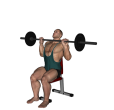 Shoulder Press - Bradford Rocky
Shoulder Press - Bradford Rocky
Benefits: The press is a highly effective compound upper-body exercise.
Purpose: The Military Press is a good exercise for building up and strengthening the shoulder region.
Intermediate Shoulders Triceps Chest Strength Barbell Push Compound Gym
General Info: The Deltoids is a fan-shaped muscle. The Anterior (Front) Deltoid raises the arm toward the front of the body and rotates the arm inward. The Lateral (Side) Deltoid raises the arm to the side. The Posterior (Rear) Deltoid raises the arm toward the rear and rotates the arm outward.
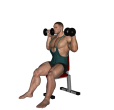 Shoulder Press - Dumbbell
Shoulder Press - Dumbbell
Benefits: The press is a highly effective compound upper-body exercise.
Purpose: The Shoulder Press is a good exercise for building up and strengthening the shoulder region.
Beginner Shoulders Triceps Chest Strength Dumbbell Military Press Chair Push Compound Gym
General Info: The Deltoids is a fan-shaped muscle. The Anterior (Front) Deltoid raises the arm toward the front of the body and rotates the arm inward. The Lateral (Side) Deltoid raises the arm to the side. The Posterior (Rear) Deltoid raises the arm toward the rear and rotates the arm outward.
 Shoulder Press - Dumbbell Single
Shoulder Press - Dumbbell Single
Benefits: The press is a highly effective compound upper-body exercise.
Purpose: The Barbell Shoulder Press (sometimes called the Military Press) is a good exercise for building up and strengthening the shoulder region.
Beginner Shoulders Triceps Chest Strength Dumbbell Military Press Chair Push Compound Gym
General Info: The Deltoids is a fan-shaped muscle. The Anterior (Front) Deltoid raises the arm toward the front of the body and rotates the arm inward. The Lateral (Side) Deltoid raises the arm to the side. The Posterior (Rear) Deltoid raises the arm toward the rear and rotates the arm outward.
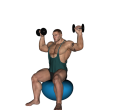 Shoulder Press - Fitness Ball Dublin
Shoulder Press - Fitness Ball Dublin
Benefits: The shoulder press is a highly effective compound upper-body exercise.
Purpose: The shoulder press is a good exercise for building up and strengthening the shoulder region.
Intermediate Shoulders Triceps Strength Dumbbell Fitness Ball Push Compound Gym
General Info: The Deltoids is a fan-shaped muscle. The Anterior (Front) Deltoid raises the arm toward the front of the body and rotates the arm inward. The Lateral (Side) Deltoid raises the arm to the side. The Posterior (Rear) Deltoid raises the arm toward the rear and rotates the arm outward.
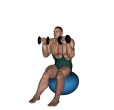 Shoulder Press - Fitness Ball Dumbbell
Shoulder Press - Fitness Ball Dumbbell
Benefits: This exercise isolates the anterior delt muscle.
Purpose: This exercise strengthens the front deltoid muscle area.
Beginner Front Shoulders Traps Strength Dumbbell Fitness Ball Push Gym
General Info: The anterior (front) deltoid or shoulder is one of the three distinct heads of the deltoid anatomy. It raises the arm toward the front and rotates the arm inward.
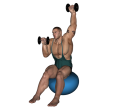 Shoulder Press - Fitness Ball Dumbbell Alternate
Shoulder Press - Fitness Ball Dumbbell Alternate
Benefits: This exercise isolates the anterior delt muscle.
Purpose: This exercise strengthens the front deltoid muscle area.
Beginner Front Shoulders Traps Strength Dumbbell Fitness Ball Push Gym
General Info: The anterior (front) deltoid or shoulder is one of the three distinct heads of the deltoid anatomy. It raises the arm toward the front and rotates the arm inward.
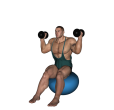 Shoulder Press - Fitness Ball Dumbbell Inwards
Shoulder Press - Fitness Ball Dumbbell Inwards
Benefits: The press is a highly effective compound upper-body exercise.
Purpose: The shoulder press is a good exercise for building up and strengthening the shoulder region.
Beginner Shoulders Triceps Chest Strength Dumbbell Fitness Ball Push Compound Gym
General Info: The Deltoids is a fan-shaped muscle. The Anterior (Front) Deltoid raises the arm toward the front of the body and rotates the arm inward. The Lateral (Side) Deltoid raises the arm to the side. The Posterior (Rear) Deltoid raises the arm toward the rear and rotates the arm outward.
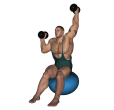 Shoulder Press - Fitness Ball Dumbbell Inwards Alternate
Shoulder Press - Fitness Ball Dumbbell Inwards Alternate
Benefits: The press is a highly effective compound upper-body exercise.
Purpose: The shoulder press is a good exercise for building up and strengthening the shoulder region.
Beginner Shoulders Triceps Chest Strength Dumbbell Fitness Ball Push Compound Gym
General Info: The Deltoids is a fan-shaped muscle. The Anterior (Front) Deltoid raises the arm toward the front of the body and rotates the arm inward. The Lateral (Side) Deltoid raises the arm to the side. The Posterior (Rear) Deltoid raises the arm toward the rear and rotates the arm outward.
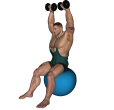 Shoulder Press - Fitness Ball Rotation Dumbbell
Shoulder Press - Fitness Ball Rotation Dumbbell
Benefits: This exercise isolates the anterior delt muscle.
Purpose: This exercise strengthens the front deltoid muscle area.
Beginner Front Shoulders Traps Strength Dumbbell Fitness Ball Push Gym
General Info: The anterior (front) deltoid or shoulder is one of the three distinct heads of the deltoid anatomy. It raises the arm toward the front and rotates the arm inward.
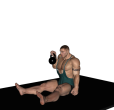 Shoulder Press - Kettlebell
Shoulder Press - Kettlebell
Benefits: The press is a highly effective compound upper-body exercise.
Purpose: The Shoulder Press is a good exercise for building up and strengthening the shoulder region.
Shoulders Triceps Chest Strength Kettlebell Push Compound Gym
General Info: The Deltoids is a fan-shaped muscle. The Anterior (Front) Deltoid raises the arm toward the front of the body and rotates the arm inward. The Lateral (Side) Deltoid raises the arm to the side. The Posterior (Rear) Deltoid raises the arm toward the rear and rotates the arm outward.
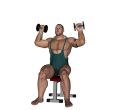 Shoulder Press - Kneeling Dumbbell
Shoulder Press - Kneeling Dumbbell
Benefits: This exercise isolates the anterior delt muscle.
Purpose: This exercise strengthens the front deltoid muscle area.
Beginner Front Shoulders Traps Strength Dumbbell Pull Gym
General Info: The anterior (front) deltoid or shoulder is one of the three distinct heads of the deltoid anatomy. It raises the arm toward the front and rotates the arm inward.
 Shoulder Press - Kneeling Water Bottle
Shoulder Press - Kneeling Water Bottle
Benefits: This exercise isolates the anterior delt muscle.
Purpose: This exercise strengthens the front deltoid muscle area.
Beginner Front Shoulders Traps Strength Water Bottle Pull Home
General Info: The anterior (front) deltoid or shoulder is one of the three distinct heads of the deltoid anatomy. It raises the arm toward the front and rotates the arm inward.
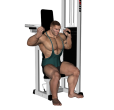 Shoulder Press - Machine
Shoulder Press - Machine
Benefits: The press is a highly effective compound upper-body exercise.
Purpose: The press is a good exercise for building up and strengthening the shoulder region.
Intermediate Shoulders Triceps Chest Strength Shoulder Press Machine Push Compound Gym
General Info: The Deltoids is a fan-shaped muscle. The Anterior (Front) Deltoid raises the arm toward the front of the body and rotates the arm inward. The Lateral (Side) Deltoid raises the arm to the side. The Posterior (Rear) Deltoid raises the arm toward the rear and rotates the arm outward.
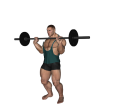 Shoulder Press - Push
Shoulder Press - Push
Benefits: The press is a highly effective compound upper-body exercise.
Purpose: The push press is a good exercise for building up and strengthening the shoulder region.
Intermediate Shoulders Triceps Chest Strength Barbell Push Compound Gym
General Info: The Deltoids is a fan-shaped muscle. The Anterior (Front) Deltoid raises the arm toward the front of the body and rotates the arm inward. The Lateral (Side) Deltoid raises the arm to the side. The Posterior (Rear) Deltoid raises the arm toward the rear and rotates the arm outward.
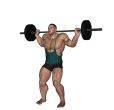 Shoulder Press - Push Behind The Neck
Shoulder Press - Push Behind The Neck
Benefits: The press is a highly effective compound upper-body exercise.
Purpose: The push press is a good exercise for building up and strengthening the shoulder region.
Intermediate Shoulders Triceps Chest Strength Barbell Push Compound Gym
General Info: The Deltoids is a fan-shaped muscle. The Anterior (Front) Deltoid raises the arm toward the front of the body and rotates the arm inward. The Lateral (Side) Deltoid raises the arm to the side. The Posterior (Rear) Deltoid raises the arm toward the rear and rotates the arm outward.
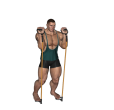 Shoulder Press - Resistance Tube
Shoulder Press - Resistance Tube
Benefits: This exercise isolates the anterior delt muscle.
Purpose: This exercise strengthens the front deltoid muscle area.
Beginner Front Shoulders Traps Strength Resistance Tube Push Gym
General Info: The anterior (front) deltoid or shoulder is one of the three distinct heads of the deltoid anatomy. It raises the arm toward the front and rotates the arm inward.
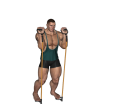 Shoulder Press - Resistance Tube Alternate
Shoulder Press - Resistance Tube Alternate
Benefits: This exercise isolates the anterior delt muscle.
Purpose: This exercise strengthens the front deltoid muscle area.
Beginner Front Shoulders Traps Strength Resistance Tube Push Gym
General Info: The anterior (front) deltoid or shoulder is one of the three distinct heads of the deltoid anatomy. It raises the arm toward the front and rotates the arm inward.
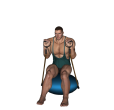 Shoulder Press - Resistance Tube Ball
Shoulder Press - Resistance Tube Ball
Benefits: This exercise isolates the anterior delt muscle.
Purpose: This exercise strengthens the front deltoid muscle area.
Beginner Front Shoulders Traps Strength Resistance Tube Fitness Ball Push Gym
General Info: The anterior (front) deltoid or shoulder is one of the three distinct heads of the deltoid anatomy. It raises the arm toward the front and rotates the arm inward.
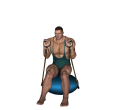 Shoulder Press - Resistance Tube Ball Alternate
Shoulder Press - Resistance Tube Ball Alternate
Benefits: This exercise isolates the anterior delt muscle.
Purpose: This exercise strengthens the front deltoid muscle area.
Beginner Front Shoulders Traps Strength Resistance Tube Fitness Ball Push Gym
General Info: The anterior (front) deltoid or shoulder is one of the three distinct heads of the deltoid anatomy. It raises the arm toward the front and rotates the arm inward.
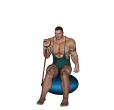 Shoulder Press - Resistance Tube Ball Single
Shoulder Press - Resistance Tube Ball Single
Benefits: This exercise isolates the anterior delt muscle.
Purpose: This exercise strengthens the front deltoid muscle area.
Beginner Front Shoulders Traps Strength Resistance Tube Fitness Ball Push Gym
General Info: The anterior (front) deltoid or shoulder is one of the three distinct heads of the deltoid anatomy. It raises the arm toward the front and rotates the arm inward.
 Shoulder Press - Resistance Tube Single
Shoulder Press - Resistance Tube Single
Benefits: This exercise isolates the anterior delt muscle.
Purpose: This exercise strengthens the front deltoid muscle area.
Beginner Front Shoulders Traps Strength Resistance Tube Push Gym
General Info: The anterior (front) deltoid or shoulder is one of the three distinct heads of the deltoid anatomy. It raises the arm toward the front and rotates the arm inward.
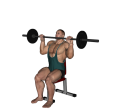 Shoulder Press - Seated Barbell Military
Shoulder Press - Seated Barbell Military
Benefits: The press is a highly effective compound upper-body exercise.
Purpose: The Military Press is a good exercise for building up and strengthening the shoulder region.
Intermediate Shoulders Triceps Chest Strength Barbell Military Press Chair Push Compound Gym
General Info: The deltoid is a fan-shaped muscle. The Anterior (Front) Deltoid raises the arm toward the front of the body and rotates the arm inward. The Lateral (Side) Deltoid raises the arm to the side. The Posterior (Rear) Deltoid raises the arm toward the rear and rotates the arm outward.
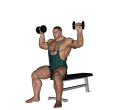 Shoulder Press - Seated Dublin
Shoulder Press - Seated Dublin
Benefits: The press is a highly effective compound upper-body exercise.
Purpose: The shoulder press is a good exercise for building up and strengthening the shoulder region.
Intermediate Shoulders Triceps Strength Dumbbell Flat Bench Push Compound Gym
General Info: The Deltoids is a fan-shaped muscle. The Anterior (Front) Deltoid raises the arm toward the front of the body and rotates the arm inward. The Lateral (Side) Deltoid raises the arm to the side. The Posterior (Rear) Deltoid raises the arm toward the rear and rotates the arm outward.
 Shoulder Press - Seated Dublin Water Bottle
Shoulder Press - Seated Dublin Water Bottle
Benefits: The press is a highly effective compound upper-body exercise.
Purpose: The Press is a good exercise for building up and strengthening the shoulder region.
Intermediate Shoulders Triceps Strength Water Bottle Chair Push Compound Home
General Info: The Deltoids is a fan-shaped muscle. The Anterior (Front) Deltoid raises the arm toward the front of the body and rotates the arm inward. The Lateral (Side) Deltoid raises the arm to the side. The Posterior (Rear) Deltoid raises the arm toward the rear and rotates the arm outward.
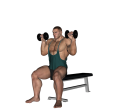 Shoulder Press - Seated Dumbbell
Shoulder Press - Seated Dumbbell
Benefits: This exercise isolates the anterior delt muscle.
Purpose: This exercise strengthens the front deltoid muscle area.
Beginner Front Shoulders Traps Strength Dumbbell Flat Bench Pull Gym
General Info: The anterior (front) deltoid or shoulder is one of the three distinct heads of the deltoid anatomy. It raises the arm toward the front and rotates the arm inward.
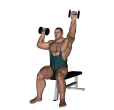 Shoulder Press - Seated Dumbbell Alternate
Shoulder Press - Seated Dumbbell Alternate
Benefits: This exercise isolates the anterior delt muscle.
Purpose: This exercise strengthens the front deltoid muscle area.
Beginner Front Shoulders Traps Strength Dumbbell Flat Bench Pull Gym
General Info: The anterior (front) deltoid or shoulder is one of the three distinct heads of the deltoid anatomy. It raises the arm toward the front and rotates the arm inward.
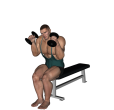 Shoulder Press - Seated Dumbbell Inwards Alternate
Shoulder Press - Seated Dumbbell Inwards Alternate
Benefits: This exercise isolates the anterior delt muscle.
Purpose: This exercise strengthens the front deltoid muscle area.
Beginner Front Shoulders Traps Strength Dumbbell Flat Bench Pull Gym
General Info: The anterior (front) deltoid or shoulder is one of the three distinct heads of the deltoid anatomy. It raises the arm toward the front and rotates the arm inward.
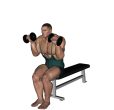 Shoulder Press - Seated Dumbbell Narrow Stance
Shoulder Press - Seated Dumbbell Narrow Stance
Benefits: This exercise isolates the anterior delt muscle.
Purpose: This exercise strengthens the front deltoid muscle area.
Beginner Front Shoulders Traps Strength Dumbbell Flat Bench Pull Gym
General Info: The anterior (front) deltoid or shoulder is one of the three distinct heads of the deltoid anatomy. It raises the arm toward the front and rotates the arm inward.
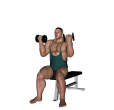 Shoulder Press - Seated Dumbbell Rotation
Shoulder Press - Seated Dumbbell Rotation
Benefits: This exercise isolates the anterior delt muscle.
Purpose: This exercise strengthens the front deltoid muscle area.
Beginner Front Shoulders Traps Strength Dumbbell Flat Bench Pull Gym
General Info: The anterior (front) deltoid or shoulder is one of the three distinct heads of the deltoid anatomy. It raises the arm toward the front and rotates the arm inward.
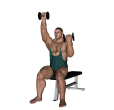 Shoulder Press - Seated Dumbbell Rotation Alternate
Shoulder Press - Seated Dumbbell Rotation Alternate
Benefits: This exercise isolates the anterior delt muscle.
Purpose: This exercise strengthens the front deltoid muscle area.
Beginner Front Shoulders Traps Strength Dumbbell Flat Bench Pull Gym
General Info: The anterior (front) deltoid or shoulder is one of the three distinct heads of the deltoid anatomy. It raises the arm toward the front and rotates the arm inward.
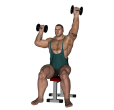 Shoulder Press - Seated Dumbbell Single
Shoulder Press - Seated Dumbbell Single
Benefits: This exercise isolates the anterior delt muscle.
Purpose: This exercise strengthens the front deltoid muscle area.
Beginner Front Shoulders Traps Strength Dumbbell Flat Bench Pull Gym
General Info: The anterior (front) deltoid or shoulder is one of the three distinct heads of the deltoid anatomy. It raises the arm toward the front and rotates the arm inward.
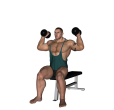 Shoulder Press - Seated Inwards
Shoulder Press - Seated Inwards
Benefits: This exercise isolates the anterior delt muscle.
Purpose: This exercise strengthens the front deltoid muscle area.
Beginner Front Shoulders Traps Strength Dumbbell Flat Bench Pull Gym
General Info: The anterior (front) deltoid or shoulder is one of the three distinct heads of the deltoid anatomy. It raises the arm toward the front and rotates the arm inward.
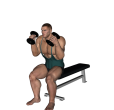 Shoulder Press - Seated Inwards Dumbbell
Shoulder Press - Seated Inwards Dumbbell
Benefits: This exercise isolates the anterior delt muscle.
Purpose: This exercise strengthens the front deltoid muscle area.
Beginner Front Shoulders Traps Strength Dumbbell Flat Bench Pull Gym
General Info: The anterior (front) deltoid or shoulder is one of the three distinct heads of the deltoid anatomy. It raises the arm toward the front and rotates the arm inward.
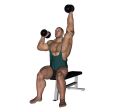 Shoulder Press - Seated Inwards Dumbbell Alternate
Shoulder Press - Seated Inwards Dumbbell Alternate
Benefits: This exercise isolates the anterior delt muscle.
Purpose: This exercise strengthens the front deltoid muscle area.
Beginner Front Shoulders Traps Strength Dumbbell Flat Bench Pull Gym
General Info: The anterior (front) deltoid or shoulder is one of the three distinct heads of the deltoid anatomy. It raises the arm toward the front and rotates the arm inward.
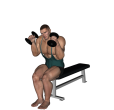 Shoulder Press - Seated Inwards Dumbbell Narrow
Shoulder Press - Seated Inwards Dumbbell Narrow
Benefits: This exercise isolates the anterior delt muscle.
Purpose: This exercise strengthens the front deltoid muscle area.
Beginner Front Shoulders Traps Strength Dumbbell Flat Bench Pull Gym
General Info: The anterior (front) deltoid or shoulder is one of the three distinct heads of the deltoid anatomy. It raises the arm toward the front and rotates the arm inward.
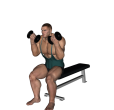 Shoulder Press - Seated Inwards Reverse
Shoulder Press - Seated Inwards Reverse
Benefits: This exercise isolates the anterior delt muscle.
Purpose: This exercise strengthens the front deltoid muscle area.
Beginner Front Shoulders Traps Strength Dumbbell Flat Bench Pull Gym
General Info: The anterior (front) deltoid or shoulder is one of the three distinct heads of the deltoid anatomy. It raises the arm toward the front and rotates the arm inward.
 Shoulder Press - Seated Inwards Water Bottle
Shoulder Press - Seated Inwards Water Bottle
Benefits: This exercise isolates the anterior delt muscle.
Purpose: This exercise strengthens the front deltoid muscle area.
Beginner Front Shoulders Traps Strength Water Bottle Chair Pull Home
General Info: The anterior (front) deltoid or shoulder is one of the three distinct heads of the deltoid anatomy. It raises the arm toward the front and rotates the arm inward.
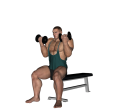 Shoulder Press - Seated Reverse
Shoulder Press - Seated Reverse
Benefits: This exercise isolates the anterior delt muscle.
Purpose: This exercise strengthens the front deltoid muscle area.
Beginner Front Shoulders Traps Strength Dumbbell Flat Bench Pull Gym
General Info: The anterior (front) deltoid or shoulder is one of the three distinct heads of the deltoid anatomy. It raises the arm toward the front and rotates the arm inward.
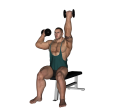 Shoulder Press - Seated Reverse Alternate
Shoulder Press - Seated Reverse Alternate
Benefits: This exercise isolates the anterior delt muscle.
Purpose: This exercise strengthens the front deltoid muscle area.
Beginner Front Shoulders Traps Strength Dumbbell Flat Bench Pull Gym
General Info: The anterior (front) deltoid or shoulder is one of the three distinct heads of the deltoid anatomy. It raises the arm toward the front and rotates the arm inward.
 Shoulder Press - Seated Reverse Bottle Feet Up
Shoulder Press - Seated Reverse Bottle Feet Up
Benefits: This exercise isolates the anterior delt muscle.
Purpose: This exercise strengthens the front deltoid muscle area.
Beginner Front Shoulders Traps Strength Water Bottle Chair Pull Home
General Info: The anterior (front) deltoid or shoulder is one of the three distinct heads of the deltoid anatomy. It raises the arm toward the front and rotates the arm inward.
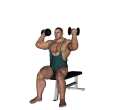 Shoulder Press - Seated Reverse Feet Up
Shoulder Press - Seated Reverse Feet Up
Benefits: This exercise isolates the anterior delt muscle.
Purpose: This exercise strengthens the front deltoid muscle area.
Beginner Front Shoulders Traps Strength Dumbbell Flat Bench Pull Gym
General Info: The anterior (front) deltoid or shoulder is one of the three distinct heads of the deltoid anatomy. It raises the arm toward the front and rotates the arm inward.
 Shoulder Press - Seated Reverse Water Bottle
Shoulder Press - Seated Reverse Water Bottle
Benefits: This exercise isolates the anterior delt muscle.
Purpose: This exercise strengthens the front deltoid muscle area.
Beginner Front Shoulders Traps Strength Water Bottle Chair Pull Home
General Info: The anterior (front) deltoid or shoulder is one of the three distinct heads of the deltoid anatomy. It raises the arm toward the front and rotates the arm inward.
 Shoulder Press - Seated Reverse Water Bottle Alternate
Shoulder Press - Seated Reverse Water Bottle Alternate
Benefits: This exercise isolates the anterior delt muscle.
Purpose: This exercise strengthens the front deltoid muscle area.
Beginner Front Shoulders Traps Strength Water Bottle Chair Pull Home
General Info: The anterior (front) deltoid or shoulder is one of the three distinct heads of the deltoid anatomy. It raises the arm toward the front and rotates the arm inward.
 Shoulder Press - Seated Water Bottle
Shoulder Press - Seated Water Bottle
Benefits: This exercise isolates the anterior delt muscle.
Purpose: This exercise strengthens the front deltoid muscle area.
Beginner Front Shoulders Traps Strength Water Bottle Chair Pull Home
General Info: The anterior (front) deltoid or shoulder is one of the three distinct heads of the deltoid anatomy. It raises the arm toward the front and rotates the arm inward.
 Shoulder Press - Seated Water Bottle Alternate
Shoulder Press - Seated Water Bottle Alternate
Benefits: This exercise isolates the anterior delt muscle.
Purpose: This exercise strengthens the front deltoid muscle area.
Beginner Front Shoulders Traps Strength Water Bottle Chair Pull Home
General Info: The anterior (front) deltoid or shoulder is one of the three distinct heads of the deltoid anatomy. It raises the arm toward the front and rotates the arm inward.
 Shoulder Press - Seated Water Bottle Inwards Alternate
Shoulder Press - Seated Water Bottle Inwards Alternate
Benefits: This exercise isolates the anterior delt muscle.
Purpose: This exercise strengthens the front deltoid muscle area.
Beginner Front Shoulders Traps Strength Water Bottle Chair Pull Home
General Info: The anterior (front) deltoid or shoulder is one of the three distinct heads of the deltoid anatomy. It raises the arm toward the front and rotates the arm inward.
 Shoulder Press - Seated Water Bottle Narrow
Shoulder Press - Seated Water Bottle Narrow
Benefits: This exercise isolates the anterior delt muscle.
Purpose: This exercise strengthens the front deltoid muscle area.
Beginner Front Shoulders Traps Strength Water Bottle Chair Pull Home
General Info: The anterior (front) deltoid or shoulder is one of the three distinct heads of the deltoid anatomy. It raises the arm toward the front and rotates the arm inward.
 Shoulder Press - Seated Water Bottle Rotation
Shoulder Press - Seated Water Bottle Rotation
Benefits: This exercise isolates the anterior delt muscle.
Purpose: This exercise strengthens the front deltoid muscle area.
Beginner Front Shoulders Traps Strength Water Bottle Chair Pull Home
General Info: The anterior (front) deltoid or shoulder is one of the three distinct heads of the deltoid anatomy. It raises the arm toward the front and rotates the arm inward.
 Shoulder Press - Seated Water Bottle Rotation Alternate
Shoulder Press - Seated Water Bottle Rotation Alternate
Benefits: This exercise isolates the anterior delt muscle.
Purpose: This exercise strengthens the front deltoid muscle area.
Beginner Front Shoulders Traps Strength Water Bottle Chair Pull Home
General Info: The anterior (front) deltoid or shoulder is one of the three distinct heads of the deltoid anatomy. It raises the arm toward the front and rotates the arm inward.
 Shoulder Press - Seated Water Bottle Single
Shoulder Press - Seated Water Bottle Single
Benefits: This exercise isolates the anterior delt muscle.
Purpose: This exercise strengthens the front deltoid muscle area.
Beginner Front Shoulders Traps Strength Water Bottle Chair Pull Home
General Info: The anterior (front) deltoid or shoulder is one of the three distinct heads of the deltoid anatomy. It raises the arm toward the front and rotates the arm inward.
 Shoulder Press - Smith Machine Kneeling Front
Shoulder Press - Smith Machine Kneeling Front
Benefits: The press is a highly effective compound upper-body exercise.
Purpose: The shoulder press is a good exercise for building up and strengthening the shoulder region.
Intermediate Shoulders Triceps Chest Strength Smith Machine Push Compound Gym
General Info: The Deltoids is a fan-shaped muscle. The Anterior (Front) Deltoid raises the arm toward the front of the body and rotates the arm inward. The Lateral (Side) Deltoid raises the arm to the side. The Posterior (Rear) Deltoid raises the arm toward the rear and rotates the arm outward.
 Shoulder Press - Smith Machine Kneeling Rear
Shoulder Press - Smith Machine Kneeling Rear
Benefits: The press is a highly effective compound upper-body exercise.
Purpose: The shoulder press is a good exercise for building up and strengthening the shoulder region.
Intermediate Shoulders Triceps Chest Strength Smith Machine Push Compound Gym
General Info: The Deltoids is a fan-shaped muscle. The Anterior (Front) Deltoid raises the arm toward the front of the body and rotates the arm inward. The Lateral (Side) Deltoid raises the arm to the side. The Posterior (Rear) Deltoid raises the arm toward the rear and rotates the arm outward.
 Shoulder Press - Smith Machine Kneeling Reverse
Shoulder Press - Smith Machine Kneeling Reverse
Benefits: The press is a highly effective compound upper-body exercise.
Purpose: The shoulder press is a good exercise for building up and strengthening the shoulder region.
Intermediate Shoulders Triceps Chest Strength Smith Machine Push Compound Gym
General Info: The Deltoids is a fan-shaped muscle. The Anterior (Front) Deltoid raises the arm toward the front of the body and rotates the arm inward. The Lateral (Side) Deltoid raises the arm to the side. The Posterior (Rear) Deltoid raises the arm toward the rear and rotates the arm outward.
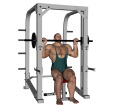 Shoulder Press - Smith Machine Overhead
Shoulder Press - Smith Machine Overhead
Benefits: The press is a highly effective compound upper-body exercise.
Purpose: The shoulder press is a good exercise for building up and strengthening the shoulder region.
Intermediate Shoulders Triceps Chest Strength Smith Machine Push Compound Gym
General Info: The Deltoids is a fan-shaped muscle. The Anterior (Front) Deltoid raises the arm toward the front of the body and rotates the arm inward. The Lateral (Side) Deltoid raises the arm to the side. The Posterior (Rear) Deltoid raises the arm toward the rear and rotates the arm outward.
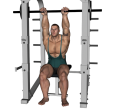 Shoulder Press - Smith Machine Seated
Shoulder Press - Smith Machine Seated
Benefits: The press is a highly effective compound upper-body exercise.
Purpose: The shoulder press is a good exercise for building up and strengthening the shoulder region.
Intermediate Shoulders Triceps Chest Strength Smith Machine Flat Bench Push Compound Gym
General Info: The Deltoids is a fan-shaped muscle. The Anterior (Front) Deltoid raises the arm toward the front of the body and rotates the arm inward. The Lateral (Side) Deltoid raises the arm to the side. The Posterior (Rear) Deltoid raises the arm toward the rear and rotates the arm outward.
 Shoulder Press - Smith Machine Seated Feet Up
Shoulder Press - Smith Machine Seated Feet Up
Benefits: The press is a highly effective compound upper-body exercise.
Purpose: The shoulder press is a good exercise for building up and strengthening the shoulder region.
Intermediate Shoulders Triceps Chest Strength Smith Machine Flat Bench Push Compound Gym
General Info: The Deltoids is a fan-shaped muscle. The Anterior (Front) Deltoid raises the arm toward the front of the body and rotates the arm inward. The Lateral (Side) Deltoid raises the arm to the side. The Posterior (Rear) Deltoid raises the arm toward the rear and rotates the arm outward.
 Shoulder Press - Smith Machine Seated Feet Up Rear
Shoulder Press - Smith Machine Seated Feet Up Rear
Benefits: The press is a highly effective compound upper-body exercise.
Purpose: The shoulder press is a good exercise for building up and strengthening the shoulder region.
Intermediate Shoulders Triceps Chest Strength Smith Machine Flat Bench Push Compound Gym
General Info: The Deltoids is a fan-shaped muscle. The Anterior (Front) Deltoid raises the arm toward the front of the body and rotates the arm inward. The Lateral (Side) Deltoid raises the arm to the side. The Posterior (Rear) Deltoid raises the arm toward the rear and rotates the arm outward.
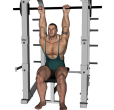 Shoulder Press - Smith Machine Seated Rear
Shoulder Press - Smith Machine Seated Rear
Benefits: The press is a highly effective compound upper-body exercise.
Purpose: The shoulder press is a good exercise for building up and strengthening the shoulder region.
Intermediate Shoulders Triceps Chest Strength Smith Machine Flat Bench Push Compound Gym
General Info: The Deltoids is a fan-shaped muscle. The Anterior (Front) Deltoid raises the arm toward the front of the body and rotates the arm inward. The Lateral (Side) Deltoid raises the arm to the side. The Posterior (Rear) Deltoid raises the arm toward the rear and rotates the arm outward.
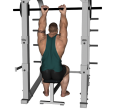 Shoulder Press - Smith Machine Seated Reverse
Shoulder Press - Smith Machine Seated Reverse
Benefits: The press is a highly effective compound upper-body exercise.
Purpose: The shoulder press is a good exercise for building up and strengthening the shoulder region.
Intermediate Shoulders Triceps Chest Strength Smith Machine Flat Bench Push Compound Gym
General Info: The Deltoids is a fan-shaped muscle. The Anterior (Front) Deltoid raises the arm toward the front of the body and rotates the arm inward. The Lateral (Side) Deltoid raises the arm to the side. The Posterior (Rear) Deltoid raises the arm toward the rear and rotates the arm outward.
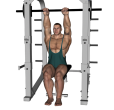 Shoulder Press - Smith Machine Seated Upright
Shoulder Press - Smith Machine Seated Upright
Benefits: The press is a highly effective compound upper-body exercise.
Purpose: The shoulder press is a good exercise for building up and strengthening the shoulder region.
Intermediate Shoulders Triceps Chest Strength Smith Machine Flat Bench Push Compound Gym
General Info: The Deltoids is a fan-shaped muscle. The Anterior (Front) Deltoid raises the arm toward the front of the body and rotates the arm inward. The Lateral (Side) Deltoid raises the arm to the side. The Posterior (Rear) Deltoid raises the arm toward the rear and rotates the arm outward.
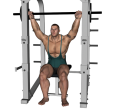 Shoulder Press - Smith Machine Seated Wide Grip
Shoulder Press - Smith Machine Seated Wide Grip
Benefits: The press is a highly effective compound upper-body exercise.
Purpose: The shoulder press is a good exercise for building up and strengthening the shoulder region.
Intermediate Shoulders Triceps Chest Strength Smith Machine Flat Bench Push Compound Gym
General Info: The Deltoids is a fan-shaped muscle. The Anterior (Front) Deltoid raises the arm toward the front of the body and rotates the arm inward. The Lateral (Side) Deltoid raises the arm to the side. The Posterior (Rear) Deltoid raises the arm toward the rear and rotates the arm outward.
 Shoulder Press - Smith Seated Feet On Bench Rear
Shoulder Press - Smith Seated Feet On Bench Rear
Benefits: The press is a highly effective compound upper-body exercise.
Purpose: The shoulder press is a good exercise for building up and strengthening the shoulder region.
Intermediate Shoulders Triceps Chest Strength Smith Machine Flat Bench Push Compound Gym
General Info: The Deltoids is a fan-shaped muscle. The Anterior (Front) Deltoid raises the arm toward the front of the body and rotates the arm inward. The Lateral (Side) Deltoid raises the arm to the side. The Posterior (Rear) Deltoid raises the arm toward the rear and rotates the arm outward.
 Shoulder Press - Smith Seated Feet Up Reverse
Shoulder Press - Smith Seated Feet Up Reverse
Benefits: The press is a highly effective compound upper-body exercise.
Purpose: The shoulder press is a good exercise for building up and strengthening the shoulder region.
Intermediate Shoulders Triceps Chest Strength Smith Machine Flat Bench Push Compound Gym
General Info: The Deltoids is a fan-shaped muscle. The Anterior (Front) Deltoid raises the arm toward the front of the body and rotates the arm inward. The Lateral (Side) Deltoid raises the arm to the side. The Posterior (Rear) Deltoid raises the arm toward the rear and rotates the arm outward.
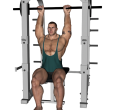 Shoulder Press - Smith Seated Rear Upright
Shoulder Press - Smith Seated Rear Upright
Benefits: The press is a highly effective compound upper-body exercise.
Purpose: The shoulder press is a good exercise for building up and strengthening the shoulder region.
Intermediate Shoulders Triceps Chest Strength Smith Machine Flat Bench Push Compound Gym
General Info: The Deltoids is a fan-shaped muscle. The Anterior (Front) Deltoid raises the arm toward the front of the body and rotates the arm inward. The Lateral (Side) Deltoid raises the arm to the side. The Posterior (Rear) Deltoid raises the arm toward the rear and rotates the arm outward.
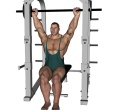 Shoulder Press - Smith Seated Rear Upright Wide
Shoulder Press - Smith Seated Rear Upright Wide
Benefits: The press is a highly effective compound upper-body exercise.
Purpose: The shoulder press is a good exercise for building up and strengthening the shoulder region.
Intermediate Shoulders Triceps Chest Strength Smith Machine Flat Bench Push Compound Gym
General Info: The Deltoids is a fan-shaped muscle. The Anterior (Front) Deltoid raises the arm toward the front of the body and rotates the arm inward. The Lateral (Side) Deltoid raises the arm to the side. The Posterior (Rear) Deltoid raises the arm toward the rear and rotates the arm outward.
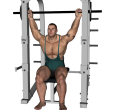 Shoulder Press - Smith Seated Rear Wide Grip
Shoulder Press - Smith Seated Rear Wide Grip
Benefits: The press is a highly effective compound upper-body exercise.
Purpose: The shoulder press is a good exercise for building up and strengthening the shoulder region.
Intermediate Shoulders Triceps Chest Strength Smith Machine Flat Bench Push Compound Gym
General Info: The Deltoids is a fan-shaped muscle. The Anterior (Front) Deltoid raises the arm toward the front of the body and rotates the arm inward. The Lateral (Side) Deltoid raises the arm to the side. The Posterior (Rear) Deltoid raises the arm toward the rear and rotates the arm outward.
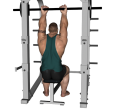 Shoulder Press - Smith Seated Reverse
Shoulder Press - Smith Seated Reverse
Benefits: The press is a highly effective compound upper-body exercise.
Purpose: The shoulder press is a good exercise for building up and strengthening the shoulder region.
Intermediate Shoulders Triceps Chest Strength Smith Machine Flat Bench Push Compound Gym
General Info: The Deltoids is a fan-shaped muscle. The Anterior (Front) Deltoid raises the arm toward the front of the body and rotates the arm inward. The Lateral (Side) Deltoid raises the arm to the side. The Posterior (Rear) Deltoid raises the arm toward the rear and rotates the arm outward.
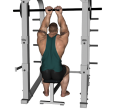 Shoulder Press - Smith Seated Reverse Close Grip
Shoulder Press - Smith Seated Reverse Close Grip
Benefits: The press is a highly effective compound upper-body exercise.
Purpose: The shoulder press is a good exercise for building up and strengthening the shoulder region.
Intermediate Shoulders Triceps Chest Strength Smith Machine Flat Bench Push Compound Gym
General Info: The Deltoids is a fan-shaped muscle. The Anterior (Front) Deltoid raises the arm toward the front of the body and rotates the arm inward. The Lateral (Side) Deltoid raises the arm to the side. The Posterior (Rear) Deltoid raises the arm toward the rear and rotates the arm outward.
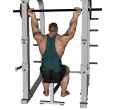 Shoulder Press - Smith Seated Reverse Wide
Shoulder Press - Smith Seated Reverse Wide
Benefits: The press is a highly effective compound upper-body exercise.
Purpose: The shoulder press is a good exercise for building up and strengthening the shoulder region.
Intermediate Shoulders Triceps Chest Strength Smith Machine Flat Bench Push Compound Gym
General Info: The Deltoids is a fan-shaped muscle. The Anterior (Front) Deltoid raises the arm toward the front of the body and rotates the arm inward. The Lateral (Side) Deltoid raises the arm to the side. The Posterior (Rear) Deltoid raises the arm toward the rear and rotates the arm outward.
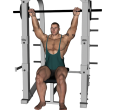 Shoulder Press - Smith Seated Upright Wide Grip
Shoulder Press - Smith Seated Upright Wide Grip
Benefits: The press is a highly effective compound upper-body exercise.
Purpose: The shoulder press is a good exercise for building up and strengthening the shoulder region.
Intermediate Shoulders Triceps Chest Strength Smith Machine Flat Bench Push Compound Gym
General Info: The Deltoids is a fan-shaped muscle. The Anterior (Front) Deltoid raises the arm toward the front of the body and rotates the arm inward. The Lateral (Side) Deltoid raises the arm to the side. The Posterior (Rear) Deltoid raises the arm toward the rear and rotates the arm outward.
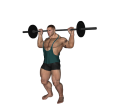 Shoulder Press - Standing Barbell Behind Neck
Shoulder Press - Standing Barbell Behind Neck
Benefits: The press is a highly effective compound upper-body exercise.
Purpose: The press is a good exercise for building up and strengthening the shoulder region.
Intermediate Shoulders Triceps Chest Strength Barbell Push Compound Gym
General Info: The Deltoids is a fan-shaped muscle. The Anterior (Front) Deltoid raises the arm toward the front of the body and rotates the arm inward. The Lateral (Side) Deltoid raises the arm to the side. The Posterior (Rear) Deltoid raises the arm toward the rear and rotates the arm outward.
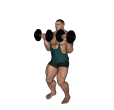 Shoulder Press - Standing Dumbbell
Shoulder Press - Standing Dumbbell
Benefits: The press is a highly effective compound upper-body exercise.
Purpose: The press is a good exercise for building up and strengthening the shoulder region.
Intermediate Shoulders Triceps Chest Strength Dumbbell Push Compound Gym
General Info: The Deltoids is a fan-shaped muscle. The Anterior (Front) Deltoid raises the arm toward the front of the body and rotates the arm inward. The Lateral (Side) Deltoid raises the arm to the side. The Posterior (Rear) Deltoid raises the arm toward the rear and rotates the arm outward.
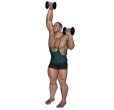 Shoulder Press - Standing Dumbbell Alternate
Shoulder Press - Standing Dumbbell Alternate
Benefits: The press is a highly effective compound upper-body exercise.
Purpose: The Military Press is a good exercise for building up and strengthening the shoulder region.
Intermediate Shoulders Triceps Chest Strength Dumbbell Push Compound Gym
General Info: The Deltoids is a fan-shaped muscle. The Anterior (Front) Deltoid raises the arm toward the front of the body and rotates the arm inward. The Lateral (Side) Deltoid raises the arm to the side. The Posterior (Rear) Deltoid raises the arm toward the rear and rotates the arm outward.
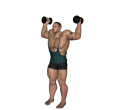 Shoulder Press - Standing Dumbbell Inwards
Shoulder Press - Standing Dumbbell Inwards
Benefits: This exercise isolates the anterior delt muscle.
Purpose: This exercise strengthens the front deltoid muscle area.
Beginner Front Shoulders Traps Strength Dumbbell Pull Gym
General Info: The anterior (front) deltoid or shoulder is one of the three distinct heads of the deltoid anatomy. It raises the arm toward the front and rotates the arm inward.
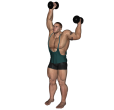 Shoulder Press - Standing Dumbbell Inwards Alternate
Shoulder Press - Standing Dumbbell Inwards Alternate
Benefits: This exercise isolates the anterior delt muscle.
Purpose: This exercise strengthens the front deltoid muscle area.
Beginner Front Shoulders Traps Strength Dumbbell Pull Gym
General Info: The anterior (front) deltoid or shoulder is one of the three distinct heads of the deltoid anatomy. It raises the arm toward the front and rotates the arm inward.
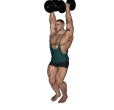 Shoulder Press - Standing Dumbbell Inwards Narrow
Shoulder Press - Standing Dumbbell Inwards Narrow
Benefits: The press is a highly effective compound upper-body exercise.
Purpose: The shoulder press is a good exercise for building up and strengthening the shoulder region.
Intermediate Shoulders Triceps Chest Strength Dumbbell Push Compound Gym
General Info: The Deltoids is a fan-shaped muscle. The Anterior (Front) Deltoid raises the arm toward the front of the body and rotates the arm inward. The Lateral (Side) Deltoid raises the arm to the side. The Posterior (Rear) Deltoid raises the arm toward the rear and rotates the arm outward.
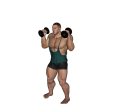 Shoulder Press - Standing Dumbbell Palms In
Shoulder Press - Standing Dumbbell Palms In
Benefits: The press is a highly effective compound upper-body exercise.
Purpose: The shoulder press is a good exercise for building up and strengthening the shoulder region.
Intermediate Shoulders Triceps Chest Strength Dumbbell Push Compound Gym
General Info: The Deltoids is a fan-shaped muscle. The Anterior (Front) Deltoid raises the arm toward the front of the body and rotates the arm inward. The Lateral (Side) Deltoid raises the arm to the side. The Posterior (Rear) Deltoid raises the arm toward the rear and rotates the arm outward.
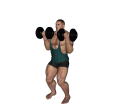 Shoulder Press - Standing Dumbbell Reverse
Shoulder Press - Standing Dumbbell Reverse
Benefits: The press is a highly effective compound upper-body exercise.
Purpose: The shoulder press is a good exercise for building up and strengthening the shoulder region.
Intermediate Shoulders Triceps Chest Strength Dumbbell Push Compound Gym
General Info: The Deltoids is a fan-shaped muscle. The Anterior (Front) Deltoid raises the arm toward the front of the body and rotates the arm inward. The Lateral (Side) Deltoid raises the arm to the side. The Posterior (Rear) Deltoid raises the arm toward the rear and rotates the arm outward.
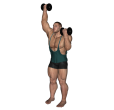 Shoulder Press - Standing Dumbbell Reverse Alternate
Shoulder Press - Standing Dumbbell Reverse Alternate
Benefits: The press is a highly effective compound upper-body exercise.
Purpose: The Military Press is a good exercise for building up and strengthening the shoulder region.
Intermediate Shoulders Triceps Chest Strength Dumbbell Push Compound Gym
General Info: The Deltoids is a fan-shaped muscle. The Anterior (Front) Deltoid raises the arm toward the front of the body and rotates the arm inward. The Lateral (Side) Deltoid raises the arm to the side. The Posterior (Rear) Deltoid raises the arm toward the rear and rotates the arm outward.
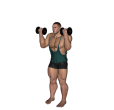 Shoulder Press - Standing Dumbbell Rotation
Shoulder Press - Standing Dumbbell Rotation
Benefits: This exercise isolates the anterior delt muscle.
Purpose: This exercise strengthens the front deltoid muscle area.
Beginner Front Shoulders Traps Strength Dumbbell Push Gym
General Info: The anterior (front) deltoid or shoulder is one of the three distinct heads of the deltoid anatomy. It raises the arm toward the front and rotates the arm inward.
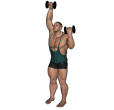 Shoulder Press - Standing Dumbbell Rotation Alternate
Shoulder Press - Standing Dumbbell Rotation Alternate
Benefits: This exercise isolates the anterior delt muscle.
Purpose: This exercise strengthens the front deltoid muscle area.
Beginner Front Shoulders Traps Strength Dumbbell Push Gym
General Info: The anterior (front) deltoid or shoulder is one of the three distinct heads of the deltoid anatomy. It raises the arm toward the front and rotates the arm inward.
 Shoulder Press - Standing Dumbbell Single
Shoulder Press - Standing Dumbbell Single
Benefits: The press is a highly effective compound upper-body exercise.
Purpose: The Military Press is a good exercise for building up and strengthening the shoulder region.
Intermediate Shoulders Triceps Chest Strength Dumbbell Push Compound Gym
General Info: The Deltoids is a fan-shaped muscle. The Anterior (Front) Deltoid raises the arm toward the front of the body and rotates the arm inward. The Lateral (Side) Deltoid raises the arm to the side. The Posterior (Rear) Deltoid raises the arm toward the rear and rotates the arm outward.
 Shoulder Press - Standing Inwards Bottle Close
Shoulder Press - Standing Inwards Bottle Close
Benefits: This exercise isolates the anterior delt muscle.
Purpose: This exercise strengthens the front deltoid muscle area.
Beginner Front Shoulders Traps Strength Water Bottle Pull Home
General Info: The anterior (front) deltoid or shoulder is one of the three distinct heads of the deltoid anatomy. It raises the arm toward the front and rotates the arm inward.
 Shoulder Press - Standing Inwards Water Bottle
Shoulder Press - Standing Inwards Water Bottle
Benefits: This exercise isolates the anterior delt muscle.
Purpose: This exercise strengthens the front deltoid muscle area.
Beginner Front Shoulders Traps Strength Water Bottle Pull Home
General Info: The anterior (front) deltoid or shoulder is one of the three distinct heads of the deltoid anatomy. It raises the arm toward the front and rotates the arm inward.
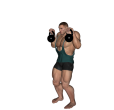 Shoulder Press - Standing Kettlebell
Shoulder Press - Standing Kettlebell
Benefits: The press is a highly effective compound upper-body exercise.
Purpose: The Military Press is a good exercise for building up and strengthening the shoulder region.
Shoulders Triceps Chest Strength Kettlebell Push Compound Gym
General Info: The Deltoids is a fan-shaped muscle. The Anterior (Front) Deltoid raises the arm toward the front of the body and rotates the arm inward. The Lateral (Side) Deltoid raises the arm to the side. The Posterior (Rear) Deltoid raises the arm toward the rear and rotates the arm outward.
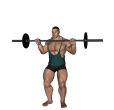 Shoulder Press - Standing Military
Shoulder Press - Standing Military
Benefits: The press is a highly effective compound upper-body exercise.
Purpose: The Military Press is a good exercise for building up and strengthening the shoulder region.
Intermediate Shoulders Triceps Chest Strength Barbell Push Compound Gym
General Info: The Deltoids is a fan-shaped muscle. The Anterior (Front) Deltoid raises the arm toward the front of the body and rotates the arm inward. The Lateral (Side) Deltoid raises the arm to the side. The Posterior (Rear) Deltoid raises the arm toward the rear and rotates the arm outward.
 Shoulder Press - Standing Reverse Water Bottle
Shoulder Press - Standing Reverse Water Bottle
Benefits: This exercise isolates the anterior delt muscle.
Purpose: This exercise strengthens the front deltoid muscle area.
Beginner Front Shoulders Traps Strength Water Bottle Pull Home
General Info: The anterior (front) deltoid or shoulder is one of the three distinct heads of the deltoid anatomy. It raises the arm toward the front and rotates the arm inward.
 Shoulder Press - Standing Reverse Water Bottle Alternate
Shoulder Press - Standing Reverse Water Bottle Alternate
Benefits: This exercise isolates the anterior delt muscle.
Purpose: This exercise strengthens the front deltoid muscle area.
Beginner Front Shoulders Traps Strength Water Bottle Pull Home
General Info: The anterior (front) deltoid or shoulder is one of the three distinct heads of the deltoid anatomy. It raises the arm toward the front and rotates the arm inward.
 Shoulder Press - Standing Water Bottle
Shoulder Press - Standing Water Bottle
Benefits: This exercise isolates the anterior delt muscle.
Purpose: This exercise strengthens the front deltoid muscle area.
Beginner Front Shoulders Traps Strength Water Bottle Pull Home
General Info: The anterior (front) deltoid or shoulder is one of the three distinct heads of the deltoid anatomy. It raises the arm toward the front and rotates the arm inward.
 Shoulder Press - Standing Water Bottle Alternate
Shoulder Press - Standing Water Bottle Alternate
Benefits: This exercise isolates the anterior delt muscle.
Purpose: This exercise strengthens the front deltoid muscle area.
Beginner Front Shoulders Traps Strength Water Bottle Pull Home
General Info: The anterior (front) deltoid or shoulder is one of the three distinct heads of the deltoid anatomy. It raises the arm toward the front and rotates the arm inward.
 Shoulder Press - Standing Water Bottle Inwards Alternate
Shoulder Press - Standing Water Bottle Inwards Alternate
Benefits: This exercise isolates the anterior delt muscle.
Purpose: This exercise strengthens the front deltoid muscle area.
Beginner Front Shoulders Traps Strength Water Bottle Pull Home
General Info: The anterior (front) deltoid or shoulder is one of the three distinct heads of the deltoid anatomy. It raises the arm toward the front and rotates the arm inward.
 Shoulder Press - Standing Water Bottle Rotation
Shoulder Press - Standing Water Bottle Rotation
Benefits: This exercise isolates the anterior delt muscle.
Purpose: This exercise strengthens the front deltoid muscle area.
Beginner Front Shoulders Traps Strength Water Bottle Pull Home
General Info: The anterior (front) deltoid or shoulder is one of the three distinct heads of the deltoid anatomy. It raises the arm toward the front and rotates the arm inward.
 Shoulder Press - Standing Water Bottle Rotation Alternate
Shoulder Press - Standing Water Bottle Rotation Alternate
Benefits: This exercise isolates the anterior delt muscle.
Purpose: This exercise strengthens the front deltoid muscle area.
Beginner Front Shoulders Traps Strength Water Bottle Pull Home
General Info: The anterior (front) deltoid or shoulder is one of the three distinct heads of the deltoid anatomy. It raises the arm toward the front and rotates the arm inward.
 Shoulder Press - Standing Water Bottle Single
Shoulder Press - Standing Water Bottle Single
Benefits: This exercise isolates the anterior delt muscle.
Purpose: This exercise strengthens the front deltoid muscle area.
Beginner Front Shoulders Traps Strength Water Bottle Pull Home
General Info: The anterior (front) deltoid or shoulder is one of the three distinct heads of the deltoid anatomy. It raises the arm toward the front and rotates the arm inward.
 Shoulder Press - Water Bottle
Shoulder Press - Water Bottle
Benefits: The press is a highly effective compound upper-body exercise.
Purpose: The Barbell Shoulder Press (sometimes called the Military Press) is a good exercise for building up and strengthening the shoulder region.
Beginner Shoulders Triceps Chest Strength Water Bottle Chair Push Compound Home
General Info: The Deltoids is a fan-shaped muscle. The Anterior (Front) Deltoid raises the arm toward the front of the body and rotates the arm inward. The Lateral (Side) Deltoid raises the arm to the side. The Posterior (Rear) Deltoid raises the arm toward the rear and rotates the arm outward.
 Shoulder Press - Water Bottle Single
Shoulder Press - Water Bottle Single
Benefits: The press is a highly effective compound upper-body exercise.
Purpose: The Barbell Shoulder Press (sometimes called the Military Press) is a good exercise for building up and strengthening the shoulder region.
Beginner Shoulders Triceps Chest Strength Water Bottle Chair Push Compound Home
General Info: The Deltoids is a fan-shaped muscle. The Anterior (Front) Deltoid raises the arm toward the front of the body and rotates the arm inward. The Lateral (Side) Deltoid raises the arm to the side. The Posterior (Rear) Deltoid raises the arm toward the rear and rotates the arm outward.
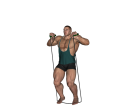 Shoulder Press - With Bands
Shoulder Press - With Bands
Benefits: This exercise isolates the anterior delt muscle.
Purpose: This exercise strengthens the front deltoid muscle area.
Beginner Front Shoulders Traps Strength Band Push Gym
General Info: The anterior (front) deltoid or shoulder is one of the three distinct heads of the deltoid anatomy. It raises the arm toward the front and rotates the arm inward.
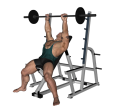 Shoulder Raise - Barbell Incline
Shoulder Raise - Barbell Incline
Benefits: This exercise is a good strength exercise for the front delts.
Purpose: This exercise strengthens the anterior (front) delts.
Beginner Anterior Delts Chest Strength Barbell Incline Bench Push Gym
General Info: The deltoid is a fan-shaped muscle group of 3 heads. The anterior (front) delt raises the arm towards the front and rotates the arm inward. The lateral (side) delt raises the arm to the side. The posterior (rear) delt raises the arm toward the rear and rotates the arm outward.
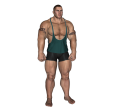 Shoulder Raise - Basic
Shoulder Raise - Basic
Benefits: This exercise tones and tightens your shoulders.
Purpose: This exercise focuses on working the entire shoulder joint and makes an excellent warm-up before any resistance or weigh training involving the shoulders.
Beginner Shoulders Lats Stretching Body Only Gym Home
General Info: Shoulder raises require little time, yet can give good benefits when done regularly. They can be done almost anywhere, without special equipment. The three heads of the deltoid muscles require regular movement to ensure their flexibility and mobility.
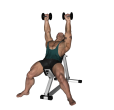 Shoulder Raise - Dumbbell Incline
Shoulder Raise - Dumbbell Incline
Benefits: This exercise is a good strength exercise for the front delts.
Purpose: This exercise strengthens the anterior (front) delts.
Beginner Anterior Delts Chest Strength Dumbbell Incline Bench Push Gym
General Info: The deltoid is a fan-shaped muscle group of 3 heads. The anterior (front) delt raises the arm towards the front and rotates the arm inward. The lateral (side) delt raises the arm to the side. The posterior (rear) delt raises the arm toward the rear and rotates the arm outward.
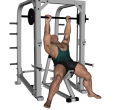 Shoulder Raise - Smith Incline
Shoulder Raise - Smith Incline
Benefits: This exercise is a good strength exercise for the front delts.
Purpose: This exercise strengthens the anterior (front) delts.
Beginner Anterior Delts Chest Strength Smith Machine Push Gym
General Info: The deltoid is a fan-shaped muscle group of 3 heads. The anterior (front) delt raises the arm towards the front and rotates the arm inward. The lateral (side) delt raises the arm to the side. The posterior (rear) delt raises the arm toward the rear and rotates the arm outward.
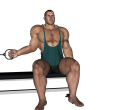 Shoulder Rotation - Cable Internal
Shoulder Rotation - Cable Internal
Benefits: This exercise isolates the lateral delt muscle and works the inward rotation of the shoulder.
Purpose: This exercise strengthens the side deltoid muscle area, specifically on the rotation of the shoulder.
Intermediate Side Shoulders Strength Cable Machine Flat Bench Pull Gym
General Info: The deltoid is a fan shaped muscle consisting of the anterior, lateral and posterior segments. The lateral (side) deltoid or shoulder is typically used raise the arm to the side. The anterior deltoid raises the arm toward the front and rotates the arm inward. The posterior deltoid raises the arm toward the rear and rotates the arm outward.
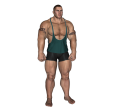 Shoulder Stretch - Basic
Shoulder Stretch - Basic
Benefits: This exercise tones and increases the flexibility of your shoulders.
Purpose: This exercise focuses on working the entire shoulder joint and makes an excellent warm-up before any resistance or weigh training involving the shoulders.
Beginner Shoulders Stretching Body Only Gym Home
General Info: Shoulder raises require little time, yet can give good benefits when done regularly. They can be done almost anywhere, without special equipment. The three heads of the deltoid muscles require regular movement to ensure their flexibility and mobility.
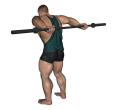 Shoulder Stretch - Round The World
Shoulder Stretch - Round The World
Benefits: This exercise tones and increases the flexibility of your shoulders.
Purpose: This exercise focuses on working the entire shoulder joint and makes an excellent warm-up before any resistance or weigh training involving the shoulders.
Beginner Shoulders Chest Stretching Body Only Gym Home
General Info: Shoulder raises require little time, yet can give good benefits when done regularly. They can be done almost anywhere, without special equipment. The three heads of the deltoid muscles require regular movement to ensure their flexibility and mobility.
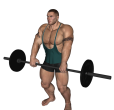 Shrug - Barbell
Shrug - Barbell
Benefits: Exercising the traps will provide a thicker, larger and more powerful back development which will help in other exercises and minimize injuries.
Purpose: This exercise develops the trapezoid muscles (upper back and shoulders).
Beginner Traps Strength Barbell Pull Gym
General Info: The trapezius is a large muscle group which is located in your upper body just below the neck and between your deltoid (shoulder) muscles. A prime means of working the traps directly is to use a shrug exercise.
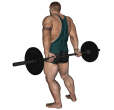 Shrug - Barbell Behind
Shrug - Barbell Behind
Benefits: Exercising the traps will provide a thicker, larger and more powerful back development which will help in other exercises and minimize injuries.
Purpose: This exercise focuses on the middle traps.
Beginner Traps Strength Barbell Pull Gym
General Info: The trapezius is a large muscle group which is located in your upper body just below the neck and between your deltoid (shoulder) muscles. A prime means of working the traps directly is to use a shrug exercise.
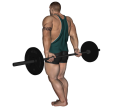 Shrug - Barbell Behind Narrow Stance
Shrug - Barbell Behind Narrow Stance
Benefits: Exercising the traps will provide a thicker, larger and more powerful back development which will help in other exercises and minimize injuries.
Purpose: This exercise focuses on the middle traps.
Intermediate Traps Quads Strength Barbell Pull Gym
General Info: The trapezius is a large muscle group which is located in your upper body just below the neck and between your deltoid (shoulder) muscles. A prime means of working the traps directly is to use a shrug exercise.
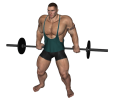 Shrug - Barbell Behind Wide Stance
Shrug - Barbell Behind Wide Stance
Benefits: Exercising the traps will provide a thicker, larger and more powerful back development which will help in other exercises and minimize injuries.
Purpose: This exercise focuses on the middle traps.
Beginner Traps Strength Barbell Pull Gym
General Info: The trapezius is a large muscle group which is located in your upper body just below the neck and between your deltoid (shoulder) muscles. A prime means of working the traps directly is to use a shrug exercise.
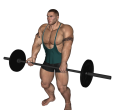 Shrug - Barbell Mixed Grip
Shrug - Barbell Mixed Grip
Benefits: Exercising the traps will provide a thicker, larger and more powerful back development which will help in other exercises and minimize injuries. The mixed grip allows you to lift heavier weights.
Purpose: This exercise develops the trapezoid muscles (upper back and shoulders).
Beginner Traps Strength Barbell Pull Gym
General Info: The trapezius is a large muscle group which is located in your upper body just below the neck and between your deltoid (shoulder) muscles. A prime means of working the traps directly is to use a shrug exercise.
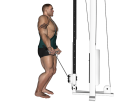 Shrug - Cable
Shrug - Cable
Benefits: Exercising the traps will provide a thicker, larger and more powerful back development which will help in other exercises and minimize injuries.
Purpose: This exercise develops the trapezoid muscles (upper back and shoulders).
Beginner Traps Strength Cable Machine Pull Gym
General Info: The trapezius is a large muscle group which is located in your upper body just below the neck and between your deltoid (shoulder) muscles. A prime means of working the traps directly is to use a shrug exercise.
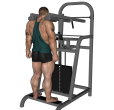 Shrug - Calf Machine
Shrug - Calf Machine
Benefits: Exercising the traps will provide a thicker, larger and more powerful back development which will help in other exercises and minimize injuries.
Purpose: This exercise develops the trapezoid muscles (upper back and shoulders).
Beginner Traps Strength Standing Calf Raise Machine Pull Gym
General Info: The trapezius is a large muscle group which is located in your upper body just below the neck and between your deltoid (shoulder) muscles. A prime means of working the traps directly is to use a shrug exercise.
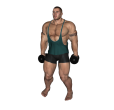 Shrug - Dumbbell
Shrug - Dumbbell
Benefits: Exercising the traps will provide a thicker, larger and more powerful back development which will help in other exercises and minimize injuries.
Purpose: This exercise develops the trapezoid muscles (upper back and shoulders).
Beginner Traps Strength Dumbbell Pull Gym
General Info: The trapezius is a large muscle group which is located in your upper body just below the neck and between your deltoid (shoulder) muscles. A prime means of working the traps directly is to use a shrug exercise.
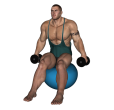 Shrug - Fitness Ball Dumbbell
Shrug - Fitness Ball Dumbbell
Benefits: Exercising the traps will provide a thicker, larger and more powerful back development which will help in other exercises and minimize injuries.
Purpose: This exercise develops the trapezoid muscles (upper back and shoulders).
Beginner Traps Strength Dumbbell Fitness Ball Pull Gym
General Info: The trapezius is a large muscle group which is located in your upper body just below the neck and between your deltoid (shoulder) muscles. A prime means of working the traps directly is to use a shrug exercise.
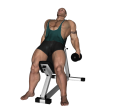 Shrug - Incline Dumbbell
Shrug - Incline Dumbbell
Benefits: Exercising the traps will provide a thicker, larger and more powerful back development which will help in other exercises and minimize injuries.
Purpose: This exercise develops the trapezoid muscles (upper back and shoulders).
Beginner Traps Strength Dumbbell Incline Bench Pull Gym
General Info: The trapezius is a large muscle group which is located in your upper body just below the neck and between your deltoid (shoulder) muscles. A prime means of working the traps directly is to use a shrug exercise.
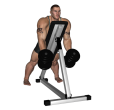 Shrug - Middle Back
Shrug - Middle Back
Benefits: Exercising the traps will provide a thicker, larger and more powerful back development which will help in other exercises and minimize injuries.
Purpose: This exercise develops the trapezoid muscles (upper back and shoulders).
Beginner Middle Back Strength Dumbbell Incline Bench Pull Gym
General Info: The trapezius is a large muscle group which is located in your upper body just below the neck and between your deltoid (shoulder) muscles. A prime means of working the traps directly is to use a shrug exercise.
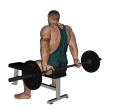 Shrug - Seated Barbell Behind
Shrug - Seated Barbell Behind
Benefits: Exercising the traps will provide a thicker, larger and more powerful back development which will help in other exercises and minimize injuries.
Purpose: This exercise focuses on the middle traps.
Intermediate Traps Strength Barbell Flat Bench Pull Gym
General Info: The trapezius is a large muscle group which is located in your upper body just below the neck and between your deltoid (shoulder) muscles. A prime means of working the traps directly is to use a shrug exercise.
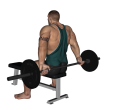 Shrug - Seated Barbell Behind Wide
Shrug - Seated Barbell Behind Wide
Benefits: Exercising the traps will provide a thicker, larger and more powerful back development which will help in other exercises and minimize injuries.
Purpose: This exercise focuses on the middle traps.
Beginner Traps Strength Barbell Flat Bench Pull Gym
General Info: The trapezius is a large muscle group which is located in your upper body just below the neck and between your deltoid (shoulder) muscles. A prime means of working the traps directly is to use a shrug exercise.
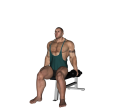 Shrug - Seated Dumbbell
Shrug - Seated Dumbbell
Benefits: Exercising the traps will provide a thicker, larger and more powerful back development which will help in other exercises and minimize injuries.
Purpose: This exercise develops the trapezoid muscles (upper back and shoulders).
Beginner Traps Strength Dumbbell Flat Bench Pull Gym
General Info: The trapezius is a large muscle group which is located in your upper body just below the neck and between your deltoid (shoulder) muscles. A prime means of working the traps directly is to use a shrug exercise.
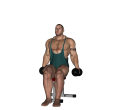 Shrug - Seated Dumbbell Narrow Stance
Shrug - Seated Dumbbell Narrow Stance
Benefits: Exercising the traps will provide a thicker, larger and more powerful back development which will help in other exercises and minimize injuries.
Purpose: This exercise develops the trapezoid muscles (upper back and shoulders).
Beginner Traps Strength Dumbbell Flat Bench Pull Gym
General Info: The trapezius is a large muscle group which is located in your upper body just below the neck and between your deltoid (shoulder) muscles. A prime means of working the traps directly is to use a shrug exercise.
 Shrug - Seated Water Bottle
Shrug - Seated Water Bottle
Benefits: Exercising the traps will provide a thicker, larger and more powerful back development which will help in other exercises and minimize injuries.
Purpose: This exercise develops the trapezoid muscles (upper back and shoulders).
Beginner Traps Strength Water Bottle Chair Pull Home
General Info: The trapezius is a large muscle group which is located in your upper body just below the neck and between your deltoid (shoulder) muscles. A prime means of working the traps directly is to use a shrug exercise.
 Shrug - Seated Water Bottle Narrow
Shrug - Seated Water Bottle Narrow
Benefits: Exercising the traps will provide a thicker, larger and more powerful back development which will help in other exercises and minimize injuries.
Purpose: This exercise develops the trapezoid muscles (upper back and shoulders).
Beginner Traps Strength Water Bottle Chair Pull Home
General Info: The trapezius is a large muscle group which is located in your upper body just below the neck and between your deltoid (shoulder) muscles. A prime means of working the traps directly is to use a shrug exercise.
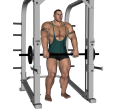 Shrug - Smith Machine
Shrug - Smith Machine
Benefits: Exercising the traps will provide a thicker, larger and more powerful back development which will help in other exercises and minimize injuries.
Purpose: This exercise develops the trapezoid muscles (upper back and shoulders).
Beginner Traps Strength Smith Machine Pull Gym
General Info: The trapezius is a large muscle group which is located in your upper body just below the neck and between your deltoid (shoulder) muscles. A prime means of working the traps directly is to use a shrug exercise.
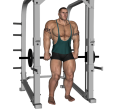 Shrug - Smith Machine Behind
Shrug - Smith Machine Behind
Benefits: Exercising the traps will provide a thicker, larger and more powerful back development which will help in other exercises and minimize injuries.
Purpose: This exercise develops the trapezoid muscles (upper back and shoulders).
Beginner Traps Strength Smith Machine Pull Gym
General Info: The trapezius is a large muscle group which is located in your upper body just below the neck and between your deltoid (shoulder) muscles. A prime means of working the traps directly is to use a shrug exercise.
 Shrug - Smith Machine Kneeling
Shrug - Smith Machine Kneeling
Benefits: Exercising the traps will provide a thicker, larger and more powerful back development which will help in other exercises and minimize injuries.
Purpose: This exercise develops the trapezoid muscles (upper back and shoulders).
Beginner Traps Strength Smith Machine Pull Gym
General Info: The trapezius is a large muscle group which is located in your upper body just below the neck and between your deltoid (shoulder) muscles. A prime means of working the traps directly is to use a shrug exercise.
 Shrug - Smith Machine Kneeling Behind
Shrug - Smith Machine Kneeling Behind
Benefits: Exercising the traps will provide a thicker, larger and more powerful back development which will help in other exercises and minimize injuries.
Purpose: This exercise develops the trapezoid muscles (upper back and shoulders).
Beginner Traps Strength Smith Machine Pull Gym
General Info: The trapezius is a large muscle group which is located in your upper body just below the neck and between your deltoid (shoulder) muscles. A prime means of working the traps directly is to use a shrug exercise.
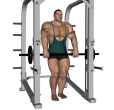 Shrug - Smith Machine Narrow Stance
Shrug - Smith Machine Narrow Stance
Benefits: Exercising the traps will provide a thicker, larger and more powerful back development which will help in other exercises and minimize injuries.
Purpose: This exercise develops the trapezoid muscles (upper back and shoulders).
Beginner Traps Strength Smith Machine Pull Gym
General Info: The trapezius is a large muscle group which is located in your upper body just below the neck and between your deltoid (shoulder) muscles. A prime means of working the traps directly is to use a shrug exercise.
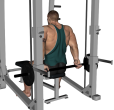 Shrug - Smith Machine Seated Behind
Shrug - Smith Machine Seated Behind
Benefits: Exercising the traps will provide a thicker, larger and more powerful back development which will help in other exercises and minimize injuries.
Purpose: This exercise focuses on the middle traps.
Beginner Traps Strength Smith Machine Flat Bench Pull Gym
General Info: The trapezius is a large muscle group which is located in your upper body just below the neck and between your deltoid (shoulder) muscles. A prime means of working the traps directly is to use a shrug exercise.
 Shrug - Water Bottle
Shrug - Water Bottle
Benefits: Exercising the traps will provide a thicker, larger and more powerful back development which will help in other exercises and minimize injuries.
Purpose: This exercise develops the trapezoid muscles (upper back and shoulders).
Beginner Traps Strength Water Bottle Pull Home
General Info: The trapezius is a large muscle group which is located in your upper body just below the neck and between your deltoid (shoulder) muscles. A prime means of working the traps directly is to use a shrug exercise.
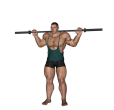 Side Bend - Barbell
Side Bend - Barbell
Benefits: Barbell side bends are a great way to work your oblique muscles, an often forgotten area which is essential for toned, six-pack abs
Purpose: This exercise works the oblique muscles (side of the waist).
Beginner Obliques Abdominals Lower Back Strength Barbell Gym Home
General Info: The abdominals consist of the abs and the obliques. The obliques and upper abs are both involved in to movements to the side. Barbell side bend exercises are simple enough that virtually anyone can use this technique safely and easily, either at home or at the gym.
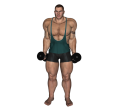 Side Bend - Dumbbell
Side Bend - Dumbbell
Benefits: Side bends are a great way to work your oblique muscles, an often forgotten area which is essential for toned, six-pack abs
Purpose: This exercise works the oblique muscles (side of the waist).
Beginner Obliques Abdominals Lower Back Strength Dumbbell Gym
General Info: The abdominals consist of the abs and the obliques. The obliques and upper abs are both involved in to movements to the side. Barbell side bend exercises are simple enough that virtually anyone can use this technique safely and easily, either at home or at the gym.
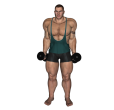 Side Bend - Dumbbell Focused
Side Bend - Dumbbell Focused
Benefits: Side bends are a great way to work your oblique muscles, an often forgotten area which is essential for toned, six-pack abs
Purpose: This exercise works the oblique muscles (side of the waist).
Beginner Obliques Abdominals Lower Back Strength Dumbbell Gym
General Info: The abdominals consist of the abs and the obliques. The obliques and upper abs are both involved in to movements to the side. Barbell side bend exercises are simple enough that virtually anyone can use this technique safely and easily, either at home or at the gym.
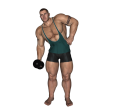 Side Bend - Dumbbell Single
Side Bend - Dumbbell Single
Benefits: Barbell side bends are a great way to work your oblique muscles, an often forgotten area which is essential for toned, six-pack abs
Purpose: This exercise works the oblique muscles (side of the waist).
Beginner Obliques Abdominals Lower Back Strength Dumbbell Gym
General Info: The abdominals consist of the abs and the obliques. The obliques and upper abs are both involved in to movements to the side. Barbell side bend exercises are simple enough that virtually anyone can use this technique safely and easily, either at home or at the gym.
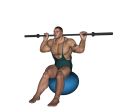 Side Bend - Fitness Ball Barbell
Side Bend - Fitness Ball Barbell
Benefits: Barbell side bends are a great way to work your oblique muscles, an often forgotten area which is essential for toned, six-pack abs
Purpose: This exercise works the oblique muscles (side of the waist).
Beginner Obliques Abdominals Lower Back Strength Barbell Fitness Ball Gym
General Info: The abdominals consist of the abs and the obliques. The obliques and upper abs are both involved in to movements to the side. Barbell side bend exercises are simple enough that virtually anyone can use this technique safely and easily, either at home or at the gym.
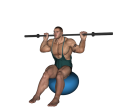 Side Bend - Fitness Ball Barbell Focused
Side Bend - Fitness Ball Barbell Focused
Benefits: Barbell side bends are a great way to work your oblique muscles, an often forgotten area which is essential for toned, six-pack abs
Purpose: This exercise works the oblique muscles (side of the waist).
Beginner Obliques Abdominals Lower Back Strength Barbell Fitness Ball Gym
General Info: The abdominals consist of the abs and the obliques. The obliques and upper abs are both involved in to movements to the side. Barbell side bend exercises are simple enough that virtually anyone can use this technique safely and easily, either at home or at the gym.
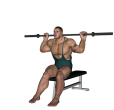 Side Bend - Seated Barbell
Side Bend - Seated Barbell
Benefits: Barbell side bends are a great way to work your oblique muscles, an often forgotten area which is essential for toned, six-pack abs
Purpose: This exercise works the oblique muscles (side of the waist).
Beginner Obliques Abdominals Lower Back Strength Barbell Flat Bench Gym Home
General Info: The abdominals consist of the abs and the obliques. The obliques and upper abs are both involved in to movements to the side. Barbell side bend exercises are simple enough that virtually anyone can use this technique safely and easily, either at home or at the gym.
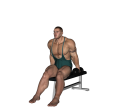 Side Bend - Seated Dumbbell
Side Bend - Seated Dumbbell
Benefits: Barbell side bends are a great way to work your oblique muscles, an often forgotten area which is essential for toned, six-pack abs
Purpose: This exercise works the oblique muscles (side of the waist).
Beginner Obliques Abdominals Lower Back Strength Dumbbell Flat Bench Gym
General Info: The abdominals consist of the abs and the obliques. The obliques and upper abs are both involved in to movements to the side. Barbell side bend exercises are simple enough that virtually anyone can use this technique safely and easily, either at home or at the gym.
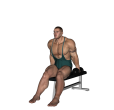 Side Bend - Seated Dumbbell Alternate
Side Bend - Seated Dumbbell Alternate
Benefits: Barbell side bends are a great way to work your oblique muscles, an often forgotten area which is essential for toned, six-pack abs
Purpose: This exercise works the oblique muscles (side of the waist).
Beginner Obliques Abdominals Lower Back Strength Dumbbell Flat Bench Gym
General Info: The abdominals consist of the abs and the obliques. The obliques and upper abs are both involved in to movements to the side. Barbell side bend exercises are simple enough that virtually anyone can use this technique safely and easily, either at home or at the gym.
 Side Bend - Seated Water Bottle
Side Bend - Seated Water Bottle
Benefits: Side bends are a great way to work your oblique muscles, an often forgotten area which is essential for toned, six-pack abs
Purpose: This exercise works the oblique muscles (side of the waist).
Beginner Obliques Abdominals Lower Back Strength Water Bottle Chair Home
General Info: The abdominals consist of the abs and the obliques. The obliques and upper abs are both involved in to movements to the side. Barbell side bend exercises are simple enough that virtually anyone can use this technique safely and easily, either at home or at the gym.
 Side Bend - Seated Water Bottle Alternate
Side Bend - Seated Water Bottle Alternate
Benefits: Side bends are a great way to work your oblique muscles, an often forgotten area which is essential for toned, six-pack abs
Purpose: This exercise works the oblique muscles (side of the waist).
Beginner Obliques Abdominals Lower Back Strength Water Bottle Chair Home
General Info: The abdominals consist of the abs and the obliques. The obliques and upper abs are both involved in to movements to the side. Barbell side bend exercises are simple enough that virtually anyone can use this technique safely and easily, either at home or at the gym.
 Side Bend - Water Bottle
Side Bend - Water Bottle
Benefits: Side bends are a great way to work your oblique muscles, an often forgotten area which is essential for toned, six-pack abs
Purpose: This exercise works the oblique muscles (side of the waist).
Beginner Obliques Abdominals Lower Back Strength Water Bottle Home
General Info: The abdominals consist of the abs and the obliques. The obliques and upper abs are both involved in to movements to the side. Barbell side bend exercises are simple enough that virtually anyone can use this technique safely and easily, either at home or at the gym.
 Side Bend - Water Bottle Focused
Side Bend - Water Bottle Focused
Benefits: Side bends are a great way to work your oblique muscles, an often forgotten area which is essential for toned, six-pack abs
Purpose: This exercise works the oblique muscles (side of the waist).
Beginner Obliques Abdominals Lower Back Strength Water Bottle Home
General Info: The abdominals consist of the abs and the obliques. The obliques and upper abs are both involved in to movements to the side. Barbell side bend exercises are simple enough that virtually anyone can use this technique safely and easily, either at home or at the gym.
 Side Bend - Weighted Ball
Side Bend - Weighted Ball
Benefits: Side bends are a great way to work your oblique muscles, an often forgotten area which is essential for toned, six-pack abs
Purpose: This exercise works the oblique muscles (side of the waist).
Intermediate Obliques Abdominals Lower Back Strength Plate Fitness Ball Pull Gym
General Info: The abdominals consist of the abs and the obliques. The obliques and upper abs are both involved in to movements to the side. Barbell side bend exercises are simple enough that virtually anyone can use this technique safely and easily, either at home or at the gym.
 Sit Up - Barbell Obliques
Sit Up - Barbell Obliques
Benefits: Sit up exercises will give you a well-defined mid-section.
Purpose: Sit up exercises strengthen the upper abdominal muscles.
Intermediate Abdominals Hip Flexors Strength Barbell Pull Gym
General Info: The abs can be divided into the abdominals themselves and the obliques. The obliques are the outer abs and are used in twisting movements. For the sake of exercising, the abdominals are sometimes divided into upper abs and lower abs (this is not a technical division but something for exercising). Both upper and lower abs are used in straight line ab exercises while the upper abs are also involved in twisting movements.
 Sit Up - Basic
Sit Up - Basic
Benefits: Sit up exercises will give you a well-defined mid-section.
Purpose: Sit up exercises strengthen the upper abdominal muscles.
Beginner Abdominals Hip Flexors Strength Body Only Pull Gym Home
General Info: The abs can be divided into the abdominals themselves and the obliques. The obliques are the outer abs and are used in twisting movements. For the sake of exercising, the abdominals are sometimes divided into upper abs and lower abs (this is not a technical division but something for exercising). Both upper and lower abs are used in straight line ab exercises while the upper abs are also involved in twisting movements.
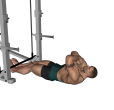 Sit Up - Crossed Arm Obliques
Sit Up - Crossed Arm Obliques
Benefits: Sit up exercises will give you a well-defined mid-section.
Purpose: Sit up exercises strengthen the upper abdominal muscles.
Beginner Obliques Abdominals Hip Flexors Strength Body Only Pull Gym Home
General Info: The abs can be divided into the abdominals themselves and the obliques. The obliques are the outer abs and are used in twisting movements. For the sake of exercising, the abdominals are sometimes divided into upper abs and lower abs (this is not a technical division but something for exercising). Both upper and lower abs are used in straight line ab exercises while the upper abs are also involved in twisting movements.
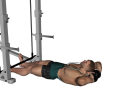 Sit Up - Dumbbell Obliques
Sit Up - Dumbbell Obliques
Benefits: Sit up exercises will give you a well-defined mid-section.
Purpose: Sit up exercises strengthen the upper abdominal muscles.
Intermediate Abdominals Hip Flexors Strength Dumbbell Pull Gym
General Info: The abs can be divided into the abdominals themselves and the obliques. The obliques are the outer abs and are used in twisting movements. For the sake of exercising, the abdominals are sometimes divided into upper abs and lower abs (this is not a technical division but something for exercising). Both upper and lower abs are used in straight line ab exercises while the upper abs are also involved in twisting movements.
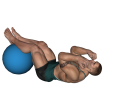 Sit Up - Fitness Ball Reverse
Sit Up - Fitness Ball Reverse
Benefits: Sit up exercises will give you a well-defined mid-section.
Purpose: Sit up exercises strengthen the upper abdominal muscles.
Beginner Abdominals Hip Flexors Strength Fitness Ball Pull Gym
General Info: The abs can be divided into the abdominals themselves and the obliques. The obliques are the outer abs and are used in twisting movements. For the sake of exercising, the abdominals are sometimes divided into upper abs and lower abs (this is not a technical division but something for exercising). Both upper and lower abs are used in straight line ab exercises while the upper abs are also involved in twisting movements.
 Sit Up - Frog
Sit Up - Frog
Benefits: Sit up exercises will give you a well-defined mid-section.
Purpose: Sit up exercises strengthen the upper abdominal muscles.
Beginner Abdominals Hip Flexors Strength Body Only Pull Gym Home
General Info: The abs can be divided into the abdominals themselves and the obliques. The obliques are the outer abs and are used in twisting movements. For the sake of exercising, the abdominals are sometimes divided into upper abs and lower abs (this is not a technical division but something for exercising). Both upper and lower abs are used in straight line ab exercises while the upper abs are also involved in twisting movements.
 Sit Up - Iso Barbell Obliques
Sit Up - Iso Barbell Obliques
Benefits: Sit up exercises will give you a well-defined mid-section.
Purpose: Sit up exercises strengthen the upper abdominal muscles.
Abdominals Hip Flexors Strength Barbell Smith Machine Pull Gym
General Info: The abs can be divided into the abdominals themselves and the obliques. The obliques are the outer abs and are used in twisting movements. For the sake of exercising, the abdominals are sometimes divided into upper abs and lower abs (this is not a technical division but something for exercising). Both upper and lower abs are used in straight line ab exercises while the upper abs are also involved in twisting movements.
 Sit Up - Iso Basic Obliques
Sit Up - Iso Basic Obliques
Benefits: Sit up exercises will give you a well-defined mid-section.
Purpose: Sit up exercises strengthen the upper abdominal muscles.
Beginner Obliques Abdominals Hip Flexors Strength Smith Machine Pull Gym
General Info: The abs can be divided into the abdominals themselves and the obliques. The obliques are the outer abs and are used in twisting movements. For the sake of exercising, the abdominals are sometimes divided into upper abs and lower abs (this is not a technical division but something for exercising). Both upper and lower abs are used in straight line ab exercises while the upper abs are also involved in twisting movements.
 Sit Up - Iso Chest Plate
Sit Up - Iso Chest Plate
Benefits: Sit up exercises will give you a well-defined mid-section.
Purpose: Sit up exercises strengthen the upper abdominal muscles.
Beginner Obliques Abdominals Hip Flexors Strength Plate Smith Machine Pull Gym
General Info: The abs can be divided into the abdominals themselves and the obliques. The obliques are the outer abs and are used in twisting movements. For the sake of exercising, the abdominals are sometimes divided into upper abs and lower abs (this is not a technical division but something for exercising). Both upper and lower abs are used in straight line ab exercises while the upper abs are also involved in twisting movements.
 Sit Up - Iso Crossed Arm
Sit Up - Iso Crossed Arm
Benefits: Sit up exercises will give you a well-defined mid-section.
Purpose: Sit up exercises strengthen the upper abdominal muscles.
Beginner Obliques Abdominals Hip Flexors Strength Smith Machine Pull Gym Home
General Info: The abs can be divided into the abdominals themselves and the obliques. The obliques are the outer abs and are used in twisting movements. For the sake of exercising, the abdominals are sometimes divided into upper abs and lower abs (this is not a technical division but something for exercising). Both upper and lower abs are used in straight line ab exercises while the upper abs are also involved in twisting movements.
 Sit Up - Iso Dumbbell
Sit Up - Iso Dumbbell
Benefits: Sit up exercises will give you a well-defined mid-section.
Purpose: Sit up exercises strengthen the upper abdominal muscles.
Intermediate Abdominals Hip Flexors Strength Dumbbell Smith Machine Pull Gym
General Info: The abs can be divided into the abdominals themselves and the obliques. The obliques are the outer abs and are used in twisting movements. For the sake of exercising, the abdominals are sometimes divided into upper abs and lower abs (this is not a technical division but something for exercising). Both upper and lower abs are used in straight line ab exercises while the upper abs are also involved in twisting movements.
 Sit Up - Iso Plate
Sit Up - Iso Plate
Benefits: Sit up exercises will give you a well-defined mid-section.
Purpose: Sit up exercises strengthen the upper abdominal muscles.
Intermediate Abdominals Hip Flexors Strength Plate Smith Machine Pull Gym
General Info: The abs can be divided into the abdominals themselves and the obliques. The obliques are the outer abs and are used in twisting movements. For the sake of exercising, the abdominals are sometimes divided into upper abs and lower abs (this is not a technical division but something for exercising). Both upper and lower abs are used in straight line ab exercises while the upper abs are also involved in twisting movements.
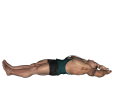 Sit Up - Jackknife
Sit Up - Jackknife
Benefits: Sit up exercises will give you a well-defined mid-section.
Purpose: Sit up exercises strengthen the upper abdominal muscles.
Intermediate Abdominals Hip Flexors Strength Body Only Pull Gym Home
General Info: The abs can be divided into the abdominals themselves and the obliques. The obliques are the outer abs and are used in twisting movements. For the sake of exercising, the abdominals are sometimes divided into upper abs and lower abs (this is not a technical division but something for exercising). Both upper and lower abs are used in straight line ab exercises while the upper abs are also involved in twisting movements.
 Sit Up - Janda
Sit Up - Janda
Benefits: Sit up exercises will give you a well-defined mid-section.
Purpose: Sit up exercises strengthen the upper abdominal muscles.
Beginner Abdominals Hip Flexors Strength Band Pull Gym Home
General Info: The abs can be divided into the abdominals themselves and the obliques. The obliques are the outer abs and are used in twisting movements. For the sake of exercising, the abdominals are sometimes divided into upper abs and lower abs (this is not a technical division but something for exercising). Both upper and lower abs are used in straight line ab exercises while the upper abs are also involved in twisting movements.
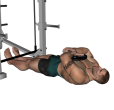 Sit Up - Plate Obliques
Sit Up - Plate Obliques
Benefits: Sit up exercises will give you a well-defined mid-section.
Purpose: Sit up exercises strengthen the upper abdominal muscles.
Beginner Obliques Abdominals Hip Flexors Strength Plate Smith Machine Pull Gym
General Info: The abs can be divided into the abdominals themselves and the obliques. The obliques are the outer abs and are used in twisting movements. For the sake of exercising, the abdominals are sometimes divided into upper abs and lower abs (this is not a technical division but something for exercising). Both upper and lower abs are used in straight line ab exercises while the upper abs are also involved in twisting movements.
 Sit Up - Press
Sit Up - Press
Benefits: Sit up exercises will give you a well-defined mid-section.
Purpose: Sit up exercises strengthen the upper abdominal and the shoulder muscles.
Abdominals Hip Flexors Shoulders Strength Barbell Abdominal Bench Gym Home
General Info: The abs can be divided into the abdominals themselves and the obliques. The obliques are the outer abs and are used in twisting movements. For the sake of exercising, the abdominals are sometimes divided into upper abs and lower abs (this is not a technical division but something for exercising). Both upper and lower abs are used in straight line ab exercises while the upper abs are also involved in twisting movements.
 Sit Up - Smith Machine Barbell
Sit Up - Smith Machine Barbell
Benefits: Sit up exercises will give you a well-defined mid-section.
Purpose: Sit up exercises strengthen the upper abdominal muscles.
Abdominals Hip Flexors Strength Barbell Smith Machine Pull Gym
General Info: The abs can be divided into the abdominals themselves and the obliques. The obliques are the outer abs and are used in twisting movements. For the sake of exercising, the abdominals are sometimes divided into upper abs and lower abs (this is not a technical division but something for exercising). Both upper and lower abs are used in straight line ab exercises while the upper abs are also involved in twisting movements.
 Sit Up - Smith Machine Basic
Sit Up - Smith Machine Basic
Benefits: Sit up exercises will give you a well-defined mid-section.
Purpose: Sit up exercises strengthen the upper abdominal muscles.
Beginner Obliques Abdominals Hip Flexors Strength Smith Machine Pull Gym
General Info: The abs can be divided into the abdominals themselves and the obliques. The obliques are the outer abs and are used in twisting movements. For the sake of exercising, the abdominals are sometimes divided into upper abs and lower abs (this is not a technical division but something for exercising). Both upper and lower abs are used in straight line ab exercises while the upper abs are also involved in twisting movements.
 Sit Up - Smith Machine Chest Plate
Sit Up - Smith Machine Chest Plate
Benefits: Sit up exercises will give you a well-defined mid-section.
Purpose: Sit up exercises strengthen the upper abdominal muscles.
Beginner Obliques Abdominals Hip Flexors Strength Plate Smith Machine Pull Gym
General Info: The abs can be divided into the abdominals themselves and the obliques. The obliques are the outer abs and are used in twisting movements. For the sake of exercising, the abdominals are sometimes divided into upper abs and lower abs (this is not a technical division but something for exercising). Both upper and lower abs are used in straight line ab exercises while the upper abs are also involved in twisting movements.
 Sit Up - Smith Machine Crossed Arm
Sit Up - Smith Machine Crossed Arm
Benefits: Sit up exercises will give you a well-defined mid-section.
Purpose: Sit up exercises strengthen the upper abdominal muscles.
Beginner Obliques Abdominals Hip Flexors Strength Smith Machine Pull Gym Home
General Info: The abs can be divided into the abdominals themselves and the obliques. The obliques are the outer abs and are used in twisting movements. For the sake of exercising, the abdominals are sometimes divided into upper abs and lower abs (this is not a technical division but something for exercising). Both upper and lower abs are used in straight line ab exercises while the upper abs are also involved in twisting movements.
 Sit Up - Smith Machine Dumbbell
Sit Up - Smith Machine Dumbbell
Benefits: Sit up exercises will give you a well-defined mid-section.
Purpose: Sit up exercises strengthen the upper abdominal muscles.
Intermediate Abdominals Hip Flexors Strength Dumbbell Smith Machine Pull Gym
General Info: The abs can be divided into the abdominals themselves and the obliques. The obliques are the outer abs and are used in twisting movements. For the sake of exercising, the abdominals are sometimes divided into upper abs and lower abs (this is not a technical division but something for exercising). Both upper and lower abs are used in straight line ab exercises while the upper abs are also involved in twisting movements.
 Sit Up - Smith Machine Plate
Sit Up - Smith Machine Plate
Benefits: Sit up exercises will give you a well-defined mid-section.
Purpose: Sit up exercises strengthen the upper abdominal muscles.
Intermediate Abdominals Hip Flexors Strength Plate Smith Machine Pull Gym
General Info: The abs can be divided into the abdominals themselves and the obliques. The obliques are the outer abs and are used in twisting movements. For the sake of exercising, the abdominals are sometimes divided into upper abs and lower abs (this is not a technical division but something for exercising). Both upper and lower abs are used in straight line ab exercises while the upper abs are also involved in twisting movements.
 Sit Up - Water Bottle Obliques
Sit Up - Water Bottle Obliques
Benefits: Sit up exercises will give you a well-defined mid-section.
Purpose: Sit up exercises strengthen the upper abdominal muscles.
Intermediate Abdominals Hip Flexors Strength Water Bottle Pull Home
General Info: The abs can be divided into the abdominals themselves and the obliques. The obliques are the outer abs and are used in twisting movements. For the sake of exercising, the abdominals are sometimes divided into upper abs and lower abs (this is not a technical division but something for exercising). Both upper and lower abs are used in straight line ab exercises while the upper abs are also involved in twisting movements.
 Sit Up - Weighted With Bands
Sit Up - Weighted With Bands
Benefits: Sit up exercises will give you a well-defined mid-section.
Purpose: Sit up exercises strengthen the upper abdominal muscles.
Beginner Abdominals Hip Flexors Strength Band Decline Bench Pull Gym Home
General Info: The abs can be divided into the abdominals themselves and the obliques. The obliques are the outer abs and are used in twisting movements. For the sake of exercising, the abdominals are sometimes divided into upper abs and lower abs (this is not a technical division but something for exercising). Both upper and lower abs are used in straight line ab exercises while the upper abs are also involved in twisting movements.
 Snatch - Balance
Snatch - Balance
Benefits: The press is a highly effective compound upper-body exercise.
Purpose: This exercise is a good exercise for building up and strengthening the shoulder region.
Intermediate Shoulders Triceps Traps Glutes Hamstrings Quads Strength Barbell Push Compound Gym
General Info: The Deltoids is a fan-shaped muscle. The Anterior (Front) Deltoid raises the arm toward the front of the body and rotates the arm inward. The Lateral (Side) Deltoid raises the arm to the side. The Posterior (Rear) Deltoid raises the arm toward the rear and rotates the arm outward.
 Snatch - Basic
Snatch - Basic
Benefits: The press is a highly effective compound upper-body exercise.
Purpose: This exercise is a good exercise for building up and strengthening the shoulder region.
Intermediate Shoulders Triceps Traps Strength Barbell Push Compound Gym
General Info: The Deltoids is a fan-shaped muscle. The Anterior (Front) Deltoid raises the arm toward the front of the body and rotates the arm inward. The Lateral (Side) Deltoid raises the arm to the side. The Posterior (Rear) Deltoid raises the arm toward the rear and rotates the arm outward.
 Snatch - Deadlift
Snatch - Deadlift
Benefits: This exercise involves many other muscles.
Purpose: This exercise builds overall strength in the lower body.
Intermediate Lower Back Glutes Hamstrings Calves Quads Forearms Lats Middle Back Traps Strength Barbell Pull Compound Gym
General Info: The muscles of the lower back straighten the spine. They work together with the abdominals to keep the spine upright. The Barbell Deadlift is considered to be the king of exercises. No other exercise will work your body so much.
 Snatch - From Blocks
Snatch - From Blocks
Benefits: The press is a highly effective compound upper-body exercise.
Purpose: This exercise is a good exercise for building up and strengthening the shoulder region.
Intermediate Shoulders Triceps Traps Strength Barbell Push Compound Gym
General Info: The Deltoids is a fan-shaped muscle. The Anterior (Front) Deltoid raises the arm toward the front of the body and rotates the arm inward. The Lateral (Side) Deltoid raises the arm to the side. The Posterior (Rear) Deltoid raises the arm toward the rear and rotates the arm outward.
 Snatch - Hang
Snatch - Hang
Benefits: It is the single best exercise to develop full body strength and increase your fat-burning metabolism.
Purpose: To develop core strength of the lower and middle body.
Intermediate Quads Glutes Hamstrings Calves Lower Back Traps Strength Barbell Push Compound Gym
General Info: The quads are a set of four muscles in the upper front thigh. All four muscles work to straighten the knee. One of the four (rectus femoris) also helps to bend the hip. Squats are considered a vital exercise for increasing the strength and size of the legs and butt.
 Snatch - Hang Below Knees
Snatch - Hang Below Knees
Benefits: It is the single best exercise to develop full body strength and increase your fat-burning metabolism.
Purpose: To develop core strength of the lower and middle body.
Intermediate Quads Glutes Hamstrings Calves Lower Back Traps Strength Barbell Push Compound Gym
General Info: The quads are a set of four muscles in the upper front thigh. All four muscles work to straighten the knee. One of the four (rectus femoris) also helps to bend the hip. Squats are considered a vital exercise for increasing the strength and size of the legs and butt.
 Snatch - Power
Snatch - Power
Benefits: This exercise involves many other muscles.
Purpose: This exercise builds overall strength in the lower body.
Intermediate Lower Back Glutes Hamstrings Calves Quads Forearms Lats Middle Back Traps Strength Barbell Pull Compound Gym
General Info: The muscles of the lower back straighten the spine. They work together with the abdominals to keep the spine upright. The Barbell Deadlift is considered to be the king of exercises. No other exercise will work your body so much.
 Snatch - Power From Blocks
Snatch - Power From Blocks
Benefits: This exercise involves many other muscles.
Purpose: This exercise builds overall strength in the lower body.
Intermediate Lower Back Glutes Hamstrings Calves Quads Forearms Lats Middle Back Traps Strength Barbell Pull Compound Gym
General Info: The muscles of the lower back straighten the spine. They work together with the abdominals to keep the spine upright. The Barbell Deadlift is considered to be the king of exercises. No other exercise will work your body so much.
 Snatch - Split
Snatch - Split
Benefits: The press is a highly effective compound upper-body exercise.
Purpose: This exercise is a good exercise for building up and strengthening the shoulder region.
Intermediate Shoulders Triceps Traps Strength Barbell Push Compound Gym
General Info: The Deltoids is a fan-shaped muscle. The Anterior (Front) Deltoid raises the arm toward the front of the body and rotates the arm inward. The Lateral (Side) Deltoid raises the arm to the side. The Posterior (Rear) Deltoid raises the arm toward the rear and rotates the arm outward.
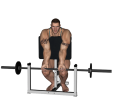 Spider Curl - Barbell Close Grip
Spider Curl - Barbell Close Grip
Benefits: Spider curls do a perfect job of placing maximum tension on the biceps in the fully contracted position. As an alternate, spider curls can be done with a barbell instead of dumbbells.
Purpose: This exercise works the biceps muscles but focuses also on the brachioradialis (a muscle that crosses the elbow joint and assists in rotating the forearm).
Beginner Biceps Forearms Shoulders Traps Strength Barbell Preacher Bench Pull Gym
General Info: The biceps muscle is a straight muscle with 2 heads. The long head crosses both the elbow and shoulder joints and bends the elbow and raises the arm forward at the shoulder. The short head of the biceps crosses the elbow joint and, in conjunction with the brachioradialis, supinates the hand.
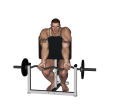 Spider Curl - Basic
Spider Curl - Basic
Benefits: Spider curls do a perfect job of placing maximum tension on the biceps in the fully contracted position. As an alternate, spider curls can be done with a barbell instead of dumbbells.
Purpose: This exercise works the biceps muscles but focuses also on the brachioradialis (a muscle that crosses the elbow joint and assists in rotating the forearm.
Beginner Biceps Forearms Shoulders Traps Strength EZ Bar Preacher Bench Pull Gym
General Info: The biceps muscle is a straight muscle with 2 heads. The long head crosses both the elbow and shoulder joints and bends the elbow and raises the arm forward at the shoulder. The short head of the biceps crosses the elbow joint and, in conjunction with the brachioradialis, supinates the hand.
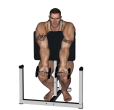 Spider Curl - Dumbbell
Spider Curl - Dumbbell
Benefits: Spider curls do a perfect job of placing maximum tension on the biceps in the fully contracted position. As an alternate, spider curls can be done with a barbell instead of dumbbells.
Purpose: This exercise works the biceps muscles but focuses also on the brachioradialis (a muscle that crosses the elbow joint and assists in rotating the forearm.
Beginner Biceps Forearms Shoulders Traps Strength Dumbbell Preacher Bench Pull Gym
General Info: The biceps muscle is a straight muscle with 2 heads. The long head crosses both the elbow and shoulder joints and bends the elbow and raises the arm forward at the shoulder. The short head of the biceps crosses the elbow joint and, in conjunction with the brachioradialis, supinates the hand.
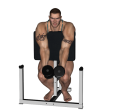 Spider Curl - Dumbbell Hammer
Spider Curl - Dumbbell Hammer
Benefits: Spider curls do a perfect job of placing maximum tension on the biceps in the fully contracted position. Using a hammer grip places the hands in a very strong position.
Purpose: This exercise works the biceps muscles but focuses also on the brachioradialis (a muscle that crosses the elbow joint and assists in rotating the forearm.
Beginner Biceps Forearms Shoulders Traps Strength Dumbbell Preacher Bench Pull Gym
General Info: The biceps muscle is a straight muscle with 2 heads. The long head crosses both the elbow and shoulder joints and bends the elbow and raises the arm forward at the shoulder. The short head of the biceps crosses the elbow joint and, in conjunction with the brachioradialis, supinates the hand.
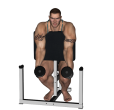 Spider Curl - Dumbbell Hammer Alternate
Spider Curl - Dumbbell Hammer Alternate
Benefits: This exercise isolates the biceps so that momentum does not come into play.
Purpose: This exercise strengthens the biceps.
Beginner Biceps Forearms Shoulders Traps Strength Dumbbell Preacher Bench Pull Gym
General Info: The biceps muscle is a straight muscle with 2 heads. The long head crosses both the elbow and shoulder joints and bends the elbow and raises the arm forward at the shoulder. The short head of the biceps crosses the elbow joint and, in conjunction with the brachioradialis, supinates the hand.
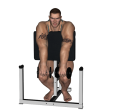 Spider Curl - Dumbbell Reverse
Spider Curl - Dumbbell Reverse
Benefits: Spider curls do a perfect job of placing maximum tension on the biceps in the fully contracted position. The reverse grip also makes the exercise more difficult.
Purpose: This exercise works the biceps muscles but focuses also on the brachioradialis (a muscle that crosses the elbow joint and assists in rotating the forearm.
Beginner Biceps Forearms Shoulders Traps Strength Dumbbell Preacher Bench Pull Gym
General Info: The biceps muscle is a straight muscle with 2 heads. The long head crosses both the elbow and shoulder joints and bends the elbow and raises the arm forward at the shoulder. The short head of the biceps crosses the elbow joint and, in conjunction with the brachioradialis, supinates the hand.
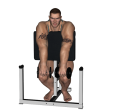 Spider Curl - Dumbbell Zottman
Spider Curl - Dumbbell Zottman
Benefits: Spider curls do a perfect job of placing maximum tension on the biceps in the fully contracted position. Rotating during this exercise also involves the forearms.
Purpose: This exercise works the biceps muscles but focuses also on the brachioradialis (a muscle that crosses the elbow joint and assists in rotating the forearm.
Beginner Biceps Forearms Shoulders Traps Strength Dumbbell Preacher Bench Pull Gym
General Info: The biceps muscle is a straight muscle with 2 heads. The long head crosses both the elbow and shoulder joints and bends the elbow and raises the arm forward at the shoulder. The short head of the biceps crosses the elbow joint and, in conjunction with the brachioradialis, supinates the hand.
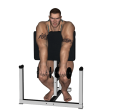 Spider Curl - Dumbbell Zottman Alternate
Spider Curl - Dumbbell Zottman Alternate
Benefits: Spider curls do a perfect job of placing maximum tension on the biceps in the fully contracted position. Rotating during this exercise also involves the forearms.
Purpose: This exercise works the biceps muscles but focuses also on the brachioradialis (a muscle that crosses the elbow joint and assists in rotating the forearm.
Beginner Biceps Forearms Shoulders Traps Strength Dumbbell Preacher Bench Pull Gym
General Info: The biceps muscle is a straight muscle with 2 heads. The long head crosses both the elbow and shoulder joints and bends the elbow and raises the arm forward at the shoulder. The short head of the biceps crosses the elbow joint and, in conjunction with the brachioradialis, supinates the hand.
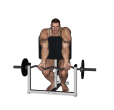 Spider Curl - EZ Bar
Spider Curl - EZ Bar
Benefits: Spider curls do a perfect job of placing maximum tension on the biceps in the fully contracted position.
Purpose: This exercise works the biceps muscles but focuses also on the brachioradialis (a muscle that crosses the elbow joint and assists in rotating the forearm.
Beginner Biceps Forearms Shoulders Traps Strength EZ Bar Preacher Bench Pull Gym
General Info: The biceps muscle is a straight muscle with 2 heads. The long head crosses both the elbow and shoulder joints and bends the elbow and raises the arm forward at the shoulder. The short head of the biceps crosses the elbow joint and, in conjunction with the brachioradialis, supinates the hand.
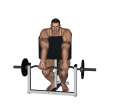 Spider Curl - EZ Bar Reverse
Spider Curl - EZ Bar Reverse
Benefits: Spider curls do a perfect job of placing maximum tension on the biceps in the fully contracted position. The reverse grip makes the exercise more difficult.
Purpose: This exercise works the biceps muscles but focuses also on the brachioradialis (a muscle that crosses the elbow joint and assists in rotating the forearm.
Beginner Biceps Forearms Shoulders Traps Strength EZ Bar Preacher Bench Pull Gym
General Info: The biceps muscle is a straight muscle with 2 heads. The long head crosses both the elbow and shoulder joints and bends the elbow and raises the arm forward at the shoulder. The short head of the biceps crosses the elbow joint and, in conjunction with the brachioradialis, supinates the hand.
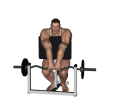 Spider Curl - EZ Bar Reverse Close Grip
Spider Curl - EZ Bar Reverse Close Grip
Benefits: Spider curls do a perfect job of placing maximum tension on the biceps in the fully contracted position. The reverse grip makes the exercise more difficult.
Purpose: This exercise works the biceps muscles but focuses also on the brachioradialis (a muscle that crosses the elbow joint and assists in rotating the forearm.
Beginner Biceps Forearms Shoulders Traps Strength EZ Bar Preacher Bench Pull Gym
General Info: The biceps muscle is a straight muscle with 2 heads. The long head crosses both the elbow and shoulder joints and bends the elbow and raises the arm forward at the shoulder. The short head of the biceps crosses the elbow joint and, in conjunction with the brachioradialis, supinates the hand.
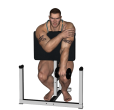 Spider Curl - Reverse Single Dumbbell
Spider Curl - Reverse Single Dumbbell
Benefits: Spider curls do a perfect job of placing maximum tension on the biceps in the fully contracted position. The reverse grip makes the exercise more difficult.
Purpose: This exercise works the biceps muscles but focuses also on the brachioradialis (a muscle that crosses the elbow joint and assists in rotating the forearm.
Beginner Biceps Forearms Shoulders Traps Strength Dumbbell Preacher Bench Pull Gym
General Info: The biceps muscle is a straight muscle with 2 heads. The long head crosses both the elbow and shoulder joints and bends the elbow and raises the arm forward at the shoulder. The short head of the biceps crosses the elbow joint and, in conjunction with the brachioradialis, supinates the hand.
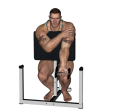 Spider Curl - Single Dumbbell
Spider Curl - Single Dumbbell
Benefits: Spider curls do a perfect job of placing maximum tension on the biceps in the fully contracted position.
Purpose: This exercise works the biceps muscles but focuses also on the brachioradialis (a muscle that crosses the elbow joint and assists in rotating the forearm.
Beginner Biceps Forearms Shoulders Traps Strength Dumbbell Preacher Bench Pull Gym
General Info: The biceps muscle is a straight muscle with 2 heads. The long head crosses both the elbow and shoulder joints and bends the elbow and raises the arm forward at the shoulder. The short head of the biceps crosses the elbow joint and, in conjunction with the brachioradialis, supinates the hand.
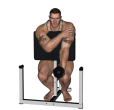 Spider Curl - Single Dumbbell Hammer
Spider Curl - Single Dumbbell Hammer
Benefits: Spider curls do a perfect job of placing maximum tension on the biceps in the fully contracted position.
Purpose: This exercise works the biceps muscles but focuses also on the brachioradialis (a muscle that crosses the elbow joint and assists in rotating the forearm.
Beginner Biceps Forearms Shoulders Traps Strength Dumbbell Preacher Bench Pull Gym
General Info: The biceps muscle is a straight muscle with 2 heads. The long head crosses both the elbow and shoulder joints and bends the elbow and raises the arm forward at the shoulder. The short head of the biceps crosses the elbow joint and, in conjunction with the brachioradialis, supinates the hand.
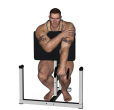 Spider Curl - Single Dumbbell Zottman
Spider Curl - Single Dumbbell Zottman
Benefits: Spider curls do a perfect job of placing maximum tension on the biceps in the fully contracted position.
Purpose: This exercise works the biceps muscles but focuses also on the brachioradialis (a muscle that crosses the elbow joint and assists in rotating the forearm.
Beginner Biceps Forearms Shoulders Traps Strength Dumbbell Preacher Bench Pull Gym
General Info: The biceps muscle is a straight muscle with 2 heads. The long head crosses both the elbow and shoulder joints and bends the elbow and raises the arm forward at the shoulder. The short head of the biceps crosses the elbow joint and, in conjunction with the brachioradialis, supinates the hand.
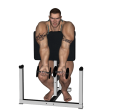 Spider Curl - Zottman Reverse
Spider Curl - Zottman Reverse
Benefits: Spider curls do a perfect job of placing maximum tension on the biceps in the fully contracted position. The reverse grip makes the exercise more difficult.
Purpose: This exercise works the biceps muscles but focuses also on the brachioradialis (a muscle that crosses the elbow joint and assists in rotating the forearm.
Beginner Biceps Forearms Shoulders Traps Strength Dumbbell Preacher Bench Pull Gym
General Info: The biceps muscle is a straight muscle with 2 heads. The long head crosses both the elbow and shoulder joints and bends the elbow and raises the arm forward at the shoulder. The short head of the biceps crosses the elbow joint and, in conjunction with the brachioradialis, supinates the hand.
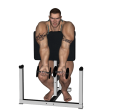 Spider Curl - Zottman Reverse Alternate
Spider Curl - Zottman Reverse Alternate
Benefits: Spider curls do a perfect job of placing maximum tension on the biceps in the fully contracted position. The reverse grip makes the exercise more difficult.
Purpose: This exercise works the biceps muscles but focuses also on the brachioradialis (a muscle that crosses the elbow joint and assists in rotating the forearm.
Beginner Biceps Forearms Shoulders Traps Strength Dumbbell Preacher Bench Pull Gym
General Info: The biceps muscle is a straight muscle with 2 heads. The long head crosses both the elbow and shoulder joints and bends the elbow and raises the arm forward at the shoulder. The short head of the biceps crosses the elbow joint and, in conjunction with the brachioradialis, supinates the hand.
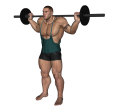 Squat - Barbell
Squat - Barbell
Benefits: It is the single best exercise to develop full body strength and increase your fat-burning metabolism.
Purpose: To develop core strength of the lower and middle body.
Intermediate Quads Glutes Hamstrings Calves Lower Back Strength Barbell Squat Rack Push Compound Gym
General Info: The quads are a set of four muscles in the upper front thigh. All four muscles work to straighten the knee. One of the four (rectus femoris) also helps to bend the hip. Squats are considered a vital exercise for increasing the strength and size of the legs and butt.
 Squat - Barbell Bulgarian
Squat - Barbell Bulgarian
Benefits: It is the single best exercise to develop full body strength and increase your fat-burning metabolism.
Purpose: To develop core strength of the lower and middle body.
Intermediate Quads Glutes Hamstrings Calves Lower Back Strength Barbell Flat Bench Squat Rack Push Compound Gym
General Info: The quads are a set of four muscles in the upper front thigh. All four muscles work to straighten the knee. One of the four (rectus femoris) also helps to bend the hip. Squats are considered a vital exercise for increasing the strength and size of the legs and butt.
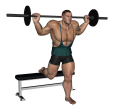 Squat - Barbell Bulgarian Deep
Squat - Barbell Bulgarian Deep
Benefits: It is the single best exercise to develop full body strength and increase your fat-burning metabolism.
Purpose: To develop core strength of the lower and middle body.
Intermediate Quads Glutes Hamstrings Calves Lower Back Strength Barbell Flat Bench Squat Rack Push Compound Gym
General Info: The quads are a set of four muscles in the upper front thigh. All four muscles work to straighten the knee. One of the four (rectus femoris) also helps to bend the hip. Squats are considered a vital exercise for increasing the strength and size of the legs and butt.
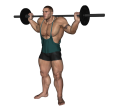 Squat - Barbell Frog
Squat - Barbell Frog
Benefits: It is the single best exercise to develop full body strength and increase your fat-burning metabolism.
Purpose: To develop core strength of the lower and middle body.
Intermediate Quads Glutes Hamstrings Calves Lower Back Strength Barbell Squat Rack Push Compound Gym
General Info: The quads are a set of four muscles in the upper front thigh. All four muscles work to straighten the knee. One of the four (rectus femoris) also helps to bend the hip. Squats are considered a vital exercise for increasing the strength and size of the legs and butt.
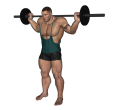 Squat - Barbell Full
Squat - Barbell Full
Benefits: It is the single best exercise to develop full body strength and increase your fat-burning metabolism. This exercise is necessary for Powerlifting competitions.
Purpose: To develop core strength of the lower and middle body.
Intermediate Quads Glutes Hamstrings Calves Lower Back Strength Barbell Squat Rack Push Compound Gym
General Info: The quads are a set of four muscles in the upper front thigh. All four muscles work to straighten the knee. One of the four (rectus femoris) also helps to bend the hip. Squats are considered a vital exercise for increasing the strength and size of the legs and butt.
 Squat - Barbell Hack Narrow Stance
Squat - Barbell Hack Narrow Stance
Benefits: It is an excellent exercise to isolate the quads and hamstrings.
Purpose: This exercise develops core strength of the lower body.
Intermediate Quads Hamstrings Calves Strength Barbell Push Compound Gym
General Info: The quads are a set of four muscles in the upper front thigh. All four muscles work to straighten the knee. One of the four (rectus femoris) also helps to bend the hip. Squats are considered a vital exercise for increasing the strength and size of the legs and butt.
 Squat - Barbell Kneeling
Squat - Barbell Kneeling
Benefits: It is the single best exercise to develop full body strength and increase your fat-burning metabolism.
Purpose: To develop core strength of the lower and middle body.
Intermediate Quads Glutes Hamstrings Calves Lower Back Strength Barbell Push Compound Gym
General Info: The quads are a set of four muscles in the upper front thigh. All four muscles work to straighten the knee. One of the four (rectus femoris) also helps to bend the hip. Squats are considered a vital exercise for increasing the strength and size of the legs and butt.
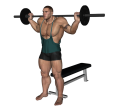 Squat - Barbell To A Bench
Squat - Barbell To A Bench
Benefits: It is the single best exercise to develop full body strength and increase your fat-burning metabolism. The use of the bench ensures that you do not go too low, reducing the stress on your knees.
Purpose: To develop core strength of the lower and middle body.
Intermediate Quads Glutes Hamstrings Calves Lower Back Strength Barbell Flat Bench Squat Rack Push Compound Gym
General Info: The quads are a set of four muscles in the upper front thigh. All four muscles work to straighten the knee. One of the four (rectus femoris) also helps to bend the hip. Squats are considered a vital exercise for increasing the strength and size of the legs and butt.
 Squat - Barbell Wall
Squat - Barbell Wall
Benefits: It is the single best exercise to develop full body strength and increase your fat-burning metabolism.
Purpose: To develop core strength of the lower and middle body.
Intermediate Quads Glutes Hamstrings Calves Lower Back Strength Barbell Push Compound Gym
General Info: The quads are a set of four muscles in the upper front thigh. All four muscles work to straighten the knee. One of the four (rectus femoris) also helps to bend the hip. Squats are considered a vital exercise for increasing the strength and size of the legs and butt.
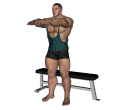 Squat - Basic Bench
Squat - Basic Bench
Benefits: It is the single best exercise to develop full body strength and increase your fat-burning metabolism.
Purpose: To develop core strength of the lower and middle body.
Beginner Quads Glutes Hamstrings Calves Lower Back Strength Flat Bench Push Compound Gym
General Info: The quads are a set of four muscles in the upper front thigh. All four muscles work to straighten the knee. One of the four (rectus femoris) also helps to bend the hip. Squats are considered a vital exercise for increasing the strength and size of the legs and butt.
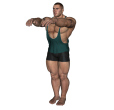 Squat - Basic Standing Close Feet
Squat - Basic Standing Close Feet
Benefits: A squat with close feet will focus on the outside thighs.
Purpose: To develop core strength of the lower and middle body.
Beginner Quads Glutes Hamstrings Calves Lower Back Strength Body Only Push Compound Gym
General Info: The quads are a set of four muscles in the upper front thigh. All four muscles work to straighten the knee. One of the four (rectus femoris) also helps to bend the hip. Squats are considered a vital exercise for increasing the strength and size of the legs and butt.
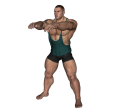 Squat - Basic Standing Wide Feet
Squat - Basic Standing Wide Feet
Benefits: A squat with wide feet will focus on the inside thighs.
Purpose: To develop core strength of the lower and middle body.
Beginner Quads Glutes Hamstrings Calves Lower Back Strength Body Only Push Compound Gym
General Info: The quads are a set of four muscles in the upper front thigh. All four muscles work to straighten the knee. One of the four (rectus femoris) also helps to bend the hip. Squats are considered a vital exercise for increasing the strength and size of the legs and butt.
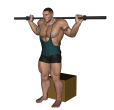 Squat - Box
Squat - Box
Benefits: It is the single best exercise to develop full body strength and increase your fat-burning metabolism.
Purpose: To develop core strength of the lower and middle body.
Intermediate Quads Glutes Hamstrings Calves Lower Back Strength Barbell Squat Rack Push Compound Gym
General Info: The quads are a set of four muscles in the upper front thigh. All four muscles work to straighten the knee. One of the four (rectus femoris) also helps to bend the hip. Squats are considered a vital exercise for increasing the strength and size of the legs and butt.
 Squat - Box With Bands
Squat - Box With Bands
Benefits: It is the single best exercise to develop full body strength and increase your fat-burning metabolism.
Purpose: To develop core strength of the lower and middle body.
Intermediate Quads Glutes Hamstrings Calves Lower Back Strength Barbell Band Power Rack Push Compound Gym
General Info: The quads are a set of four muscles in the upper front thigh. All four muscles work to straighten the knee. One of the four (rectus femoris) also helps to bend the hip. Squats are considered a vital exercise for increasing the strength and size of the legs and butt.
 Squat - Bulgarian
Squat - Bulgarian
Benefits: It is the single best exercise to develop full body strength and increase your fat-burning metabolism.
Purpose: To develop core strength of the lower and middle body.
Beginner Quads Glutes Hamstrings Calves Lower Back Strength Flat Bench Push Compound Gym
General Info: The quads are a set of four muscles in the upper front thigh. All four muscles work to straighten the knee. One of the four (rectus femoris) also helps to bend the hip. Squats are considered a vital exercise for increasing the strength and size of the legs and butt.
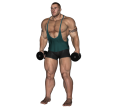 Squat - Dumbbell
Squat - Dumbbell
Benefits: It is the single best exercise to develop full body strength and increase your fat-burning metabolism.
Purpose: To develop core strength of the lower and middle body.
Intermediate Quads Glutes Hamstrings Calves Lower Back Strength Dumbbell Push Compound Gym
General Info: The quads are a set of four muscles in the upper front thigh. All four muscles work to straighten the knee. One of the four (rectus femoris) also helps to bend the hip. Squats are considered a vital exercise for increasing the strength and size of the legs and butt.
 Squat - Dumbbell Bulgarian
Squat - Dumbbell Bulgarian
Benefits: It is the single best exercise to develop full body strength and increase your fat-burning metabolism.
Purpose: To develop core strength of the lower and middle body.
Intermediate Quads Glutes Hamstrings Calves Lower Back Strength Dumbbell Flat Bench Push Compound Gym
General Info: The quads are a set of four muscles in the upper front thigh. All four muscles work to straighten the knee. One of the four (rectus femoris) also helps to bend the hip. Squats are considered a vital exercise for increasing the strength and size of the legs and butt.
 Squat - Dumbbell Bulgarian Deep
Squat - Dumbbell Bulgarian Deep
Benefits: It is the single best exercise to develop full body strength and increase your fat-burning metabolism.
Purpose: To develop core strength of the lower and middle body.
Intermediate Quads Glutes Hamstrings Calves Lower Back Strength Dumbbell Flat Bench Push Compound Gym
General Info: The quads are a set of four muscles in the upper front thigh. All four muscles work to straighten the knee. One of the four (rectus femoris) also helps to bend the hip. Squats are considered a vital exercise for increasing the strength and size of the legs and butt.
 Squat - Dumbbell Close Stance
Squat - Dumbbell Close Stance
Benefits: It is the single best exercise to develop full body strength and increase your fat-burning metabolism.
Purpose: To develop core strength of the lower and middle body.
Intermediate Quads Glutes Hamstrings Calves Lower Back Strength Dumbbell Push Compound Gym
General Info: The quads are a set of four muscles in the upper front thigh. All four muscles work to straighten the knee. One of the four (rectus femoris) also helps to bend the hip. Squats are considered a vital exercise for increasing the strength and size of the legs and butt.
 Squat - Dumbbell Deep
Squat - Dumbbell Deep
Benefits: It is the single best exercise to develop full body strength and increase your fat-burning metabolism.
Purpose: To develop core strength of the lower and middle body.
Intermediate Quads Glutes Hamstrings Calves Lower Back Strength Dumbbell Push Compound Gym
General Info: The quads are a set of four muscles in the upper front thigh. All four muscles work to straighten the knee. One of the four (rectus femoris) also helps to bend the hip. Squats are considered a vital exercise for increasing the strength and size of the legs and butt.
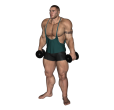 Squat - Dumbbell Frog
Squat - Dumbbell Frog
Benefits: It is the single best exercise to develop full body strength and increase your fat-burning metabolism.
Purpose: To develop core strength of the lower and middle body.
Intermediate Quads Glutes Hamstrings Calves Lower Back Strength Dumbbell Push Compound Gym
General Info: The quads are a set of four muscles in the upper front thigh. All four muscles work to straighten the knee. One of the four (rectus femoris) also helps to bend the hip. Squats are considered a vital exercise for increasing the strength and size of the legs and butt.
 Squat - Dumbbell Kneeling
Squat - Dumbbell Kneeling
Benefits: It is the single best exercise to develop full body strength and increase your fat-burning metabolism.
Purpose: To develop core strength of the lower and middle body.
Intermediate Quads Glutes Hamstrings Calves Lower Back Strength Dumbbell Push Compound Gym
General Info: The quads are a set of four muscles in the upper front thigh. All four muscles work to straighten the knee. One of the four (rectus femoris) also helps to bend the hip. Squats are considered a vital exercise for increasing the strength and size of the legs and butt.
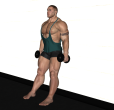 Squat - Dumbbell Wall
Squat - Dumbbell Wall
Benefits: It is the single best exercise to develop full body strength and increase your fat-burning metabolism.
Purpose: To develop core strength of the lower and middle body.
Intermediate Quads Glutes Hamstrings Calves Lower Back Strength Dumbbell Push Compound Gym
General Info: The quads are a set of four muscles in the upper front thigh. All four muscles work to straighten the knee. One of the four (rectus femoris) also helps to bend the hip. Squats are considered a vital exercise for increasing the strength and size of the legs and butt.
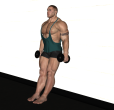 Squat - Dumbbell Wall Close
Squat - Dumbbell Wall Close
Benefits: It is the single best exercise to develop full body strength and increase your fat-burning metabolism.
Purpose: To develop core strength of the lower and middle body.
Intermediate Quads Glutes Hamstrings Calves Lower Back Strength Dumbbell Push Compound Gym
General Info: The quads are a set of four muscles in the upper front thigh. All four muscles work to straighten the knee. One of the four (rectus femoris) also helps to bend the hip. Squats are considered a vital exercise for increasing the strength and size of the legs and butt.
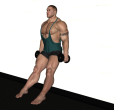 Squat - Dumbbell Wall Out
Squat - Dumbbell Wall Out
Benefits: It is the single best exercise to develop full body strength and increase your fat-burning metabolism.
Purpose: To develop core strength of the lower and middle body.
Intermediate Quads Glutes Hamstrings Calves Lower Back Strength Dumbbell Push Compound Gym
General Info: The quads are a set of four muscles in the upper front thigh. All four muscles work to straighten the knee. One of the four (rectus femoris) also helps to bend the hip. Squats are considered a vital exercise for increasing the strength and size of the legs and butt.
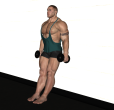 Squat - Dumbbell Wall Out Close
Squat - Dumbbell Wall Out Close
Benefits: It is the single best exercise to develop full body strength and increase your fat-burning metabolism.
Purpose: To develop core strength of the lower and middle body.
Intermediate Quads Glutes Hamstrings Calves Lower Back Strength Dumbbell Push Compound Gym
General Info: The quads are a set of four muscles in the upper front thigh. All four muscles work to straighten the knee. One of the four (rectus femoris) also helps to bend the hip. Squats are considered a vital exercise for increasing the strength and size of the legs and butt.
 Squat - Fitness Ball Dumbbell Wall
Squat - Fitness Ball Dumbbell Wall
Benefits: It is the single best exercise to develop full body strength and increase your fat-burning metabolism.
Purpose: To develop core strength of the lower and middle body.
Intermediate Quads Glutes Hamstrings Calves Lower Back Strength Dumbbell Fitness Ball Push Compound Gym
General Info: The quads are a set of four muscles in the upper front thigh. All four muscles work to straighten the knee. One of the four (rectus femoris) also helps to bend the hip. Squats are considered a vital exercise for increasing the strength and size of the legs and butt.
 Squat - Fitness Ball Dumbbell Wall Deep
Squat - Fitness Ball Dumbbell Wall Deep
Benefits: It is the single best exercise to develop full body strength and increase your fat-burning metabolism.
Purpose: To develop core strength of the lower and middle body.
Intermediate Quads Glutes Hamstrings Calves Lower Back Strength Dumbbell Fitness Ball Push Compound Gym
General Info: The quads are a set of four muscles in the upper front thigh. All four muscles work to straighten the knee. One of the four (rectus femoris) also helps to bend the hip. Squats are considered a vital exercise for increasing the strength and size of the legs and butt.
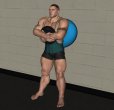 Squat - Fitness Ball Plate Wall
Squat - Fitness Ball Plate Wall
Benefits: It is the single best exercise to develop full body strength and increase your fat-burning metabolism.
Purpose: To develop core strength of the lower and middle body.
Intermediate Quads Glutes Hamstrings Calves Lower Back Strength Plate Fitness Ball Push Compound Gym
General Info: The quads are a set of four muscles in the upper front thigh. All four muscles work to straighten the knee. One of the four (rectus femoris) also helps to bend the hip. Squats are considered a vital exercise for increasing the strength and size of the legs and butt.
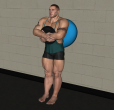 Squat - Fitness Ball Plate Wall Close Feet
Squat - Fitness Ball Plate Wall Close Feet
Benefits: It is the single best exercise to develop full body strength and increase your fat-burning metabolism.
Purpose: To develop core strength of the lower and middle body.
Intermediate Quads Glutes Hamstrings Calves Lower Back Strength Plate Fitness Ball Push Compound Gym
General Info: The quads are a set of four muscles in the upper front thigh. All four muscles work to straighten the knee. One of the four (rectus femoris) also helps to bend the hip. Squats are considered a vital exercise for increasing the strength and size of the legs and butt.
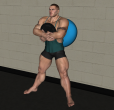 Squat - Fitness Ball Plate Wall Wide Feet
Squat - Fitness Ball Plate Wall Wide Feet
Benefits: It is the single best exercise to develop full body strength and increase your fat-burning metabolism.
Purpose: To develop core strength of the lower and middle body.
Intermediate Quads Glutes Hamstrings Calves Lower Back Strength Plate Fitness Ball Push Compound Gym
General Info: The quads are a set of four muscles in the upper front thigh. All four muscles work to straighten the knee. One of the four (rectus femoris) also helps to bend the hip. Squats are considered a vital exercise for increasing the strength and size of the legs and butt.
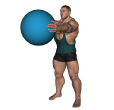 Squat - Fitness Ball Standing
Squat - Fitness Ball Standing
Benefits: It is the single best exercise to develop full body strength and increase your fat-burning metabolism.
Purpose: To develop core strength of the lower and middle body.
Intermediate Quads Glutes Hamstrings Calves Lower Back Strength Fitness Ball Push Compound Gym
General Info: The quads are a set of four muscles in the upper front thigh. All four muscles work to straighten the knee. One of the four (rectus femoris) also helps to bend the hip. Squats are considered a vital exercise for increasing the strength and size of the legs and butt.
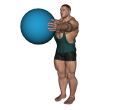 Squat - Fitness Ball Standing Close Feet
Squat - Fitness Ball Standing Close Feet
Benefits: It is the single best exercise to develop full body strength and increase your fat-burning metabolism.
Purpose: To develop core strength of the lower and middle body.
Intermediate Quads Glutes Hamstrings Calves Lower Back Strength Fitness Ball Push Compound Gym
General Info: The quads are a set of four muscles in the upper front thigh. All four muscles work to straighten the knee. One of the four (rectus femoris) also helps to bend the hip. Squats are considered a vital exercise for increasing the strength and size of the legs and butt.
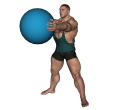 Squat - Fitness Ball Standing Wide Feet
Squat - Fitness Ball Standing Wide Feet
Benefits: It is the single best exercise to develop full body strength and increase your fat-burning metabolism.
Purpose: To develop core strength of the lower and middle body.
Intermediate Quads Glutes Hamstrings Calves Lower Back Strength Fitness Ball Push Compound Gym
General Info: The quads are a set of four muscles in the upper front thigh. All four muscles work to straighten the knee. One of the four (rectus femoris) also helps to bend the hip. Squats are considered a vital exercise for increasing the strength and size of the legs and butt.
 Squat - Frankenstein
Squat - Frankenstein
Benefits: It is the single best exercise to develop full body strength and increase your fat-burning metabolism.
Purpose: To develop core strength of the lower and middle body.
Intermediate Quads Glutes Hamstrings Calves Lower Back Strength Barbell Push Compound Gym
General Info: The quads are a set of four muscles in the upper front thigh. All four muscles work to straighten the knee. One of the four (rectus femoris) also helps to bend the hip. Squats are considered a vital exercise for increasing the strength and size of the legs and butt.
 Squat - Freehand Jump
Squat - Freehand Jump
Benefits: It is the single best exercise to develop full body strength and increase your fat-burning metabolism.
Purpose: To develop core strength of the lower and middle body.
Beginner Quads Glutes Hamstrings Calves Lower Back Strength Body Only Push Compound Gym
General Info: The quads are a set of four muscles in the upper front thigh. All four muscles work to straighten the knee. One of the four (rectus femoris) also helps to bend the hip. Squats are considered a vital exercise for increasing the strength and size of the legs and butt.
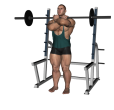 Squat - Front Barbell
Squat - Front Barbell
Benefits: It is the single best exercise to develop full body strength and increase your fat-burning metabolism.
Purpose: To develop core strength of the lower and middle body.
Intermediate Quads Glutes Hamstrings Calves Lower Back Strength Barbell Squat Rack Push Compound Gym
General Info: The quads are a set of four muscles in the upper front thigh. All four muscles work to straighten the knee. One of the four (rectus femoris) also helps to bend the hip. Squats are considered a vital exercise for increasing the strength and size of the legs and butt.
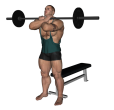 Squat - Front Barbell To A Bench
Squat - Front Barbell To A Bench
Benefits: It is the single best exercise to develop full body strength and increase your fat-burning metabolism.
Purpose: To develop core strength of the lower and middle body.
Intermediate Quads Glutes Hamstrings Calves Lower Back Strength Barbell Squat Rack Flat Bench Push Compound Gym
General Info: The quads are a set of four muscles in the upper front thigh. All four muscles work to straighten the knee. One of the four (rectus femoris) also helps to bend the hip. Squats are considered a vital exercise for increasing the strength and size of the legs and butt.
 Squat - Front Clean Grip
Squat - Front Clean Grip
Benefits: It is the single best exercise to develop full body strength and increase your fat-burning metabolism.
Purpose: To develop core strength of the lower and middle body.
Intermediate Quads Glutes Hamstrings Calves Lower Back Strength Barbell Squat Rack Push Compound Gym
General Info: The quads are a set of four muscles in the upper front thigh. All four muscles work to straighten the knee. One of the four (rectus femoris) also helps to bend the hip. Squats are considered a vital exercise for increasing the strength and size of the legs and butt.
 Squat - Goblet
Squat - Goblet
Benefits: It is the single best exercise to develop full body strength and increase your fat-burning metabolism.
Purpose: To develop core strength of the lower and middle body.
Quads Glutes Hamstrings Calves Lower Back Strength Kettlebell Push Compound Gym
General Info: The quads are a set of four muscles in the upper front thigh. All four muscles work to straighten the knee. One of the four (rectus femoris) also helps to bend the hip. Squats are considered a vital exercise for increasing the strength and size of the legs and butt.
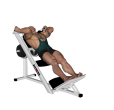 Squat - Hack
Squat - Hack
Benefits: It is an excellent exercise to isolate the quads and hamstrings.
Purpose: This exercise develops core strength of the lower body.
Beginner Quads Hamstrings Calves Strength Hack Squat Push Compound Gym
General Info: The quads are a set of four muscles in the upper front thigh. All four muscles work to straighten the knee. One of the four (rectus femoris) also helps to bend the hip. Squats are considered a vital exercise for increasing the strength and size of the legs and butt.
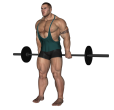 Squat - Hack Barbell
Squat - Hack Barbell
Benefits: It is an excellent exercise to isolate the quads and hamstrings.
Purpose: This exercise develops core strength of the lower body.
Beginner Quads Hamstrings Calves Strength Barbell Push Compound Gym
General Info: The quads are a set of four muscles in the upper front thigh. All four muscles work to straighten the knee. One of the four (rectus femoris) also helps to bend the hip. Squats are considered a vital exercise for increasing the strength and size of the legs and butt.
 Squat - Jefferson
Squat - Jefferson
Benefits: It is an excellent exercise to isolate the quads and hamstrings.
Purpose: This exercise develops core strength of the lower body.
Intermediate Quads Hamstrings Calves Strength Barbell Push Compound Gym
General Info: The quads are a set of four muscles in the upper front thigh. All four muscles work to straighten the knee. One of the four (rectus femoris) also helps to bend the hip. Squats are considered a vital exercise for increasing the strength and size of the legs and butt.
 Squat - Jerk
Squat - Jerk
Benefits: It is the single best exercise to develop full body strength and increase your fat-burning metabolism.
Purpose: To develop core strength of the lower and middle body.
Quads Glutes Hamstrings Calves Lower Back Strength Barbell Push Compound Gym
General Info: The quads are a set of four muscles in the upper front thigh. All four muscles work to straighten the knee. One of the four (rectus femoris) also helps to bend the hip. Squats are considered a vital exercise for increasing the strength and size of the legs and butt.
 Squat - Jerk Dip
Squat - Jerk Dip
Benefits: This movement strengthens the dip portion of the jerk.
Purpose: To develop core strength of the lower and middle body.
Intermediate Quads Glutes Hamstrings Calves Lower Back Strength Barbell Push Compound Gym
General Info: The quads are a set of four muscles in the upper front thigh. All four muscles work to straighten the knee. One of the four (rectus femoris) also helps to bend the hip. Squats are considered a vital exercise for increasing the strength and size of the legs and butt.
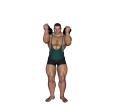 Squat - Kettlebell
Squat - Kettlebell
Benefits: It is the single best exercise to develop full body strength and increase your fat-burning metabolism.
Purpose: To develop core strength of the lower and middle body.
Intermediate Quads Glutes Hamstrings Calves Lower Back Strength Kettlebell Push Compound Gym
General Info: The quads are a set of four muscles in the upper front thigh. All four muscles work to straighten the knee. One of the four (rectus femoris) also helps to bend the hip. Squats are considered a vital exercise for increasing the strength and size of the legs and butt.
 Squat - Kneeling
Squat - Kneeling
Benefits: It is the single best exercise to develop full body strength and increase your fat-burning metabolism.
Purpose: To develop core strength of the lower and middle body.
Intermediate Quads Glutes Hamstrings Calves Lower Back Strength Barbell Push Compound Gym
General Info: The quads are a set of four muscles in the upper front thigh. All four muscles work to straighten the knee. One of the four (rectus femoris) also helps to bend the hip. Squats are considered a vital exercise for increasing the strength and size of the legs and butt.
 Squat - Kneeling Jump
Squat - Kneeling Jump
Benefits: It is the single best exercise to develop full body strength and increase your fat-burning metabolism.
Purpose: To develop core strength of the lower and middle body.
Intermediate Quads Glutes Hamstrings Calves Lower Back Strength Barbell Push Compound Gym
General Info: The quads are a set of four muscles in the upper front thigh. All four muscles work to straighten the knee. One of the four (rectus femoris) also helps to bend the hip. Squats are considered a vital exercise for increasing the strength and size of the legs and butt.
 Squat - Lying Machine
Squat - Lying Machine
Benefits: It is an excellent exercise to isolate the quads and hamstrings. There is less chance of injury doing a leg press than doing a squat.
Purpose: This exercise develops core strength of the lower body.
Beginner Quads Hamstrings Calves Strength Leg Press Machine Push Compound Gym
General Info: The quads are a set of four muscles in the upper front thigh. All four muscles work to straighten the knee. One of the four (rectus femoris) also helps to bend the hip. Squats are considered a vital exercise for increasing the strength and size of the legs and butt.
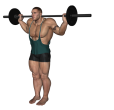 Squat - Narrow Stance
Squat - Narrow Stance
Benefits: It is the single best exercise to develop full body strength and increase your fat-burning metabolism.
Purpose: To develop core strength of the lower and middle body.
Intermediate Quads Glutes Hamstrings Calves Lower Back Strength Barbell Squat Rack Push Compound Gym
General Info: The quads are a set of four muscles in the upper front thigh. All four muscles work to straighten the knee. One of the four (rectus femoris) also helps to bend the hip. Squats are considered a vital exercise for increasing the strength and size of the legs and butt.
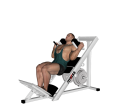 Squat - Narrow Stance Hack
Squat - Narrow Stance Hack
Benefits: It is an excellent exercise to isolate the quads and hamstrings.
Purpose: This exercise develops core strength of the lower body.
Beginner Quads Hamstrings Calves Strength Hack Squat Push Compound Gym
General Info: The quads are a set of four muscles in the upper front thigh. All four muscles work to straighten the knee. One of the four (rectus femoris) also helps to bend the hip. Squats are considered a vital exercise for increasing the strength and size of the legs and butt.
 Squat - Olympic
Squat - Olympic
Benefits: It is the single best exercise to develop full body strength and increase your fat-burning metabolism.
Purpose: To develop core strength of the lower and middle body.
Intermediate Quads Glutes Hamstrings Calves Lower Back Strength Barbell Squat Rack Push Compound Gym
General Info: The quads are a set of four muscles in the upper front thigh. All four muscles work to straighten the knee. One of the four (rectus femoris) also helps to bend the hip. Squats are considered a vital exercise for increasing the strength and size of the legs and butt.
 Squat - One Leg
Squat - One Leg
Benefits: It is the single best exercise to develop full body strength and increase your fat-burning metabolism.
Purpose: To develop core strength of the lower and middle body.
Quads Glutes Hamstrings Calves Lower Back Strength Barbell Flat Bench Squat Rack Push Compound Gym
General Info: The quads are a set of four muscles in the upper front thigh. All four muscles work to straighten the knee. One of the four (rectus femoris) also helps to bend the hip. Squats are considered a vital exercise for increasing the strength and size of the legs and butt.
 Squat - Overhead
Squat - Overhead
Benefits: It is the single best exercise to develop full body strength and increase your fat-burning metabolism.
Purpose: To develop core strength of the lower and middle body.
Intermediate Quads Glutes Hamstrings Calves Lower Back Strength Barbell Squat Rack Push Compound Gym
General Info: The quads are a set of four muscles in the upper front thigh. All four muscles work to straighten the knee. One of the four (rectus femoris) also helps to bend the hip. Squats are considered a vital exercise for increasing the strength and size of the legs and butt.
 Squat - Plate Bulgarian
Squat - Plate Bulgarian
Benefits: It is the single best exercise to develop full body strength and increase your fat-burning metabolism.
Purpose: To develop core strength of the lower and middle body.
Intermediate Quads Glutes Hamstrings Calves Lower Back Strength Plate Flat Bench Push Compound Gym
General Info: The quads are a set of four muscles in the upper front thigh. All four muscles work to straighten the knee. One of the four (rectus femoris) also helps to bend the hip. Squats are considered a vital exercise for increasing the strength and size of the legs and butt.
 Squat - Plate Bulgarian Deep
Squat - Plate Bulgarian Deep
Benefits: It is the single best exercise to develop full body strength and increase your fat-burning metabolism.
Purpose: To develop core strength of the lower and middle body.
Intermediate Quads Glutes Hamstrings Calves Lower Back Strength Plate Flat Bench Push Compound Gym
General Info: The quads are a set of four muscles in the upper front thigh. All four muscles work to straighten the knee. One of the four (rectus femoris) also helps to bend the hip. Squats are considered a vital exercise for increasing the strength and size of the legs and butt.
 Squat - Plate Deep Plie
Squat - Plate Deep Plie
Benefits: It is the single best exercise to develop full body strength and increase your fat-burning metabolism.
Purpose: To develop core strength of the lower and middle body.
Intermediate Quads Glutes Hamstrings Calves Lower Back Strength Plate Push Compound Gym
General Info: The quads are a set of four muscles in the upper front thigh. All four muscles work to straighten the knee. One of the four (rectus femoris) also helps to bend the hip. Squats are considered a vital exercise for increasing the strength and size of the legs and butt.
 Squat - Plate Frog
Squat - Plate Frog
Benefits: It is the single best exercise to develop full body strength and increase your fat-burning metabolism.
Purpose: To develop core strength of the lower and middle body.
Intermediate Quads Glutes Hamstrings Calves Lower Back Strength Plate Push Compound Gym
General Info: The quads are a set of four muscles in the upper front thigh. All four muscles work to straighten the knee. One of the four (rectus femoris) also helps to bend the hip. Squats are considered a vital exercise for increasing the strength and size of the legs and butt.
 Squat - Plate Kneeling
Squat - Plate Kneeling
Benefits: It is the single best exercise to develop full body strength and increase your fat-burning metabolism.
Purpose: To develop core strength of the lower and middle body.
Intermediate Quads Glutes Hamstrings Calves Lower Back Strength Plate Push Compound Gym
General Info: The quads are a set of four muscles in the upper front thigh. All four muscles work to straighten the knee. One of the four (rectus femoris) also helps to bend the hip. Squats are considered a vital exercise for increasing the strength and size of the legs and butt.
 Squat - Plate Plie
Squat - Plate Plie
Benefits: It is the single best exercise to develop full body strength and increase your fat-burning metabolism.
Purpose: To develop core strength of the lower and middle body.
Intermediate Quads Glutes Hamstrings Calves Lower Back Strength Plate Push Compound Gym
General Info: The quads are a set of four muscles in the upper front thigh. All four muscles work to straighten the knee. One of the four (rectus femoris) also helps to bend the hip. Squats are considered a vital exercise for increasing the strength and size of the legs and butt.
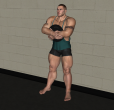 Squat - Plate Wall
Squat - Plate Wall
Benefits: It is the single best exercise to develop full body strength and increase your fat-burning metabolism.
Purpose: To develop core strength of the lower and middle body.
Intermediate Quads Glutes Hamstrings Calves Lower Back Strength Plate Push Compound Gym
General Info: The quads are a set of four muscles in the upper front thigh. All four muscles work to straighten the knee. One of the four (rectus femoris) also helps to bend the hip. Squats are considered a vital exercise for increasing the strength and size of the legs and butt.
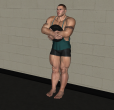 Squat - Plate Wall Close
Squat - Plate Wall Close
Benefits: It is the single best exercise to develop full body strength and increase your fat-burning metabolism.
Purpose: To develop core strength of the lower and middle body.
Intermediate Quads Glutes Hamstrings Calves Lower Back Strength Plate Push Compound Gym
General Info: The quads are a set of four muscles in the upper front thigh. All four muscles work to straighten the knee. One of the four (rectus femoris) also helps to bend the hip. Squats are considered a vital exercise for increasing the strength and size of the legs and butt.
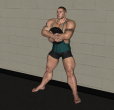 Squat - Plate Wall Wide Stance
Squat - Plate Wall Wide Stance
Benefits: It is the single best exercise to develop full body strength and increase your fat-burning metabolism.
Purpose: To develop core strength of the lower and middle body.
Intermediate Quads Glutes Hamstrings Calves Lower Back Strength Plate Push Compound Gym
General Info: The quads are a set of four muscles in the upper front thigh. All four muscles work to straighten the knee. One of the four (rectus femoris) also helps to bend the hip. Squats are considered a vital exercise for increasing the strength and size of the legs and butt.
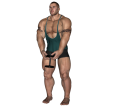 Squat - Plie Dumbbell
Squat - Plie Dumbbell
Benefits: It is the single best exercise to develop full body strength and increase your fat-burning metabolism.
Purpose: To develop core strength of the lower and middle body.
Intermediate Quads Glutes Hamstrings Calves Lower Back Strength Dumbbell Push Compound Gym
General Info: The quads are a set of four muscles in the upper front thigh. All four muscles work to straighten the knee. One of the four (rectus femoris) also helps to bend the hip. Squats are considered a vital exercise for increasing the strength and size of the legs and butt.
 Squat - Plie Water Bottle
Squat - Plie Water Bottle
Benefits: It is the single best exercise to develop full body strength and increase your fat-burning metabolism.
Purpose: To develop core strength of the lower and middle body.
Intermediate Quads Glutes Hamstrings Calves Lower Back Strength Water Bottle Push Compound Home
General Info: The quads are a set of four muscles in the upper front thigh. All four muscles work to straighten the knee. One of the four (rectus femoris) also helps to bend the hip. Squats are considered a vital exercise for increasing the strength and size of the legs and butt.
 Squat - Reverse Band Box
Squat - Reverse Band Box
Benefits: It is the single best exercise to develop full body strength and increase your fat-burning metabolism.
Purpose: To develop core strength of the lower and middle body.
Intermediate Quads Glutes Hamstrings Calves Lower Back Strength Barbell Band Squat Rack Push Compound Gym
General Info: The quads are a set of four muscles in the upper front thigh. All four muscles work to straighten the knee. One of the four (rectus femoris) also helps to bend the hip. Squats are considered a vital exercise for increasing the strength and size of the legs and butt.
 Squat - Reverse Band Power
Squat - Reverse Band Power
Benefits: It is the single best exercise to develop full body strength and increase your fat-burning metabolism.
Purpose: To develop core strength of the lower and middle body.
Intermediate Quads Glutes Hamstrings Calves Lower Back Strength Barbell Band Squat Rack Push Compound Gym
General Info: The quads are a set of four muscles in the upper front thigh. All four muscles work to straighten the knee. One of the four (rectus femoris) also helps to bend the hip. Squats are considered a vital exercise for increasing the strength and size of the legs and butt.
 Squat - Single Fitness Ball Dumbbell Deep
Squat - Single Fitness Ball Dumbbell Deep
Benefits: It is the single best exercise to develop full body strength and increase your fat-burning metabolism.
Purpose: To develop core strength of the lower and middle body.
Intermediate Quads Glutes Hamstrings Calves Lower Back Strength Dumbbell Fitness Ball Push Compound Gym
General Info: The quads are a set of four muscles in the upper front thigh. All four muscles work to straighten the knee. One of the four (rectus femoris) also helps to bend the hip. Squats are considered a vital exercise for increasing the strength and size of the legs and butt.
 Squat - Single Leg Ball Barbell Wall
Squat - Single Leg Ball Barbell Wall
Benefits: It is the single best exercise to develop full body strength and increase your fat-burning metabolism.
Purpose: To develop core strength of the lower and middle body.
Intermediate Quads Glutes Hamstrings Calves Lower Back Strength Barbell Fitness Ball Push Compound Gym
General Info: The quads are a set of four muscles in the upper front thigh. All four muscles work to straighten the knee. One of the four (rectus femoris) also helps to bend the hip. Squats are considered a vital exercise for increasing the strength and size of the legs and butt.
 Squat - Single Leg Ball Barbell Wall Deep
Squat - Single Leg Ball Barbell Wall Deep
Benefits: It is the single best exercise to develop full body strength and increase your fat-burning metabolism.
Purpose: To develop core strength of the lower and middle body.
Intermediate Quads Glutes Hamstrings Calves Lower Back Strength Barbell Fitness Ball Push Compound Gym
General Info: The quads are a set of four muscles in the upper front thigh. All four muscles work to straighten the knee. One of the four (rectus femoris) also helps to bend the hip. Squats are considered a vital exercise for increasing the strength and size of the legs and butt.
 Squat - Single Leg Ball Dumbbell Wall
Squat - Single Leg Ball Dumbbell Wall
Benefits: It is the single best exercise to develop full body strength and increase your fat-burning metabolism.
Purpose: To develop core strength of the lower and middle body.
Intermediate Quads Glutes Hamstrings Calves Lower Back Strength Dumbbell Fitness Ball Push Compound Gym
General Info: The quads are a set of four muscles in the upper front thigh. All four muscles work to straighten the knee. One of the four (rectus femoris) also helps to bend the hip. Squats are considered a vital exercise for increasing the strength and size of the legs and butt.
 Squat - Single Leg Ball Plate Wall
Squat - Single Leg Ball Plate Wall
Benefits: It is the single best exercise to develop full body strength and increase your fat-burning metabolism.
Purpose: To develop core strength of the lower and middle body.
Intermediate Quads Glutes Hamstrings Calves Lower Back Strength Plate Fitness Ball Push Compound Gym
General Info: The quads are a set of four muscles in the upper front thigh. All four muscles work to straighten the knee. One of the four (rectus femoris) also helps to bend the hip. Squats are considered a vital exercise for increasing the strength and size of the legs and butt.
 Squat - Single Leg Ball Plate Wall Deep
Squat - Single Leg Ball Plate Wall Deep
Benefits: It is the single best exercise to develop full body strength and increase your fat-burning metabolism.
Purpose: To develop core strength of the lower and middle body.
Intermediate Quads Glutes Hamstrings Calves Lower Back Strength Plate Fitness Ball Push Compound Gym
General Info: The quads are a set of four muscles in the upper front thigh. All four muscles work to straighten the knee. One of the four (rectus femoris) also helps to bend the hip. Squats are considered a vital exercise for increasing the strength and size of the legs and butt.
 Squat - Single Leg Barbell Wall
Squat - Single Leg Barbell Wall
Benefits: It is the single best exercise to develop full body strength and increase your fat-burning metabolism.
Purpose: To develop core strength of the lower and middle body.
Intermediate Quads Glutes Hamstrings Calves Lower Back Strength Barbell Push Compound Gym
General Info: The quads are a set of four muscles in the upper front thigh. All four muscles work to straighten the knee. One of the four (rectus femoris) also helps to bend the hip. Squats are considered a vital exercise for increasing the strength and size of the legs and butt.
 Squat - Single Leg Barbell Wall Deep
Squat - Single Leg Barbell Wall Deep
Benefits: It is the single best exercise to develop full body strength and increase your fat-burning metabolism.
Purpose: To develop core strength of the lower and middle body.
Intermediate Quads Glutes Hamstrings Calves Lower Back Strength Barbell Push Compound Gym
General Info: The quads are a set of four muscles in the upper front thigh. All four muscles work to straighten the knee. One of the four (rectus femoris) also helps to bend the hip. Squats are considered a vital exercise for increasing the strength and size of the legs and butt.
 Squat - Single Leg Dumbbell Wall
Squat - Single Leg Dumbbell Wall
Benefits: It is the single best exercise to develop full body strength and increase your fat-burning metabolism.
Purpose: To develop core strength of the lower and middle body.
Intermediate Quads Glutes Hamstrings Calves Lower Back Strength Dumbbell Push Compound Gym
General Info: The quads are a set of four muscles in the upper front thigh. All four muscles work to straighten the knee. One of the four (rectus femoris) also helps to bend the hip. Squats are considered a vital exercise for increasing the strength and size of the legs and butt.
 Squat - Single Leg Dumbbell Wall Deep
Squat - Single Leg Dumbbell Wall Deep
Benefits: It is the single best exercise to develop full body strength and increase your fat-burning metabolism.
Purpose: To develop core strength of the lower and middle body.
Intermediate Quads Glutes Hamstrings Calves Lower Back Strength Dumbbell Push Compound Gym
General Info: The quads are a set of four muscles in the upper front thigh. All four muscles work to straighten the knee. One of the four (rectus femoris) also helps to bend the hip. Squats are considered a vital exercise for increasing the strength and size of the legs and butt.
 Squat - Single Leg Plate Free Standing
Squat - Single Leg Plate Free Standing
Benefits: It is the single best exercise to develop full body strength and increase your fat-burning metabolism.
Purpose: To develop core strength of the lower and middle body.
Intermediate Quads Glutes Hamstrings Calves Lower Back Strength Plate Push Compound Gym
General Info: The quads are a set of four muscles in the upper front thigh. All four muscles work to straighten the knee. One of the four (rectus femoris) also helps to bend the hip. Squats are considered a vital exercise for increasing the strength and size of the legs and butt.
 Squat - Single Leg Plate Standing Deep
Squat - Single Leg Plate Standing Deep
Benefits: It is the single best exercise to develop full body strength and increase your fat-burning metabolism.
Purpose: To develop core strength of the lower and middle body.
Intermediate Quads Glutes Hamstrings Calves Lower Back Strength Plate Push Compound Gym
General Info: The quads are a set of four muscles in the upper front thigh. All four muscles work to straighten the knee. One of the four (rectus femoris) also helps to bend the hip. Squats are considered a vital exercise for increasing the strength and size of the legs and butt.
 Squat - Single Leg Plate Wall
Squat - Single Leg Plate Wall
Benefits: It is the single best exercise to develop full body strength and increase your fat-burning metabolism.
Purpose: To develop core strength of the lower and middle body.
Intermediate Quads Glutes Hamstrings Calves Lower Back Strength Plate Push Compound Gym
General Info: The quads are a set of four muscles in the upper front thigh. All four muscles work to straighten the knee. One of the four (rectus femoris) also helps to bend the hip. Squats are considered a vital exercise for increasing the strength and size of the legs and butt.
 Squat - Single Leg Plate Wall Deep
Squat - Single Leg Plate Wall Deep
Benefits: It is the single best exercise to develop full body strength and increase your fat-burning metabolism.
Purpose: To develop core strength of the lower and middle body.
Intermediate Quads Glutes Hamstrings Calves Lower Back Strength Plate Push Compound Gym
General Info: The quads are a set of four muscles in the upper front thigh. All four muscles work to straighten the knee. One of the four (rectus femoris) also helps to bend the hip. Squats are considered a vital exercise for increasing the strength and size of the legs and butt.
 Squat - Single Leg Standing Barbell
Squat - Single Leg Standing Barbell
Benefits: It is the single best exercise to develop full body strength and increase your fat-burning metabolism.
Purpose: To develop core strength of the lower and middle body.
Intermediate Quads Glutes Hamstrings Calves Lower Back Strength Barbell Push Compound Gym
General Info: The quads are a set of four muscles in the upper front thigh. All four muscles work to straighten the knee. One of the four (rectus femoris) also helps to bend the hip. Squats are considered a vital exercise for increasing the strength and size of the legs and butt.
 Squat - Single Leg Standing Barbell Deep
Squat - Single Leg Standing Barbell Deep
Benefits: It is the single best exercise to develop full body strength and increase your fat-burning metabolism.
Purpose: To develop core strength of the lower and middle body.
Intermediate Quads Glutes Hamstrings Calves Lower Back Strength Barbell Push Compound Gym
General Info: The quads are a set of four muscles in the upper front thigh. All four muscles work to straighten the knee. One of the four (rectus femoris) also helps to bend the hip. Squats are considered a vital exercise for increasing the strength and size of the legs and butt.
 Squat - Single Leg Standing Bottle Deep
Squat - Single Leg Standing Bottle Deep
Benefits: It is the single best exercise to develop full body strength and increase your fat-burning metabolism.
Purpose: To develop core strength of the lower and middle body.
Intermediate Quads Glutes Hamstrings Calves Lower Back Strength Water Bottle Push Compound Home
General Info: The quads are a set of four muscles in the upper front thigh. All four muscles work to straighten the knee. One of the four (rectus femoris) also helps to bend the hip. Squats are considered a vital exercise for increasing the strength and size of the legs and butt.
 Squat - Single Leg Standing Dumbbell
Squat - Single Leg Standing Dumbbell
Benefits: It is the single best exercise to develop full body strength and increase your fat-burning metabolism.
Purpose: To develop core strength of the lower and middle body.
Intermediate Quads Glutes Hamstrings Calves Lower Back Strength Dumbbell Push Compound Gym
General Info: The quads are a set of four muscles in the upper front thigh. All four muscles work to straighten the knee. One of the four (rectus femoris) also helps to bend the hip. Squats are considered a vital exercise for increasing the strength and size of the legs and butt.
 Squat - Single Leg Standing Dumbbell Deep
Squat - Single Leg Standing Dumbbell Deep
Benefits: It is the single best exercise to develop full body strength and increase your fat-burning metabolism.
Purpose: To develop core strength of the lower and middle body.
Intermediate Quads Glutes Hamstrings Calves Lower Back Strength Dumbbell Push Compound Gym
General Info: The quads are a set of four muscles in the upper front thigh. All four muscles work to straighten the knee. One of the four (rectus femoris) also helps to bend the hip. Squats are considered a vital exercise for increasing the strength and size of the legs and butt.
 Squat - Single Leg Standing Water Bottle
Squat - Single Leg Standing Water Bottle
Benefits: It is the single best exercise to develop full body strength and increase your fat-burning metabolism.
Purpose: To develop core strength of the lower and middle body.
Intermediate Quads Glutes Hamstrings Calves Lower Back Strength Water Bottle Push Compound Home
General Info: The quads are a set of four muscles in the upper front thigh. All four muscles work to straighten the knee. One of the four (rectus femoris) also helps to bend the hip. Squats are considered a vital exercise for increasing the strength and size of the legs and butt.
 Squat - Single Leg Water Bottle Wall
Squat - Single Leg Water Bottle Wall
Benefits: It is the single best exercise to develop full body strength and increase your fat-burning metabolism.
Purpose: To develop core strength of the lower and middle body.
Intermediate Quads Glutes Hamstrings Calves Lower Back Strength Water Bottle Push Compound Home
General Info: The quads are a set of four muscles in the upper front thigh. All four muscles work to straighten the knee. One of the four (rectus femoris) also helps to bend the hip. Squats are considered a vital exercise for increasing the strength and size of the legs and butt.
 Squat - Single Leg Water Bottle Wall Deep
Squat - Single Leg Water Bottle Wall Deep
Benefits: It is the single best exercise to develop full body strength and increase your fat-burning metabolism.
Purpose: To develop core strength of the lower and middle body.
Intermediate Quads Glutes Hamstrings Calves Lower Back Strength Water Bottle Push Compound Home
General Info: The quads are a set of four muscles in the upper front thigh. All four muscles work to straighten the knee. One of the four (rectus femoris) also helps to bend the hip. Squats are considered a vital exercise for increasing the strength and size of the legs and butt.
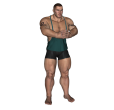 Squat - Sit
Squat - Sit
Benefits: This is a squat using body weight alone.
Purpose: To develop core strength of the lower and middle body.
Beginner Quads Glutes Hamstrings Calves Strength Body Only Push Compound Gym Home
General Info: The quads are a set of four muscles in the upper front thigh. All four muscles work to straighten the knee. One of the four (rectus femoris) also helps to bend the hip. Squats are considered a vital exercise for increasing the strength and size of the legs and butt.
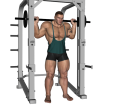 Squat - Smith Machine
Squat - Smith Machine
Benefits: It is the single best exercise to develop full body strength and increase your fat-burning metabolism.
Purpose: To develop core strength of the lower and middle body.
Intermediate Quads Glutes Hamstrings Calves Lower Back Strength Smith Machine Push Compound Gym
General Info: The quads are a set of four muscles in the upper front thigh. All four muscles work to straighten the knee. One of the four (rectus femoris) also helps to bend the hip. Squats are considered a vital exercise for increasing the strength and size of the legs and butt.
 Squat - Smith Machine Frog
Squat - Smith Machine Frog
Benefits: It is the single best exercise to develop full body strength and increase your fat-burning metabolism.
Purpose: To develop core strength of the lower and middle body.
Intermediate Quads Glutes Hamstrings Calves Lower Back Strength Smith Machine Push Compound Gym
General Info: The quads are a set of four muscles in the upper front thigh. All four muscles work to straighten the knee. One of the four (rectus femoris) also helps to bend the hip. Squats are considered a vital exercise for increasing the strength and size of the legs and butt.
 Squat - Smith Machine Kneeling
Squat - Smith Machine Kneeling
Benefits: It is the single best exercise to develop full body strength and increase your fat-burning metabolism.
Purpose: To develop core strength of the lower and middle body.
Intermediate Quads Glutes Hamstrings Calves Lower Back Strength Smith Machine Push Compound Gym
General Info: The quads are a set of four muscles in the upper front thigh. All four muscles work to straighten the knee. One of the four (rectus femoris) also helps to bend the hip. Squats are considered a vital exercise for increasing the strength and size of the legs and butt.
 Squat - Smith Machine Single Leg
Squat - Smith Machine Single Leg
Benefits: It is the single best exercise to develop full body strength and increase your fat-burning metabolism.
Purpose: To develop core strength of the lower and middle body.
Intermediate Quads Glutes Hamstrings Calves Lower Back Strength Smith Machine Push Compound Gym
General Info: The quads are a set of four muscles in the upper front thigh. All four muscles work to straighten the knee. One of the four (rectus femoris) also helps to bend the hip. Squats are considered a vital exercise for increasing the strength and size of the legs and butt.
 Squat - Smith Machine Single Leg Deep
Squat - Smith Machine Single Leg Deep
Benefits: It is the single best exercise to develop full body strength and increase your fat-burning metabolism.
Purpose: To develop core strength of the lower and middle body.
Intermediate Quads Glutes Hamstrings Calves Lower Back Strength Smith Machine Push Compound Gym
General Info: The quads are a set of four muscles in the upper front thigh. All four muscles work to straighten the knee. One of the four (rectus femoris) also helps to bend the hip. Squats are considered a vital exercise for increasing the strength and size of the legs and butt.
 Squat - Smith Single Leg Split
Squat - Smith Single Leg Split
Benefits: It is the single best exercise to develop full body strength and increase your fat-burning metabolism.
Purpose: To develop core strength of the lower and middle body.
Intermediate Quads Glutes Hamstrings Calves Lower Back Strength Smith Machine Flat Bench Push Compound Gym
General Info: The quads are a set of four muscles in the upper front thigh. All four muscles work to straighten the knee. One of the four (rectus femoris) also helps to bend the hip. Squats are considered a vital exercise for increasing the strength and size of the legs and butt.
 Squat - Speed
Squat - Speed
Benefits: It is the single best exercise to develop full body strength and increase your fat-burning metabolism.
Purpose: To develop core strength of the lower and middle body.
Quads Glutes Hamstrings Calves Lower Back Strength Barbell Squat Rack Push Compound Gym
General Info: The quads are a set of four muscles in the upper front thigh. All four muscles work to straighten the knee. One of the four (rectus femoris) also helps to bend the hip. Squats are considered a vital exercise for increasing the strength and size of the legs and butt.
 Squat - Split
Squat - Split
Benefits: It is the single best exercise to develop full body strength and increase your fat-burning metabolism.
Purpose: To develop core strength of the lower and middle body.
Intermediate Quads Glutes Hamstrings Calves Lower Back Strength Barbell Squat Rack Push Compound Gym
General Info: The quads are a set of four muscles in the upper front thigh. All four muscles work to straighten the knee. One of the four (rectus femoris) also helps to bend the hip. Squats are considered a vital exercise for increasing the strength and size of the legs and butt.
 Squat - Water Bottle
Squat - Water Bottle
Benefits: It is the single best exercise to develop full body strength and increase your fat-burning metabolism.
Purpose: To develop core strength of the lower and middle body.
Intermediate Quads Glutes Hamstrings Calves Lower Back Strength Water Bottle Push Compound Home
General Info: The quads are a set of four muscles in the upper front thigh. All four muscles work to straighten the knee. One of the four (rectus femoris) also helps to bend the hip. Squats are considered a vital exercise for increasing the strength and size of the legs and butt.
 Squat - Water Bottle Bulgarian
Squat - Water Bottle Bulgarian
Benefits: It is the single best exercise to develop full body strength and increase your fat-burning metabolism.
Purpose: To develop core strength of the lower and middle body.
Intermediate Quads Glutes Hamstrings Calves Lower Back Strength Water Bottle Chair Push Compound Home
General Info: The quads are a set of four muscles in the upper front thigh. All four muscles work to straighten the knee. One of the four (rectus femoris) also helps to bend the hip. Squats are considered a vital exercise for increasing the strength and size of the legs and butt.
 Squat - Water Bottle Bulgarian Deep
Squat - Water Bottle Bulgarian Deep
Benefits: It is the single best exercise to develop full body strength and increase your fat-burning metabolism.
Purpose: To develop core strength of the lower and middle body.
Intermediate Quads Glutes Hamstrings Calves Lower Back Strength Water Bottle Chair Push Compound Home
General Info: The quads are a set of four muscles in the upper front thigh. All four muscles work to straighten the knee. One of the four (rectus femoris) also helps to bend the hip. Squats are considered a vital exercise for increasing the strength and size of the legs and butt.
 Squat - Water Bottle Close Stance
Squat - Water Bottle Close Stance
Benefits: It is the single best exercise to develop full body strength and increase your fat-burning metabolism.
Purpose: To develop core strength of the lower and middle body.
Intermediate Quads Glutes Hamstrings Calves Lower Back Strength Water Bottle Push Compound Home
General Info: The quads are a set of four muscles in the upper front thigh. All four muscles work to straighten the knee. One of the four (rectus femoris) also helps to bend the hip. Squats are considered a vital exercise for increasing the strength and size of the legs and butt.
 Squat - Water Bottle Deep
Squat - Water Bottle Deep
Benefits: It is the single best exercise to develop full body strength and increase your fat-burning metabolism.
Purpose: To develop core strength of the lower and middle body.
Intermediate Quads Glutes Hamstrings Calves Lower Back Strength Water Bottle Push Compound Home
General Info: The quads are a set of four muscles in the upper front thigh. All four muscles work to straighten the knee. One of the four (rectus femoris) also helps to bend the hip. Squats are considered a vital exercise for increasing the strength and size of the legs and butt.
 Squat - Water Bottle Frog
Squat - Water Bottle Frog
Benefits: It is the single best exercise to develop full body strength and increase your fat-burning metabolism.
Purpose: To develop core strength of the lower and middle body.
Intermediate Quads Glutes Hamstrings Calves Lower Back Strength Water Bottle Push Compound Home
General Info: The quads are a set of four muscles in the upper front thigh. All four muscles work to straighten the knee. One of the four (rectus femoris) also helps to bend the hip. Squats are considered a vital exercise for increasing the strength and size of the legs and butt.
 Squat - Water Bottle Kneeling
Squat - Water Bottle Kneeling
Benefits: It is the single best exercise to develop full body strength and increase your fat-burning metabolism.
Purpose: To develop core strength of the lower and middle body.
Intermediate Quads Glutes Hamstrings Calves Lower Back Strength Water Bottle Push Compound Home
General Info: The quads are a set of four muscles in the upper front thigh. All four muscles work to straighten the knee. One of the four (rectus femoris) also helps to bend the hip. Squats are considered a vital exercise for increasing the strength and size of the legs and butt.
 Squat - Water Bottle Wall
Squat - Water Bottle Wall
Benefits: It is the single best exercise to develop full body strength and increase your fat-burning metabolism.
Purpose: To develop core strength of the lower and middle body.
Intermediate Quads Glutes Hamstrings Calves Lower Back Strength Water Bottle Push Compound Home
General Info: The quads are a set of four muscles in the upper front thigh. All four muscles work to straighten the knee. One of the four (rectus femoris) also helps to bend the hip. Squats are considered a vital exercise for increasing the strength and size of the legs and butt.
 Squat - Water Bottle Wall Close
Squat - Water Bottle Wall Close
Benefits: It is the single best exercise to develop full body strength and increase your fat-burning metabolism.
Purpose: To develop core strength of the lower and middle body.
Intermediate Quads Glutes Hamstrings Calves Lower Back Strength Water Bottle Push Compound Home
General Info: The quads are a set of four muscles in the upper front thigh. All four muscles work to straighten the knee. One of the four (rectus femoris) also helps to bend the hip. Squats are considered a vital exercise for increasing the strength and size of the legs and butt.
 Squat - Water Bottle Wall Out
Squat - Water Bottle Wall Out
Benefits: It is the single best exercise to develop full body strength and increase your fat-burning metabolism.
Purpose: To develop core strength of the lower and middle body.
Intermediate Quads Glutes Hamstrings Calves Lower Back Strength Water Bottle Push Compound Home
General Info: The quads are a set of four muscles in the upper front thigh. All four muscles work to straighten the knee. One of the four (rectus femoris) also helps to bend the hip. Squats are considered a vital exercise for increasing the strength and size of the legs and butt.
 Squat - Water Bottle Wall Out Close
Squat - Water Bottle Wall Out Close
Benefits: It is the single best exercise to develop full body strength and increase your fat-burning metabolism.
Purpose: To develop core strength of the lower and middle body.
Intermediate Quads Glutes Hamstrings Calves Lower Back Strength Water Bottle Push Compound Home
General Info: The quads are a set of four muscles in the upper front thigh. All four muscles work to straighten the knee. One of the four (rectus femoris) also helps to bend the hip. Squats are considered a vital exercise for increasing the strength and size of the legs and butt.
 Squat - Weighted
Squat - Weighted
Benefits: It is the single best exercise to develop full body strength and increase your fat-burning metabolism.
Purpose: To develop core strength of the lower and middle body.
Intermediate Quads Glutes Hamstrings Calves Lower Back Strength Plate Chains Flat Bench Push Compound Gym
General Info: The quads are a set of four muscles in the upper front thigh. All four muscles work to straighten the knee. One of the four (rectus femoris) also helps to bend the hip. Squats are considered a vital exercise for increasing the strength and size of the legs and butt.
 Squat - Wide Stance Barbell
Squat - Wide Stance Barbell
Benefits: It is the single best exercise to develop full body strength and increase your fat-burning metabolism.
Purpose: To develop core strength of the lower and middle body.
Intermediate Quads Glutes Hamstrings Calves Lower Back Strength Barbell Squat Rack Push Compound Gym
General Info: The quads are a set of four muscles in the upper front thigh. All four muscles work to straighten the knee. One of the four (rectus femoris) also helps to bend the hip. Squats are considered a vital exercise for increasing the strength and size of the legs and butt.
 Squat - With Bands
Squat - With Bands
Benefits: It is the single best exercise to develop full body strength and increase your fat-burning metabolism.
Purpose: To develop core strength of the lower and middle body.
Beginner Quads Glutes Hamstrings Calves Lower Back Strength Band Push Compound Gym
General Info: The quads are a set of four muscles in the upper front thigh. All four muscles work to straighten the knee. One of the four (rectus femoris) also helps to bend the hip. Squats are considered a vital exercise for increasing the strength and size of the legs and butt.
 Squat - With Chains
Squat - With Chains
Benefits: This exercise is done with the addition of chains. The primary function of chains is to accommodate resistance. Chains are also a great means of weight loading (adding more weight to an exercise). Chains are also a great way for working the stabilizers.
Purpose: Benefits It is the single best exercise to develop full body strength and increase your fat-burning metabolism.
Intermediate Quads Glutes Hamstrings Calves Lower Back Strength Barbell Chains Squat Rack Push Compound Gym
General Info: The quads are a set of four muscles in the upper front thigh. All four muscles work to straighten the knee. One of the four (rectus femoris) also helps to bend the hip. Squats are considered a vital exercise for increasing the strength and size of the legs and butt.
 Squat - Zercher
Squat - Zercher
Benefits: It is the single best exercise to develop full body strength and increase your fat-burning metabolism.
Purpose: To develop core strength of the lower and middle body.
Quads Glutes Hamstrings Calves Lower Back Strength Barbell Squat Rack Push Compound Gym
General Info: The quads are a set of four muscles in the upper front thigh. All four muscles work to straighten the knee. One of the four (rectus femoris) also helps to bend the hip. Squats are considered a vital exercise for increasing the strength and size of the legs and butt.
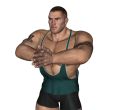 Squeeze - Iso Chest
Squeeze - Iso Chest
Benefits: This exercise contracts the chest muscles.
Purpose: This exercise is used to contract the chest muscles using isometrics.
Beginner Chest Triceps Anterior Shoulders Body Only Gym Home
General Info: The chest is composed of the Pectoralis Major and the Pectoralis Minor. The Pec Major attaches to the upper arm and pulls the upper arm across the chest. The Pec Minor lies mostly underneath the Pec Major and draws the shoulder blade down and forward.
 Squeeze - Standing Olympic Plate Hand
Squeeze - Standing Olympic Plate Hand
Benefits: This exercise focuses on finger gripping and strength.
Purpose: This exercise strengthens the forearm muscles as well as finger strength.
Intermediate Forearms Fingers Strength Plate Gym
General Info: A complete forearm program must achieve balanced development for all major forearm muscles. The forearm is involved in six different forearm movements. They include wrist flexion, wrist extension, wrist abduction, wrist adduction, forearm pronation, and forearm supination. There are additional muscles found in the forearm that are involved in movements like elbow flexion (brachioradialis), finger flexion, and finger extension.
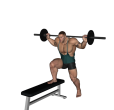 Step Up - Barbell Bench
Step Up - Barbell Bench
Benefits: It is a good exercise to tone and shape the thigh.
Purpose: This exercise tones and shapes the quads.
Intermediate Quads Glutes Hamstrings Calves Strength Barbell Flat Bench Push Compound Gym
General Info: The quads are a set of four muscles in the upper front thigh. All four muscles work to straighten the knee. One of the four (rectus femoris) also helps to bend the hip. Squats are considered a vital exercise for increasing the strength and size of the legs and butt.
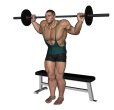 Step Up - Barbell Bench Alternate
Step Up - Barbell Bench Alternate
Benefits: It is a good exercise to tone and shape the thigh.
Purpose: This exercise tones and shapes the quads.
Intermediate Quads Glutes Hamstrings Calves Strength Barbell Flat Bench Push Compound Gym
General Info: The quads are a set of four muscles in the upper front thigh. All four muscles work to straighten the knee. One of the four (rectus femoris) also helps to bend the hip. Squats are considered a vital exercise for increasing the strength and size of the legs and butt.
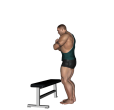 Step Up - Bench
Step Up - Bench
Benefits: It is a good exercise to tone and shape the thigh.
Purpose: This exercise tones and shapes the quads.
Beginner Quads Glutes Hamstrings Calves Strength Flat Bench Compound Gym
General Info: The quads are a set of four muscles in the upper front thigh. All four muscles work to straighten the knee. One of the four (rectus femoris) also helps to bend the hip. Squats are considered a vital exercise for increasing the strength and size of the legs and butt.
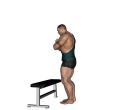 Step Up - Bench Alternate
Step Up - Bench Alternate
Benefits: It is a good exercise to tone and shape the thigh.
Purpose: This exercise tones and shapes the quads.
Beginner Quads Glutes Hamstrings Calves Strength Flat Bench Compound Gym
General Info: The quads are a set of four muscles in the upper front thigh. All four muscles work to straighten the knee. One of the four (rectus femoris) also helps to bend the hip. Squats are considered a vital exercise for increasing the strength and size of the legs and butt.
 Step Up - Dumbbell
Step Up - Dumbbell
Benefits: It is a good exercise to tone and shape the thigh.
Purpose: This exercise tones and shapes the quads.
Beginner Quads Glutes Hamstrings Calves Strength Dumbbell Flat Bench Push Compound Gym
General Info: The quads are a set of four muscles in the upper front thigh. All four muscles work to straighten the knee. One of the four (rectus femoris) also helps to bend the hip. Squats are considered a vital exercise for increasing the strength and size of the legs and butt.
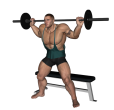 Step Up - Dumbbell Bench Alternate
Step Up - Dumbbell Bench Alternate
Benefits: It is a good exercise to tone and shape the thigh.
Purpose: This exercise tones and shapes the quads.
Intermediate Quads Glutes Hamstrings Calves Strength Dumbbell Flat Bench Push Compound Gym
General Info: The quads are a set of four muscles in the upper front thigh. All four muscles work to straighten the knee. One of the four (rectus femoris) also helps to bend the hip. Squats are considered a vital exercise for increasing the strength and size of the legs and butt.
 Step Up - With Chains
Step Up - With Chains
Benefits: This exercise is done with the addition of chains. The primary function of chains is to accommodate resistance. Chains are also a great means of weight loading (adding more weight to an exercise). Chains are also a great way for working the stabilizers.
Purpose: Benefits It is a good exercise to tone and shape the thigh.
Beginner Quads Glutes Hamstrings Calves Strength Chains Flat Bench Push Compound Gym
General Info: The quads are a set of four muscles in the upper front thigh. All four muscles work to straighten the knee. One of the four (rectus femoris) also helps to bend the hip. Squats are considered a vital exercise for increasing the strength and size of the legs and butt.
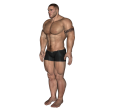 Stomach Vacuum - Fundamental
Stomach Vacuum - Fundamental
Benefits: The stomach vacuum is essential for toned, six-pack abs.
Purpose: This exercise helps contract the stomach muscles.
Beginner Abdominals Stretching Body Only Gym Home
General Info: The abdominals consist of the abs and the obliques. The obliques and upper abs are both involved in to movements to the side. Barbell side bend exercises are simple enough that virtually anyone can use this technique safely and easily, either at home or at the gym.
 Stretch - Band And Glute
Stretch - Band And Glute
Benefits: This is a good exercise for strengthening the muscles for raising the legs to the sides.
Purpose: This exercise is a controlled, balanced inner hip exercise for abducting the hip.
Intermediate Hip Abductors Glutes Stretching Band Gym
General Info: There are four groups of muscles that cause movement in the hip joint. They include the gluteal group, the lateral rotator group, the adductor group, and the iliopsoas group. The prime group for hip adduction is, obviously, the adductor group, a group of muscles on the inner hip joint.
 Stretch - Basic
Stretch - Basic
Benefits: This exercise works both heads of the biceps.
Purpose: This exercise is used to target the biceps muscle to develop flexibility.
Biceps Shoulders Stretching Body Only Gym Home
General Info: The biceps is a straight muscle with two heads. The long head of the biceps crosses both the elbow and the shoulder joint. It bends the elbow and raises the arm forward at the shoulder. The short head crosses the elbow joint and, in conjunction with the brachioradialis, supinates the hand.
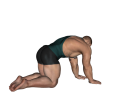 Stretch - Cat
Stretch - Cat
Benefits: This exercise will also work the traps in addition to the lower back.
Purpose: This exercise stretches the lower back muscles.
Beginner Lower Back Traps Strength Body Only Gym Home
General Info: The muscles of the lower back straighten the spine. They work together with the abdominals to keep the spine upright. The spine plays a big role in overall health, so the lower back is one of the most important muscle groups in the body.
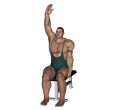 Stretch - Chair Lower Back
Stretch - Chair Lower Back
Benefits: This exercise will also work the traps in addition to the lower back.
Purpose: This exercise stretches the lower back muscles.
Beginner Lower Back Traps Strength Flat Bench Gym Home
General Info: The muscles of the lower back straighten the spine. They work together with the abdominals to keep the spine upright. The spine plays a big role in overall health, so the lower back is one of the most important muscle groups in the body.
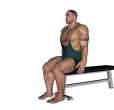 Stretch - Chair Upper Body
Stretch - Chair Upper Body
Benefits: This exercise will also work the traps and lats.
Purpose: This exercise stretches the lower back muscles.
Beginner Upper Back Shoulders Strength Flat Bench Gym Home
General Info: The muscles of the lower back straighten the spine. They work together with the abdominals to keep the spine upright. The spine plays a big role in overall health, so the lower back is one of the most important muscle groups in the body.
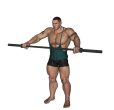 Stretch - Chest And Front Shoulder
Stretch - Chest And Front Shoulder
Benefits: This exercise stretches the chest and anterior delts.
Purpose: This exercise is used to stretch the chest muscles.
Beginner Chest Anterior Shoulders Strength Barbell Gym
General Info: The chest is composed of the Pectoralis Major and the Pectoralis Minor. The Pec Major attaches to the upper arm and pulls the upper arm across the chest. The Pec Minor lies mostly underneath the Pec Major and draws the shoulder blade down and forward.
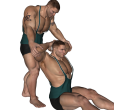 Stretch - Chest Behind Head
Stretch - Chest Behind Head
Benefits: This exercise ensures that your chest muscles are ready for lifting exercises.
Purpose: This exercise loosens up and stretches the chest muscles.
Intermediate Chest Shoulders Stretching Body Only Gym
General Info: The Pecs play a big part, with the Biceps, when you lift any object, from shopping bags to dumbbells. These muscles are often injured during lifting exercises.
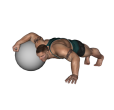 Stretch - Chest On Stability Ball
Stretch - Chest On Stability Ball
Benefits: This exercise stretches the chest and anterior delts.
Purpose: This exercise is used to stretch the chest muscles.
Beginner Chest Strength Fitness Ball Gym
General Info: The chest is composed of the Pectoralis Major and the Pectoralis Minor. The Pec Major attaches to the upper arm and pulls the upper arm across the chest. The Pec Minor lies mostly underneath the Pec Major and draws the shoulder blade down and forward.
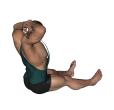 Stretch - Chin To Chest
Stretch - Chin To Chest
Benefits: The primary advantage to a strong neck is that it helps align the rest of your body. Neck exercises are often overlooked by gym goers, so it's important to create awareness around simple neck isometric exercises like these.
Purpose: This exercise tones and strengthens the neck muscles.
Beginner Neck Body Only Push Gym Home
General Info: The neck muscles are responsible for holding your head up. The motion of the neck can be divided into rotation (looking side to side), lateral flexion (ear to shoulder), flexion (chin to sternum) and hyperextension (looking up). The most common neck injury is whiplash. Another common neck problem is limited rotation.
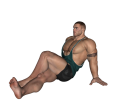 Stretch - Dancers
Stretch - Dancers
Benefits: This exercise will also work the abs in addition to the lower back.
Purpose: This exercise strengthens the lower back muscles.
Beginner Lower Back Obliques Strength Body Only Gym Home
General Info: The muscles of the lower back straighten the spine. They work together with the abdominals to keep the spine upright. The spine plays a big role in overall health, so the lower back is one of the most important muscle groups in the body.
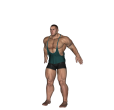 Stretch - Dynamic Back
Stretch - Dynamic Back
Benefits: This exercise isolates the upper back muscles.
Purpose: This exercise strengthens the upper back and shoulder areas.
Beginner Lats Shoulders Traps Strength Body Only Gym Home
General Info: The posterior (rear) deltoid or shoulder is one of the three distinct heads of the deltoid anatomy. It is typically used in tandem with the back muscles during upper body pulling exercises.
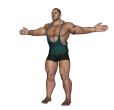 Stretch - Dynamic Chest
Stretch - Dynamic Chest
Benefits: Bands can be used to increase strength speed.
Purpose: This exercise increases strength and strength speed.
Beginner Chest Middle Back Stretching Body Only Gym Home
General Info: The chest is composed of the Pectoralis Major and the Pectoralis Minor. The Pec Major attaches to the upper arm and pulls the upper arm across the chest. The Pec Minor lies mostly underneath the Pec Major and draws the shoulder blade down and forward.
 Stretch - Elbows Back
Stretch - Elbows Back
Benefits: This exercise stretches the chest and anterior delts.
Purpose: This exercise is used to stretch the chest muscles.
Beginner Chest Stretching Body Only Gym
General Info: The chest is composed of the Pectoralis Major and the Pectoralis Minor. The Pec Major attaches to the upper arm and pulls the upper arm across the chest. The Pec Minor lies mostly underneath the Pec Major and draws the shoulder blade down and forward.
 Stretch - Gastrocnemius Standing
Stretch - Gastrocnemius Standing
Benefits: This exercise is one of the few that works primarily the gastrocnemius and the upper calf.
Purpose: This exercise works the calf muscle, specifically the gastrocnemius.
Beginner Calves Hamstrings Stretching Flat Bench Gym Home
General Info: The calf consists of 2 major muscles (gastrocnemius and soleus). There are also a number of tendons, such as the Achilles tendon. Seated calf raises focus mainly on the soleus and the tendons in the lower calf.
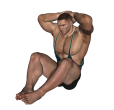 Stretch - Groin and Back
Stretch - Groin and Back
Benefits: This is a good exercise for strengthening the muscles for raising the legs to the sides.
Purpose: This exercise is a controlled, balanced inner hip exercise for abducting the hip.
Intermediate Adductors Stretching Body Only Compound Gym
General Info: There are four groups of muscles that cause movement in the hip joint. They include the gluteal group, the lateral rotator group, the adductor group, and the iliopsoas group. The prime group for hip adduction is, obviously, the adductor group, a group of muscles on the inner hip joint.
 Stretch - Hamstring
Stretch - Hamstring
Benefits: A major problem with many athletes who use their legs (such as runners, footballers, ice skaters) is the hamstring injury. This exercise is a core stretch for the hamstrings which will help reduce this type of injury.
Purpose: This exercise provides flexibility and mobility of the hamstrings.
Beginner Hamstrings Hip Extensors Stretching Band Gym
General Info: The Hamstring muscles group are responsible for bending the knee. Some members of this group also straighten the hip (hip extensors). They are located on the back of the thigh.
 Stretch - Intermediate Groin
Stretch - Intermediate Groin
Benefits: A major problem with many athletes who use their legs (such as runners, footballers, ice skaters) is the hamstring injury. This exercise is a core stretch for the hamstrings which will help reduce this type of injury.
Purpose: This exercise provides flexibility and mobility of the hamstrings.
Intermediate Hamstrings Hip Extensors Stretching Band Gym
General Info: The Hamstring muscles group are responsible for bending the knee. Some members of this group also straighten the hip (hip extensors). They are located on the back of the thigh.
 Stretch - Intermediate Hip Flexor and Quad
Stretch - Intermediate Hip Flexor and Quad
Benefits: It is a good exercise to tone and shape the thigh.
Purpose: This exercise tones and shapes the quads.
Intermediate Quads Hip Flexors Stretching Band Compound Gym
General Info: The quads are a set of four muscles in the upper front thigh. All four muscles work to straighten the knee. One of the four (rectus femoris) also helps to bend the hip. Squats are considered a vital exercise for increasing the strength and size of the legs and butt.
 Stretch - Iron Cross
Stretch - Iron Cross
Benefits: It is a good exercise to tone and shape the thigh.
Purpose: This exercise tones and shapes the quads.
Intermediate Quads Hip Flexors Stretching Body Only Compound Gym
General Info: The quads are a set of four muscles in the upper front thigh. All four muscles work to straighten the knee. One of the four (rectus femoris) also helps to bend the hip. Squats are considered a vital exercise for increasing the strength and size of the legs and butt.
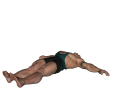 Stretch - Knee Across Body
Stretch - Knee Across Body
Benefits: This is a good exercise for core glute muscle development.
Purpose: This exercise is a controlled, balanced glute exercise for building tone and shape.
Beginner Glutes Lower Back Upper Leg Stretching Body Only Gym Home
General Info: The glutes consist of the gluteus maximus, gluteus medius, and gluteus minimus. They create hip joint motion to lift the thigh forward, lift the thigh to the side, rotate the leg inward, and rotate the thigh outward.
 Stretch - Looking At Ceiling
Stretch - Looking At Ceiling
Benefits: This is a squat using body weight alone.
Purpose: To develop core strength of the lower and middle body.
Beginner Quads Stretching Body Only Gym Home
General Info: The quads are a set of four muscles in the upper front thigh. All four muscles work to straighten the knee. One of the four (rectus femoris) also helps to bend the hip. Squats are considered a vital exercise for increasing the strength and size of the legs and butt.
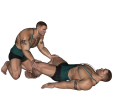 Stretch - Lying Bent Leg Groin
Stretch - Lying Bent Leg Groin
Benefits: This is a good exercise for strengthening the muscles for raising the legs to the sides.
Purpose: This exercise is a controlled, balanced inner hip exercise for abducting the hip.
Adductors Stretching Body Only Gym
General Info: There are four groups of muscles that cause movement in the hip joint. They include the gluteal group, the lateral rotator group, the adductor group, and the iliopsoas group. The prime group for hip adduction is, obviously, the adductor group, a group of muscles on the inner hip joint.
 Stretch - Lying Crossover
Stretch - Lying Crossover
Benefits: This is a good exercise for strengthening the muscles for raising the legs to the sides.
Purpose: This exercise is a controlled, balanced inner hip exercise for abducting the hip.
Abductors Stretching Body Only Gym
General Info: There are four groups of muscles that cause movement in the hip joint. They include the gluteal group, the lateral rotator group, the adductor group, and the iliopsoas group. The prime group for hip adduction is, obviously, the adductor group, a group of muscles on the inner hip joint.
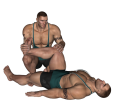 Stretch - Lying Glute
Stretch - Lying Glute
Benefits: This is a good exercise for core glute muscle development.
Purpose: This exercise is a controlled, balanced glute exercise for building tone and shape.
Glutes Abductors Stretching Body Only Gym
General Info: The glutes consist of the gluteus maximus, gluteus medius, and gluteus minimus. They create hip joint motion to lift the thigh forward, lift the thigh to the side, rotate the leg inward, and rotate the thigh outward.
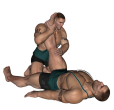 Stretch - Lying Hamstring
Stretch - Lying Hamstring
Benefits: A major problem with many athletes who use their legs (such as runners, footballers, ice skaters) is the hamstring injury. This exercise is a core stretch for the hamstrings which will help reduce this type of injury.
Purpose: This exercise provides flexibility and mobility of the hamstrings.
Hamstrings Hip Extensors Calves Stretching Body Only Gym
General Info: The Hamstring muscles group are responsible for bending the knee. Some members of this group also straighten the hip (hip extensors). They are located on the back of the thigh.
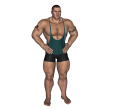 Stretch - Middle Back
Stretch - Middle Back
Benefits: This exercise is an effective exercise for the middle back.
Purpose: This is a good exercise for increasing strength and flexibility in the middle back.
Beginner Middle Back Stretching Body Only Gym Home
General Info: There are a number of muscles in the back, although the two major muscles are the lats and traps. The lats pulls the arm back and down towards the spine. The traps pull the shoulder blades back and towards the spine.
 Stretch - One Arm Against Wall
Stretch - One Arm Against Wall
Benefits: This exercise is an effective for flexibility of the lats.
Purpose: This is a good exercise for flexibility in the upper back.
Beginner Lats Traps Posterior Delts Stretching Body Only Gym Home
General Info: There are a number of muscles in the back, although the two major muscles are the lats and traps. The lats pulls the arm back and down towards the spine. The traps pull the shoulder blades back and towards the spine.
 Stretch - One Half Locust
Stretch - One Half Locust
Benefits: This is a squat using body weight alone.
Purpose: To develop core strength of the lower and middle body.
Beginner Quads Chest Stretching Body Only Gym Home
General Info: The quads are a set of four muscles in the upper front thigh. All four muscles work to straighten the knee. One of the four (rectus femoris) also helps to bend the hip. Squats are considered a vital exercise for increasing the strength and size of the legs and butt.
 Stretch - One Knee To Chest
Stretch - One Knee To Chest
Benefits: This is a good exercise for core glute muscle development.
Purpose: This exercise is a controlled, balanced glute exercise for building tone and shape.
Beginner Glutes Hip Flexors Stretching Body Only Gym
General Info: The glutes consist of the gluteus maximus, gluteus medius, and gluteus minimus. They create hip joint motion to lift the thigh forward, lift the thigh to the side, rotate the leg inward, and rotate the thigh outward.
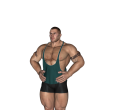 Stretch - Overhead
Stretch - Overhead
Benefits: This exercise is good after sitting at a desk or computer for any extended time. It is also good both before and after resistance exercising.
Purpose: This exercise loosens up and stretches the shoulder muscles. It also relieves tension in the chest and lats.
Intermediate Shoulders Chest Forearms Lats Triceps Stretching Body Only Gym Home
General Info: The shoulder muscles are a group of three muscles. The anterior (front) deltoid raises the arm toward the front and rotates the arm inward. The lateral (side) deltoid raises the arm to the side. The posterior (back) deltoid raises the arm toward the rear and rotates the arm outward.
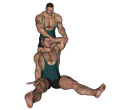 Stretch - Overhead Lat
Stretch - Overhead Lat
Benefits: This exercise is an effective for flexibility of the lats.
Purpose: This is a good exercise for flexibility in the upper back.
Lats Triceps Stretching Body Only Gym Home
General Info: There are a number of muscles in the back, although the two major muscles are the lats and traps. The lats pulls the arm back and down towards the spine. The traps pull the shoulder blades back and towards the spine.
 Stretch - Overhead Triceps
Stretch - Overhead Triceps
Benefits: This exercise works all heads of the triceps.
Purpose: This exercise is used to target the triceps muscle to develop size, definition, strength, endurance and power.
Triceps Lats Stretching Body Only Gym
General Info: The triceps muscles are straight muscles with three heads. All three heads straighten the elbow while the long head, crossing the shoulder joint also adducts the shoulder (pulls it down from the side) and extends the shoulder (pulls it down from the front).
 Stretch - Pelvic Tilt
Stretch - Pelvic Tilt
Benefits: This exercise will give you more body awareness, especially of the lower back.
Purpose: This exercise strengthens the lower abdominal muscles and stretches the lower back.
Intermediate Abdominals Lower Back Glutes Stretching Body Only Gym Home
General Info: The abs can be divided into the abdominals themselves and the obliques. The obliques are the outer abs and are used in twisting movements. For the sake of exercising, the abdominals are sometimes divided into upper abs and lower abs (this is not a technical division but something for exercising). Both upper and lower abs are used in straight line ab exercises while the upper abs are also involved in twisting movements.
 Stretch - Pyramid
Stretch - Pyramid
Benefits: This helps develop stabilizing strength in your torso and shoulders.
Purpose: This exercise is used to stretch the lower back.
Beginner Lower Back Stretching Fitness Ball Gym Home
General Info: The muscles of the lower back straighten the spine. They work together with the abdominals to keep the spine upright. Good Mornings places a lot of stress on the lower back.
 Stretch - Quad
Stretch - Quad
Benefits: It is the single best exercise to develop full body strength and increase your fat-burning metabolism.
Purpose: To develop core strength of the lower and middle body.
Intermediate Quads Stretching Band Gym Home
General Info: The quads are a set of four muscles in the upper front thigh. All four muscles work to straighten the knee. One of the four (rectus femoris) also helps to bend the hip. Squats are considered a vital exercise for increasing the strength and size of the legs and butt.
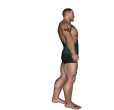 Stretch - Runners
Stretch - Runners
Benefits: This exercise tones and tightens your hamstrings with some involvement of the calves.
Purpose: This exercise focuses on working the hamstrings and makes an excellent warm-up before any resistance or weight training involving the rear thigh muscles.
Beginner Hamstrings Calves Stretching Body Only Gym Home
General Info: The hamstring muscles are responsible for bending the knee. Some members of the hamstrings also straighten the hip (bring the leg down from a front position).
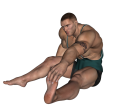 Stretch - Seated Calf
Stretch - Seated Calf
Benefits: This exercise is one of the few that works primarily the gastrocnemius and the upper calf.
Purpose: This exercise stretches the calf muscle, specifically the gastrocnemius.
Beginner Calves Lower Back Stretching Band Gym Home
General Info: The calf consists of 2 major muscles (gastrocnemius and soleus). There are also a number of tendons, such as the Achilles tendon. Seated calf raises focus mainly on the soleus and the tendons in the lower calf.
 Stretch - Seated Front Deltoid
Stretch - Seated Front Deltoid
Benefits: This exercise isolates the anterior delt muscle.
Purpose: This exercise stretches the front deltoid muscle area.
Anterior Delts Chest Stretching Body Only Gym
General Info: The anterior (front) deltoid or shoulder is one of the three distinct heads of the deltoid anatomy. It raises the arm toward the front and rotates the arm inward.
 Stretch - Seated Glute
Stretch - Seated Glute
Benefits: This is a good exercise for core glute muscle development.
Purpose: This exercise is a controlled, balanced glute exercise for building tone and shape.
Glutes Abductors Stretching Body Only Gym
General Info: The glutes consist of the gluteus maximus, gluteus medius, and gluteus minimus. They create hip joint motion to lift the thigh forward, lift the thigh to the side, rotate the leg inward, and rotate the thigh outward.
 Stretch - Seated Hamstring
Stretch - Seated Hamstring
Benefits: A major problem with many athletes who use their legs (such as runners, footballers, ice skaters) is the hamstring injury. This exercise is a core stretch for the hamstrings which will help reduce this type of injury.
Purpose: This exercise provides flexibility and mobility of the hamstrings.
Hamstrings Hip Extensors Calves Stretching Body Only Gym
General Info: The Hamstring muscles group are responsible for bending the knee. Some members of this group also straighten the hip (hip extensors). They are located on the back of the thigh.
 Stretch - Seated Hamstring and Calf
Stretch - Seated Hamstring and Calf
Benefits: A major problem with many athletes who use their legs (such as runners, footballers, ice skaters) is the hamstring injury. This exercise is a core stretch for the hamstrings which will help reduce this type of injury.
Purpose: This exercise provides flexibility and mobility of the hamstrings.
Intermediate Hamstrings Calves Stretching Band Gym Home
General Info: The Hamstring muscles group are responsible for bending the knee. Some members of this group also straighten the hip (hip extensors). They are located on the back of the thigh.
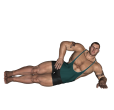 Stretch - Side Bridge
Stretch - Side Bridge
Benefits: This exercise will give you a well-defined mid-section.
Purpose: This exercise strengthen the side abdominal muscles.
Intermediate Obliques Abdominals Stretching Body Only Gym Home
General Info: The abs can be divided into the abdominals themselves and the obliques. The obliques are the outer abs and are used in twisting movements. For the sake of exercising, the abdominals are sometimes divided into upper abs and lower abs (this is not a technical division but something for exercising). Both upper and lower abs are used in straight line ab exercises while the upper abs are also involved in twisting movements.
 Stretch - Side Lying Floor
Stretch - Side Lying Floor
Benefits: This exercise is an effective for flexibility of the lats.
Purpose: This is a good exercise for flexibility in the upper back.
Beginner Lats Stretching Body Only Gym Home
General Info: There are a number of muscles in the back, although the two major muscles are the lats and traps. The lats pulls the arm back and down towards the spine. The traps pull the shoulder blades back and towards the spine.
 Stretch - Side Lying Groin
Stretch - Side Lying Groin
Benefits: This is a good exercise for strengthening the muscles for raising the legs to the sides.
Purpose: This exercise is a controlled, balanced inner hip exercise for abducting the hip.
Intermediate Adductors Hamstrings Stretching Body Only Compound Gym
General Info: There are four groups of muscles that cause movement in the hip joint. They include the gluteal group, the lateral rotator group, the adductor group, and the iliopsoas group. The prime group for hip adduction is, obviously, the adductor group, a group of muscles on the inner hip joint.
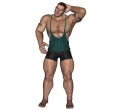 Stretch - Side Neck
Stretch - Side Neck
Benefits: The primary advantage to a strong neck is that it helps align the rest of your body. Neck exercises are often overlooked by gym goers, so it's important to create awareness around simple neck isometric exercises like these.
Purpose: This exercise tones and strengthens the neck muscles.
Beginner Neck Stretching Body Only Gym Home
General Info: The neck muscles are responsible for holding your head up. The motion of the neck can be divided into rotation (looking side to side), lateral flexion (ear to shoulder), flexion (chin to sternum) and hyperextension (looking up). The most common neck injury is whiplash. Another common neck problem is limited rotation.
 Stretch - Spinal
Stretch - Spinal
Benefits: This exercise is an effective exercise for the middle back.
Purpose: This is a good exercise for increasing strength and flexibility in the middle back.
Beginner Middle Back Traps Stretching Chair Gym Home
General Info: There are a number of muscles in the back, although the two major muscles are the lats and traps. The lats pulls the arm back and down towards the spine. The traps pull the shoulder blades back and towards the spine.
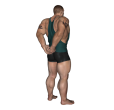 Stretch - Standing Biceps
Stretch - Standing Biceps
Benefits: This exercise helps to relax the biceps.
Purpose: This exercise focuses on working the biceps and makes an excellent warm-up before any resistance or weight training involving the upper arms.
Beginner Biceps Shoulders Stretching Body Only Gym Home
General Info: The standing biceps stretch require little time, yet can give good benefits when done regularly. It can be done almost anywhere, without special equipment. The two heads of the biceps muscles require regular movement to ensure their flexibility and mobility.
 Stretch - Standing Hamstring and Calf
Stretch - Standing Hamstring and Calf
Benefits: A major problem with many athletes who use their legs (such as runners, footballers, ice skaters) is the hamstring injury. This exercise is a core stretch for the hamstrings which will help reduce this type of injury.
Purpose: This exercise provides flexibility and mobility of the hamstrings.
Intermediate Hamstrings Calves Stretching Band Gym
General Info: The Hamstring muscles group are responsible for bending the knee. Some members of this group also straighten the hip (hip extensors). They are located on the back of the thigh.
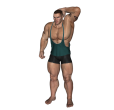 Stretch - Standing Lateral
Stretch - Standing Lateral
Benefits: Lateral stretches are a great way to stretch your oblique muscles, an often forgotten area which is essential for toned, six-pack abs
Purpose: This exercise stretches the oblique muscles (side of the waist).
Beginner Obliques Abdominals Strength Body Only Gym Home
General Info: The abdominals consist of the abs and the obliques. The obliques and upper abs are both involved in to movements to the side. Barbell side bend exercises are simple enough that virtually anyone can use this technique safely and easily, either at home or at the gym.
 Stretch - Standing Toe Touches
Stretch - Standing Toe Touches
Benefits: A major problem with many athletes who use their legs (such as runners, footballers, ice skaters) is the hamstring injury. This exercise is a core stretch for the hamstrings which will help reduce this type of injury.
Purpose: This exercise provides flexibility and mobility of the hamstrings.
Intermediate Hamstrings Calves Stretching Body Only Gym Home
General Info: The Hamstring muscles group are responsible for bending the knee. Some members of this group also straighten the hip (hip extensors). They are located on the back of the thigh.
 Stretch - Torso Rotation
Stretch - Torso Rotation
Benefits: This exercise is an effective exercise for the middle back.
Purpose: This is a good exercise for increasing strength and flexibility in the middle back.
Beginner Middle Back Stretching Fitness Ball Gym Home
General Info: There are a number of muscles in the back, although the two major muscles are the lats and traps. The lats pulls the arm back and down towards the spine. The traps pull the shoulder blades back and towards the spine.
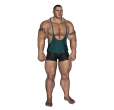 Stretch - Triceps
Stretch - Triceps
Benefits: This exercise helps to relax the triceps.
Purpose: This exercise focuses on stretching the three heads of the triceps and makes an excellent warm-up before any resistance or weight training involving the triceps.
Beginner Triceps Lats Stretching Body Only Gym Home
General Info: The triceps muscles are straight muscles with three heads. All three heads straighten the elbow while the long head, crossing the shoulder joint also adducts the shoulder (pulls it down from the side) and extends the shoulder (pulls it down from the front).
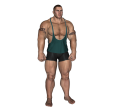 Stretch - Triceps Side
Stretch - Triceps Side
Benefits: This exercise helps to relax the triceps.
Purpose: This exercise focuses on stretching the three heads of the triceps and makes an excellent warm-up before any resistance or weight training involving the triceps.
Beginner Triceps Shoulders Stretching Body Only Gym Home
General Info: The triceps muscles are straight muscles with three heads. All three heads straighten the elbow while the long head, crossing the shoulder joint also adducts the shoulder (pulls it down from the side) and extends the shoulder (pulls it down from the front).
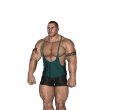 Stretch - Upward
Stretch - Upward
Benefits: This exercise tones and increases the flexibility of your shoulders.
Purpose: This exercise focuses on working the entire shoulder joint and makes an excellent warm-up before any resistance or weight training involving the shoulders.
Beginner Shoulders Lats Stretching Body Only Gym Home
General Info: Shoulder raises require little time, yet can give good benefits when done regularly. They can be done almost anywhere, without special equipment. The three heads of the deltoid muscles require regular movement to ensure their flexibility and mobility.
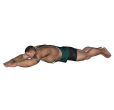 Superman - Fundamental
Superman - Fundamental
Benefits: This exercise will also work the abdominals.
Purpose: This exercise strengthens the lower back muscles.
Beginner Lower Back Abdominals Strength Body Only Gym Home
General Info: The muscles of the lower back straighten the spine. They work together with the abdominals to keep the spine upright. The spine plays a big role in overall health, so the lower back is one of the most important muscle groups in the body.
Could not find your favorite exercise in the list? Please start a discussion and post the name and the list of steps. We will try to add it as soon as we can.